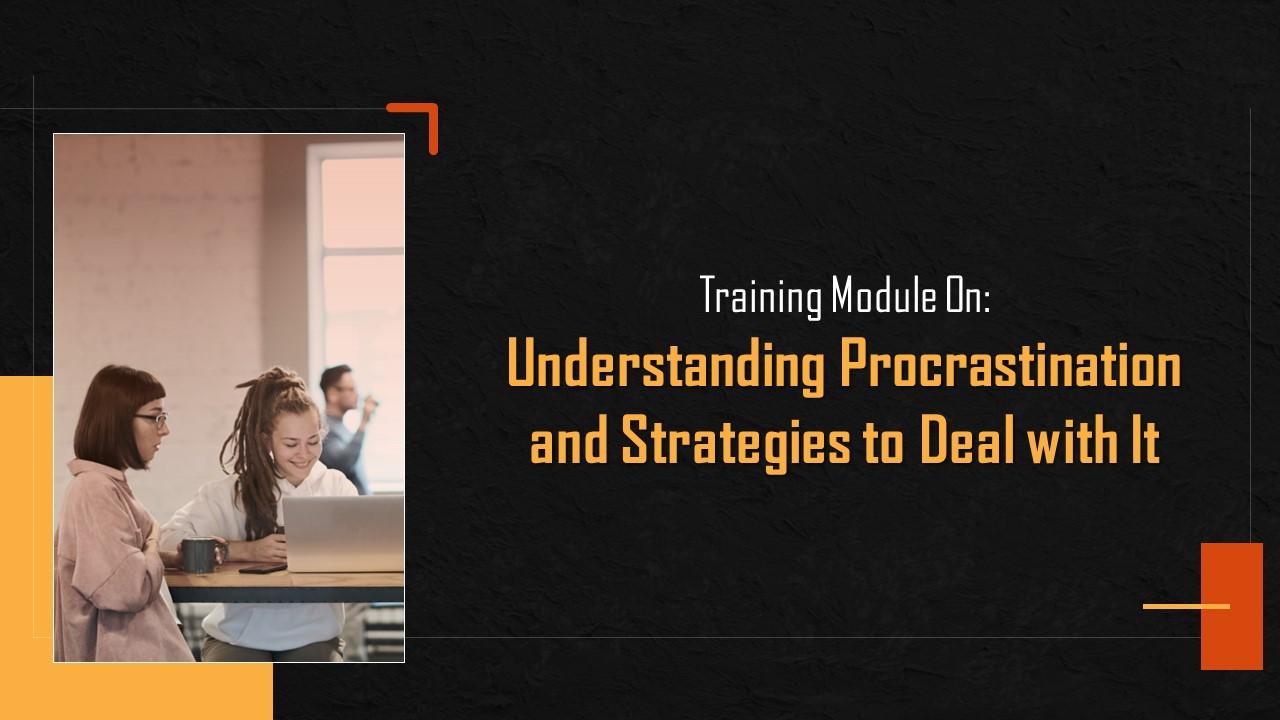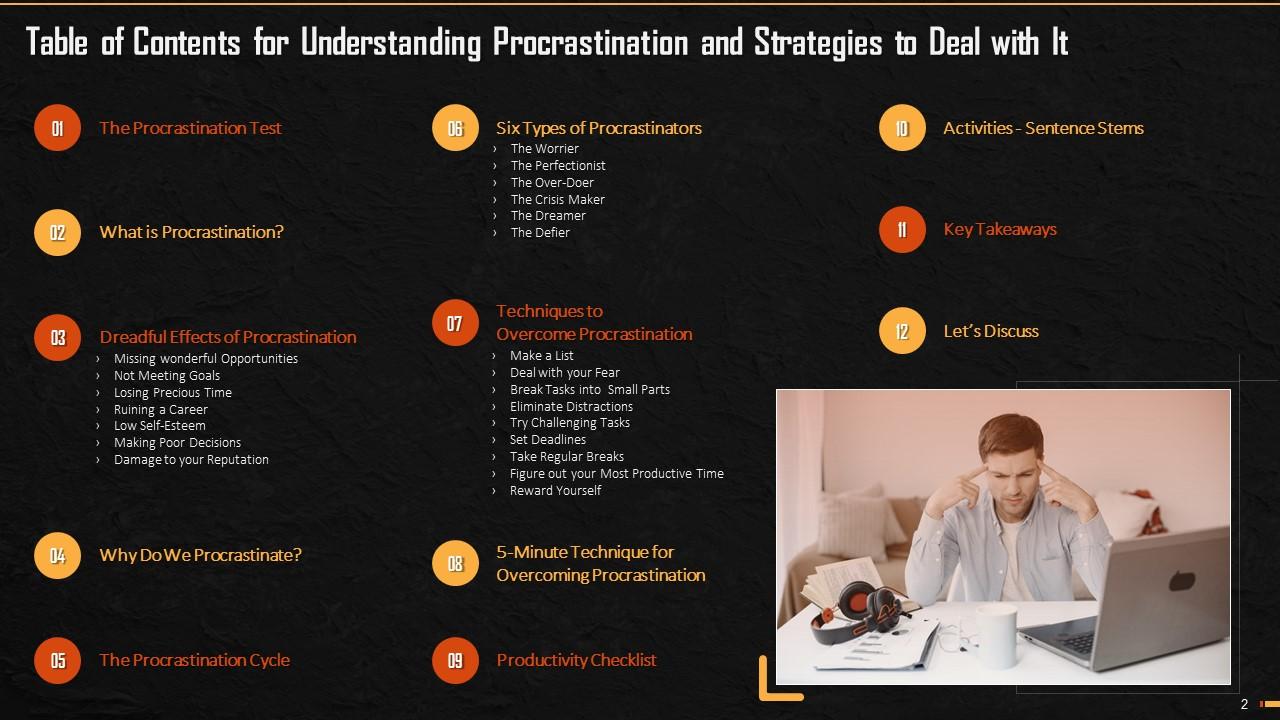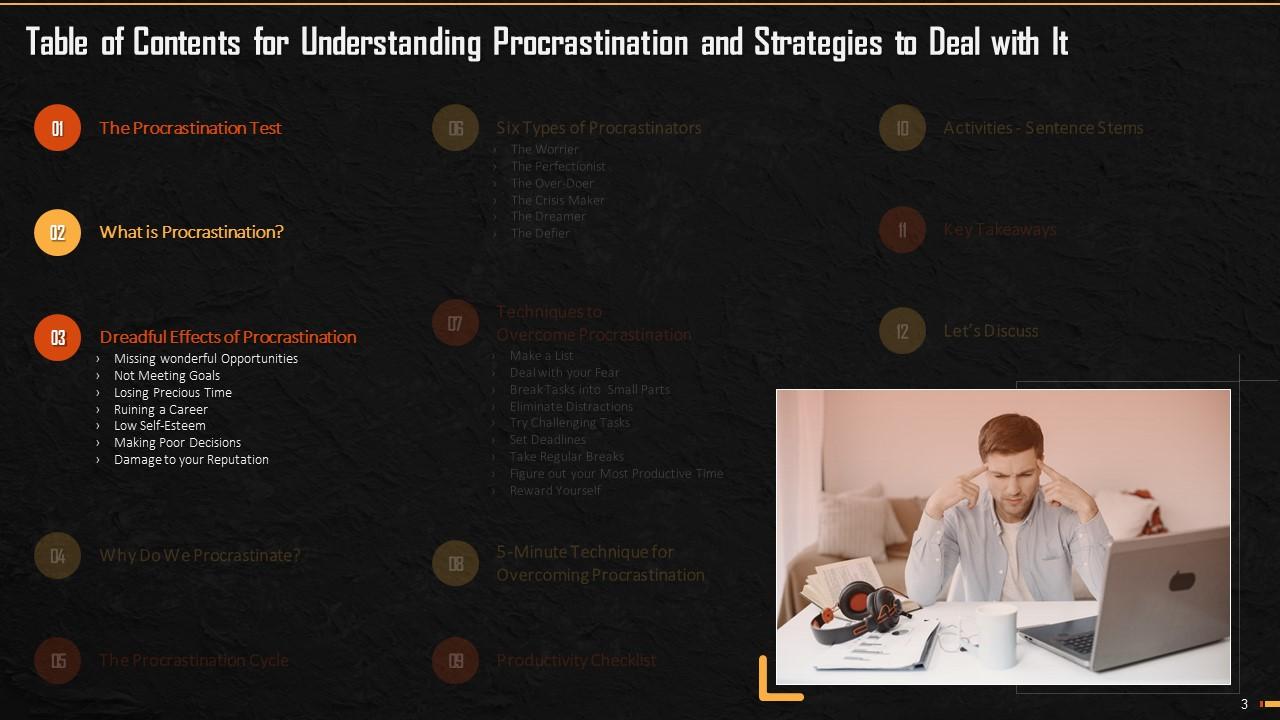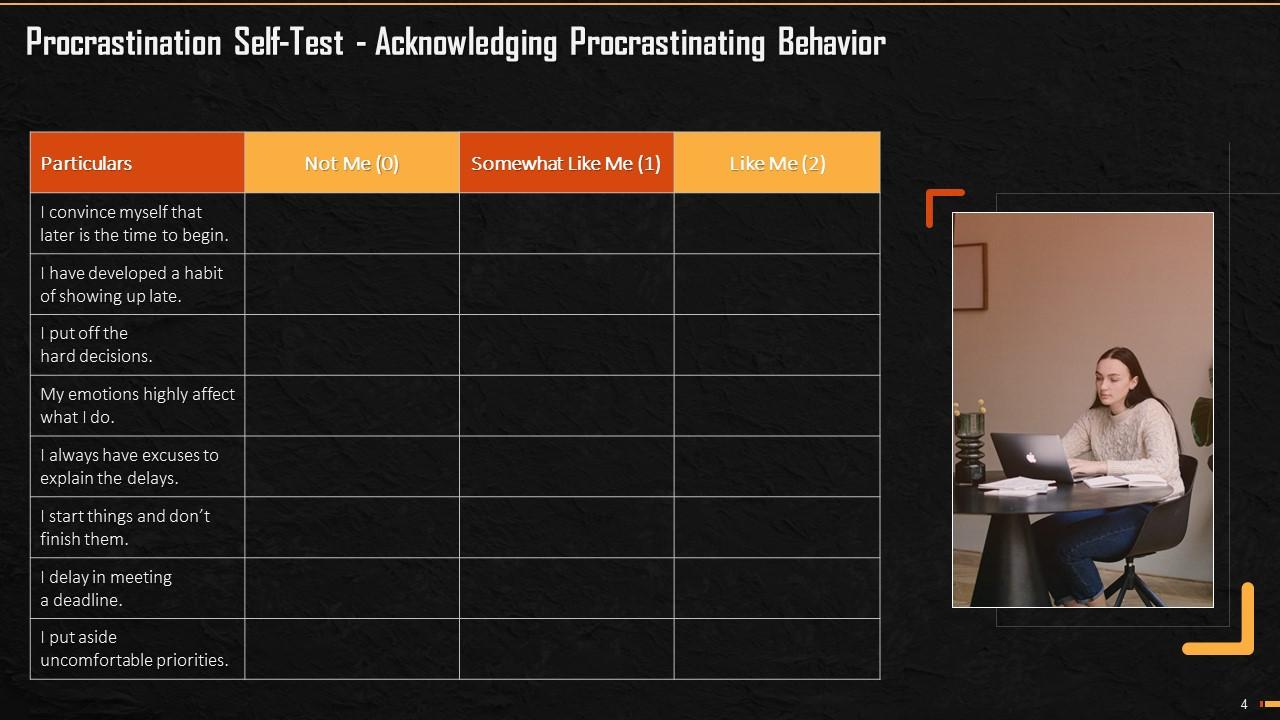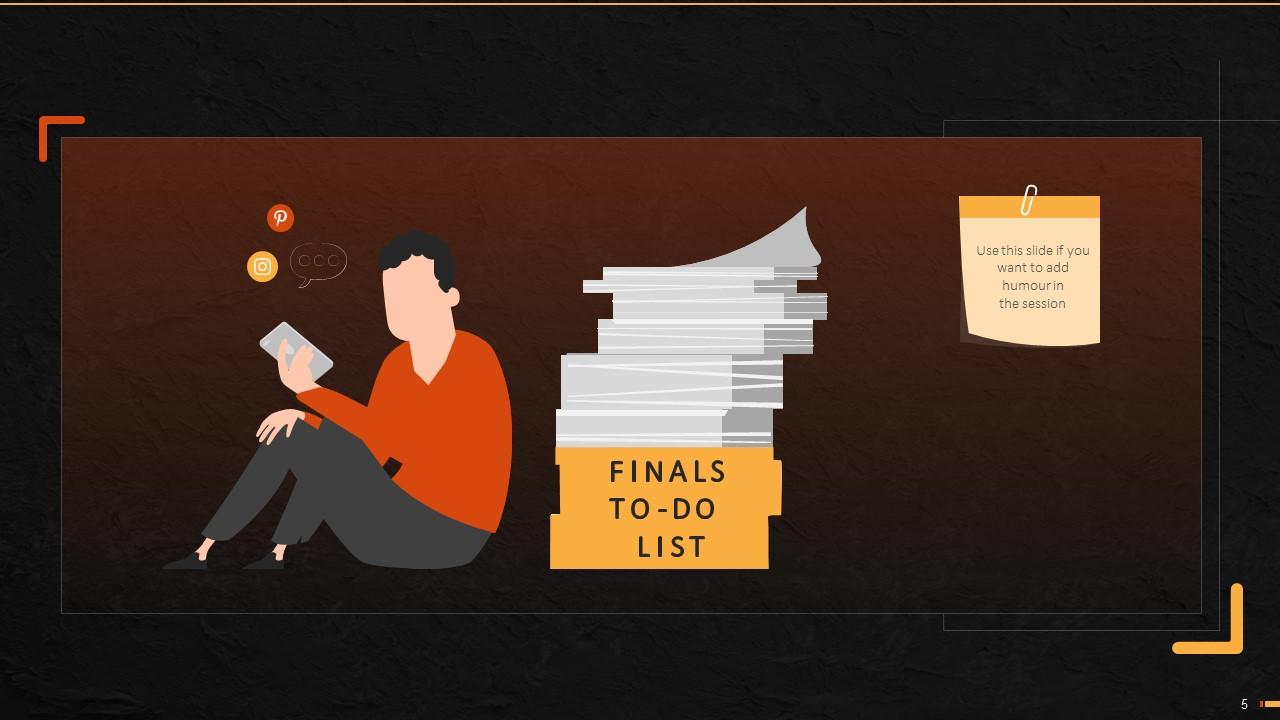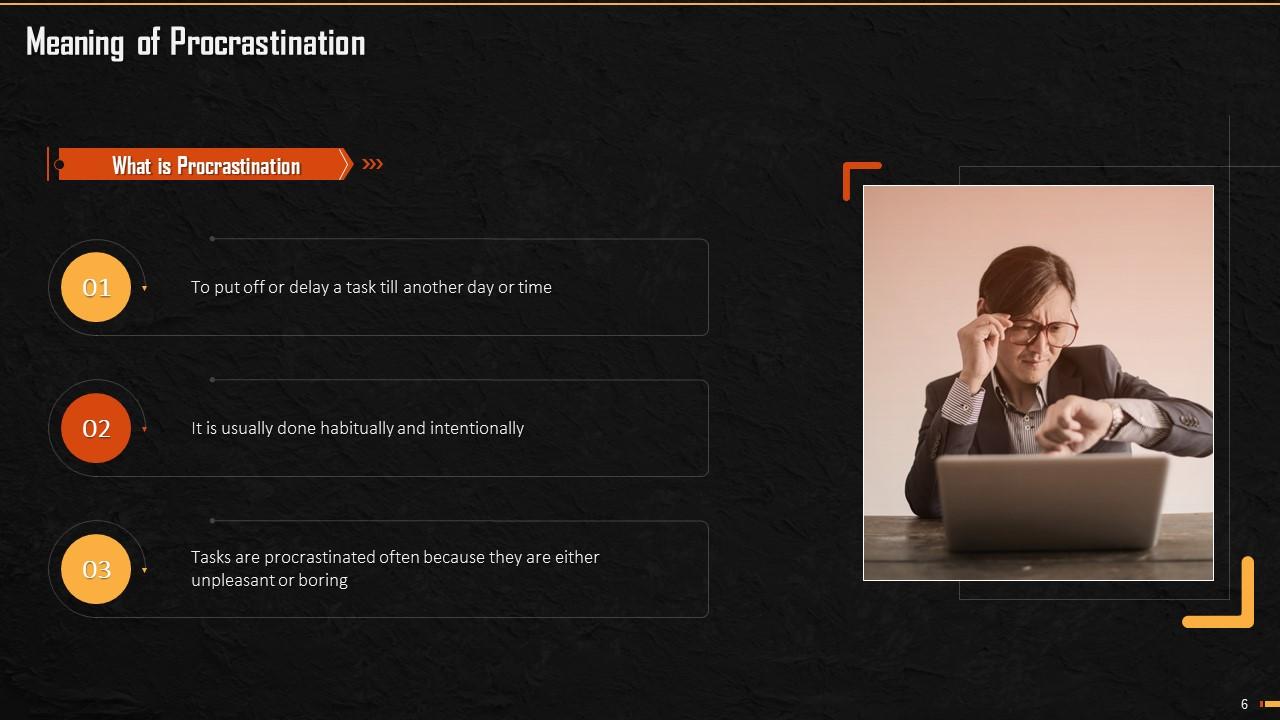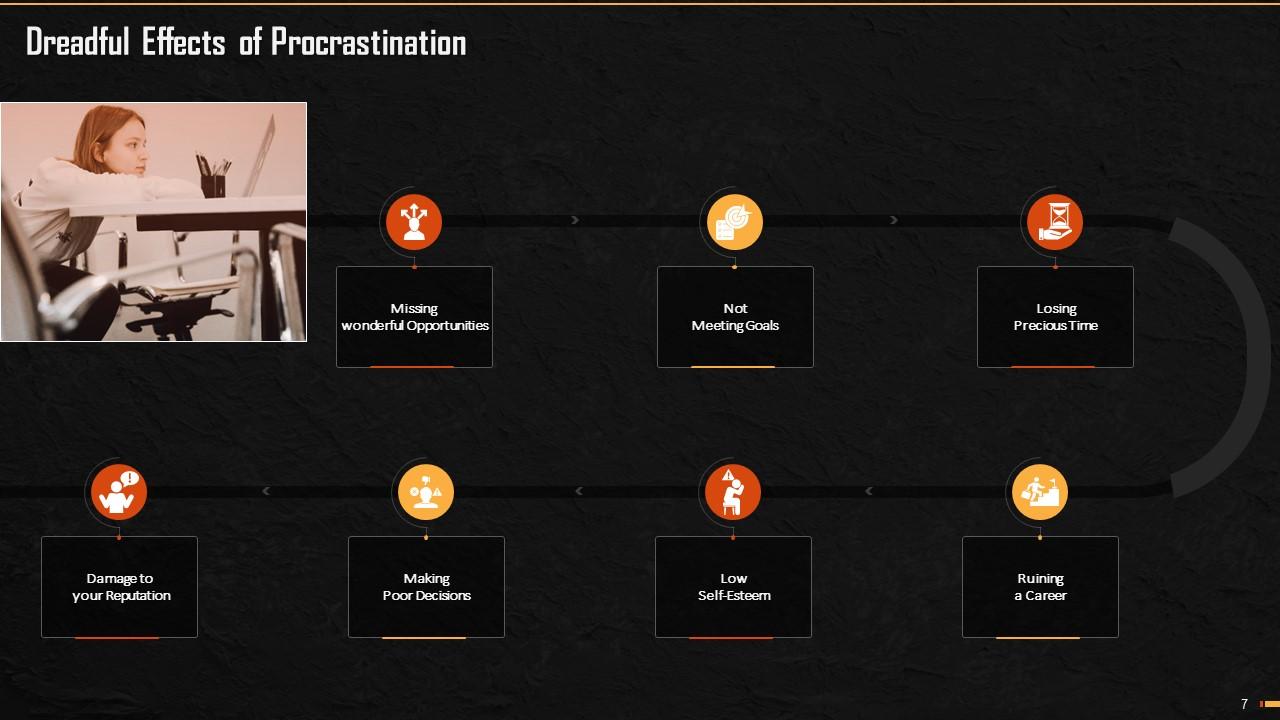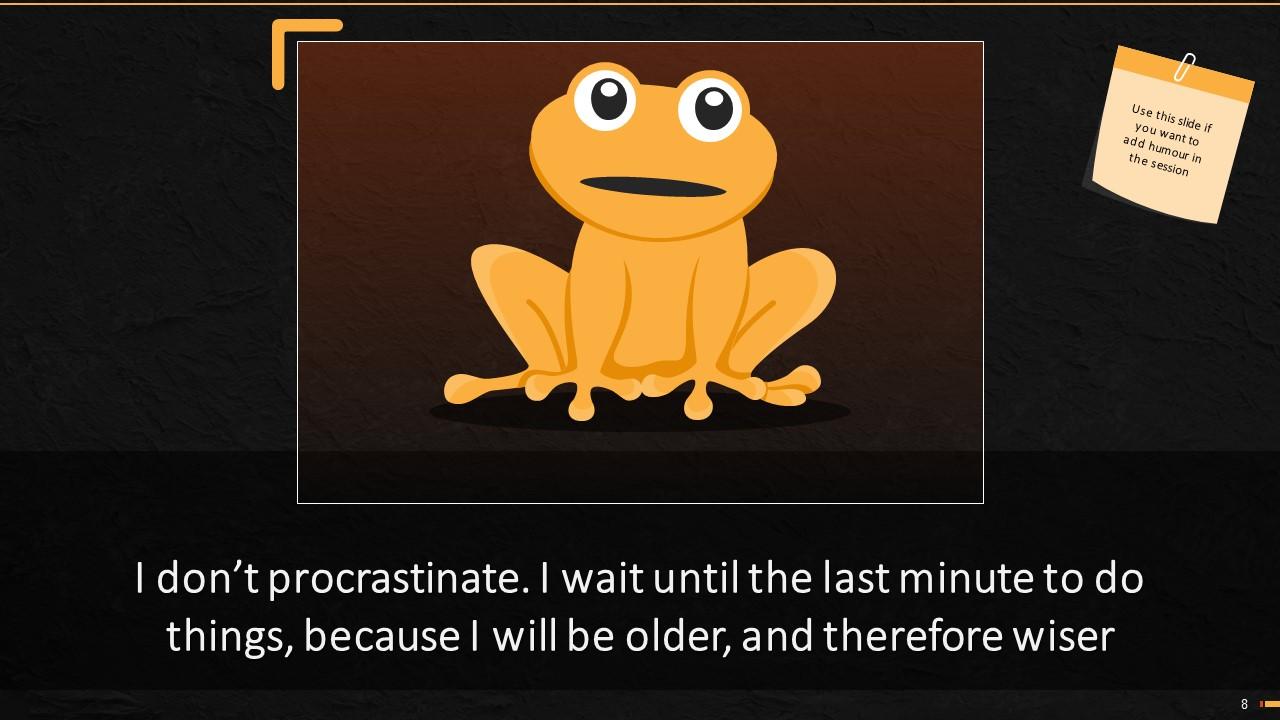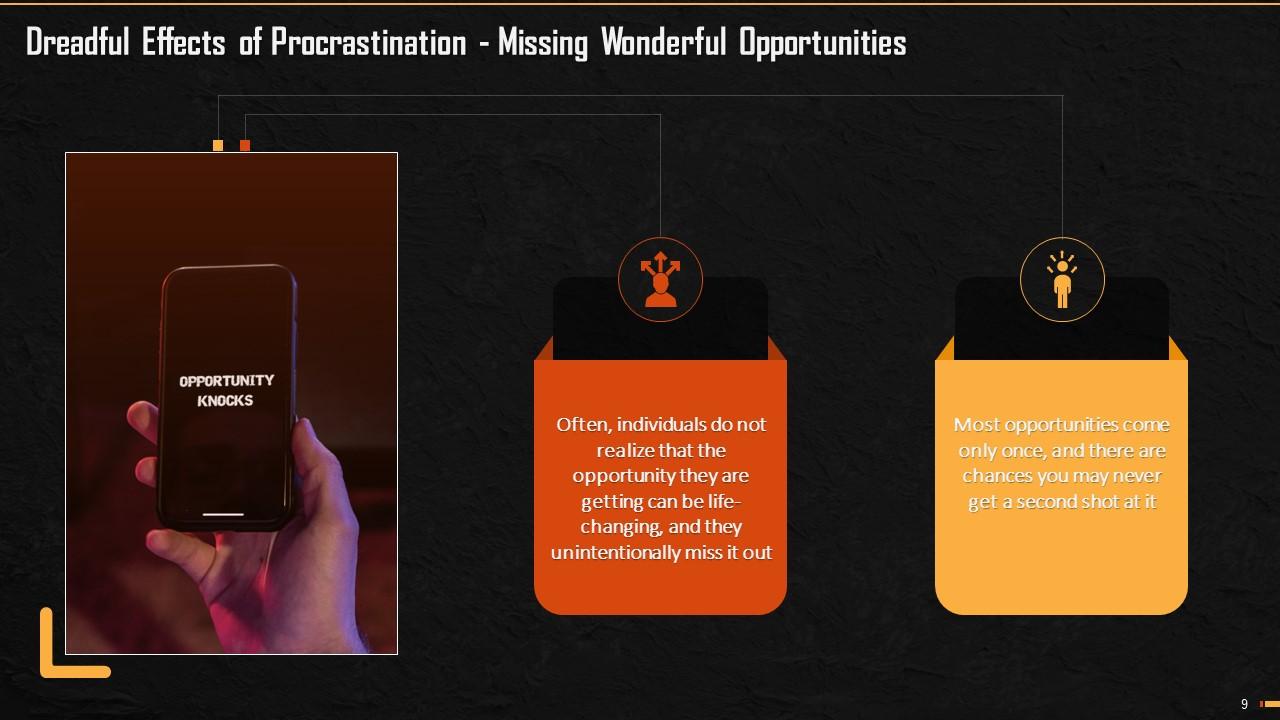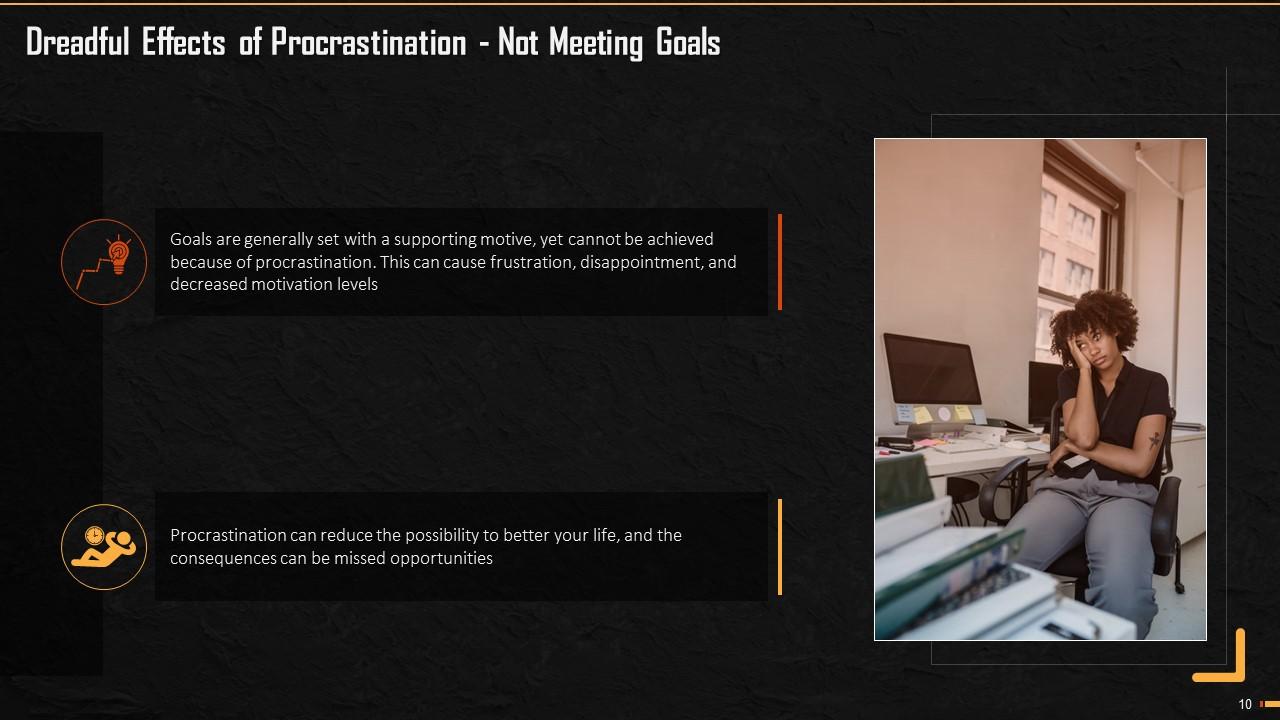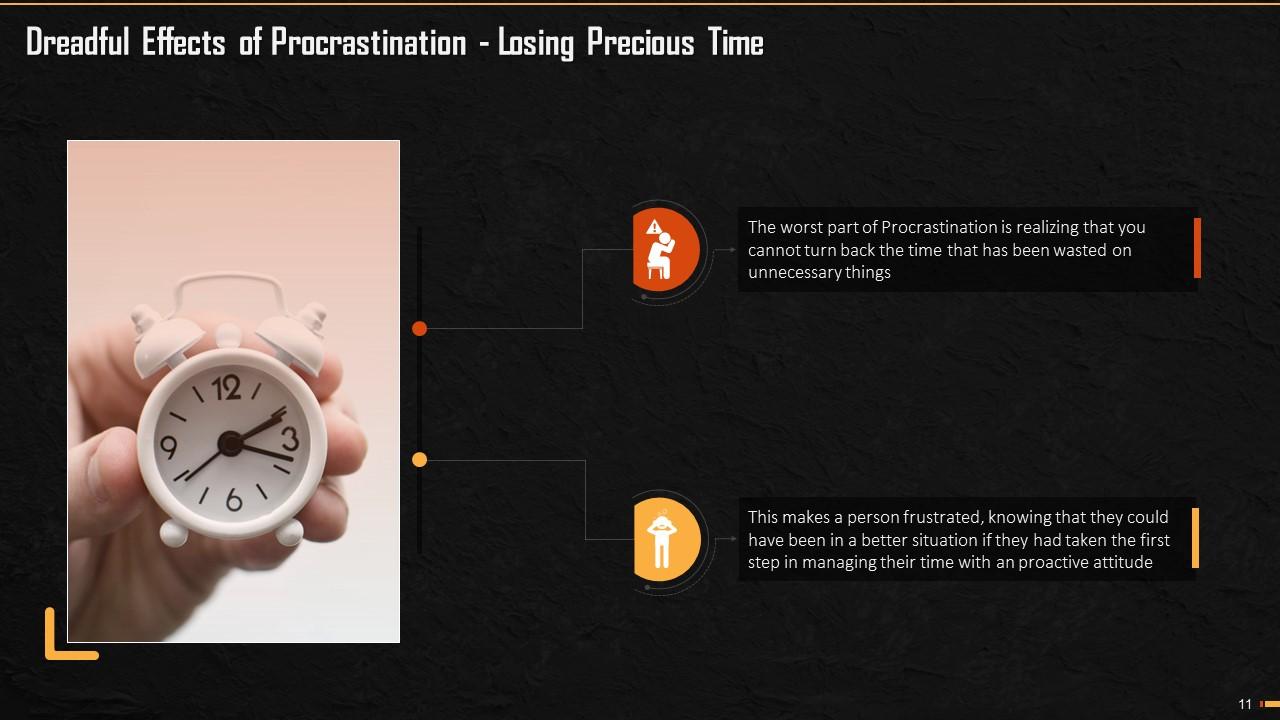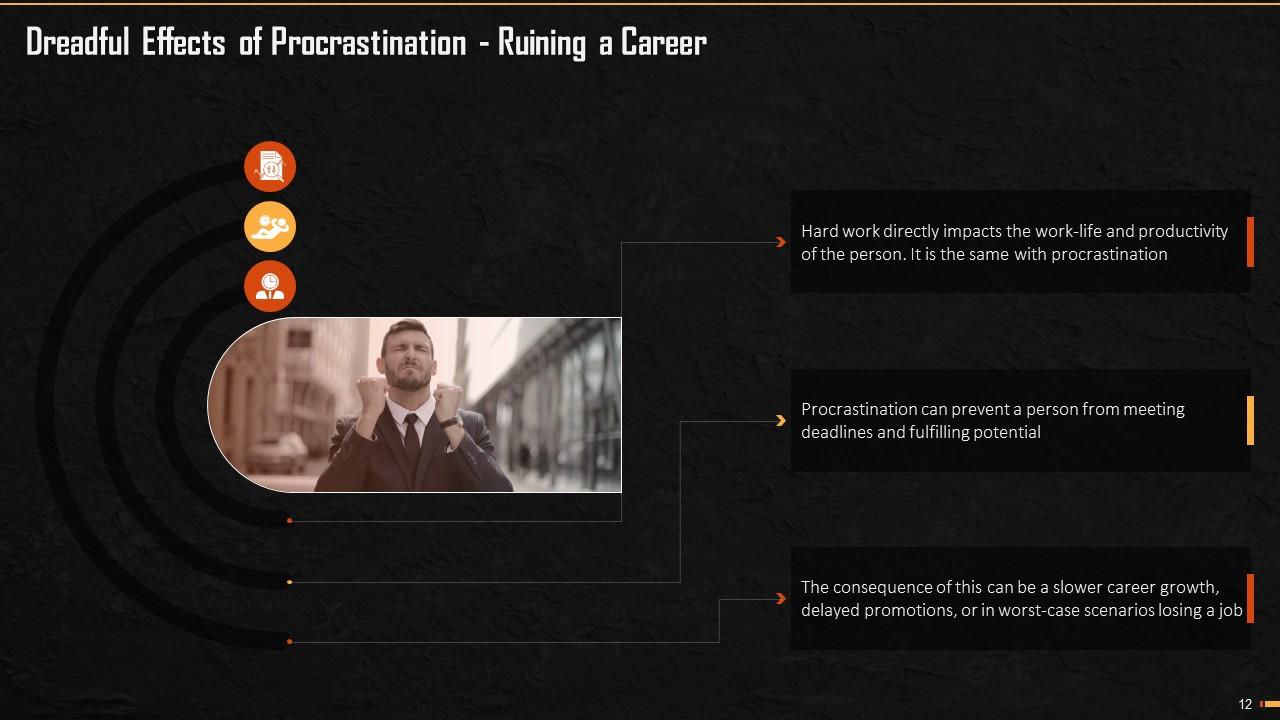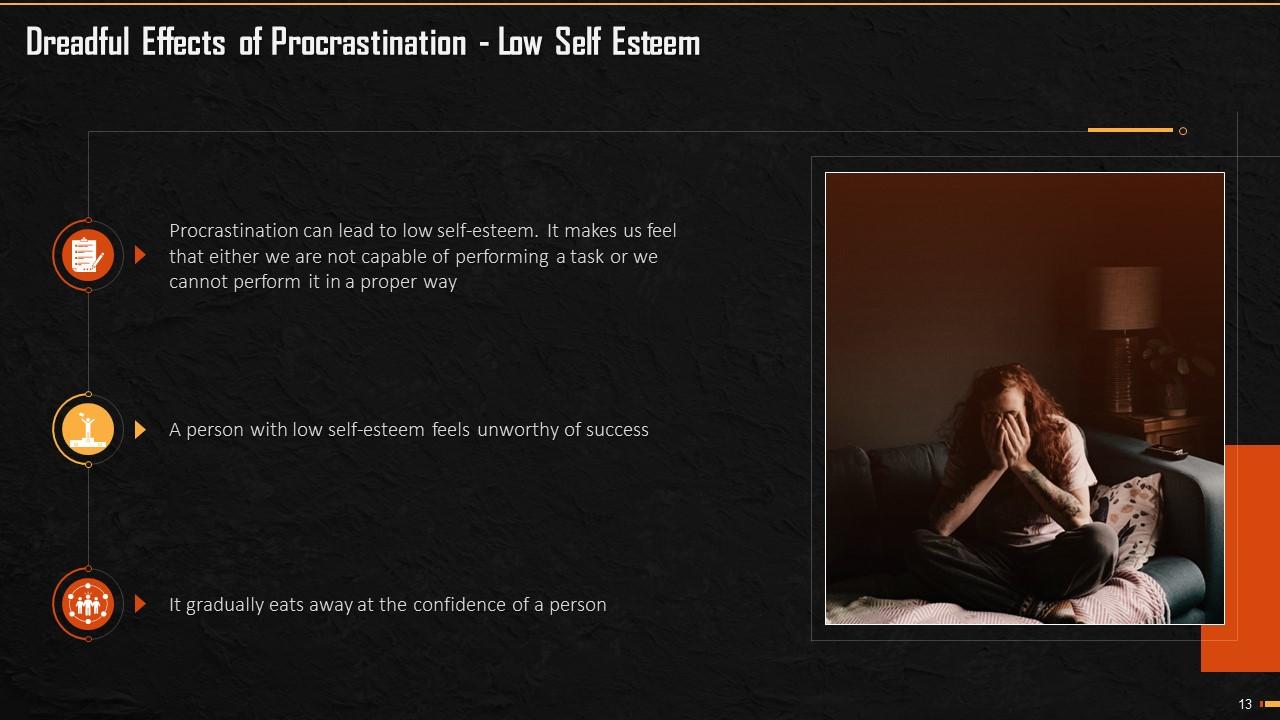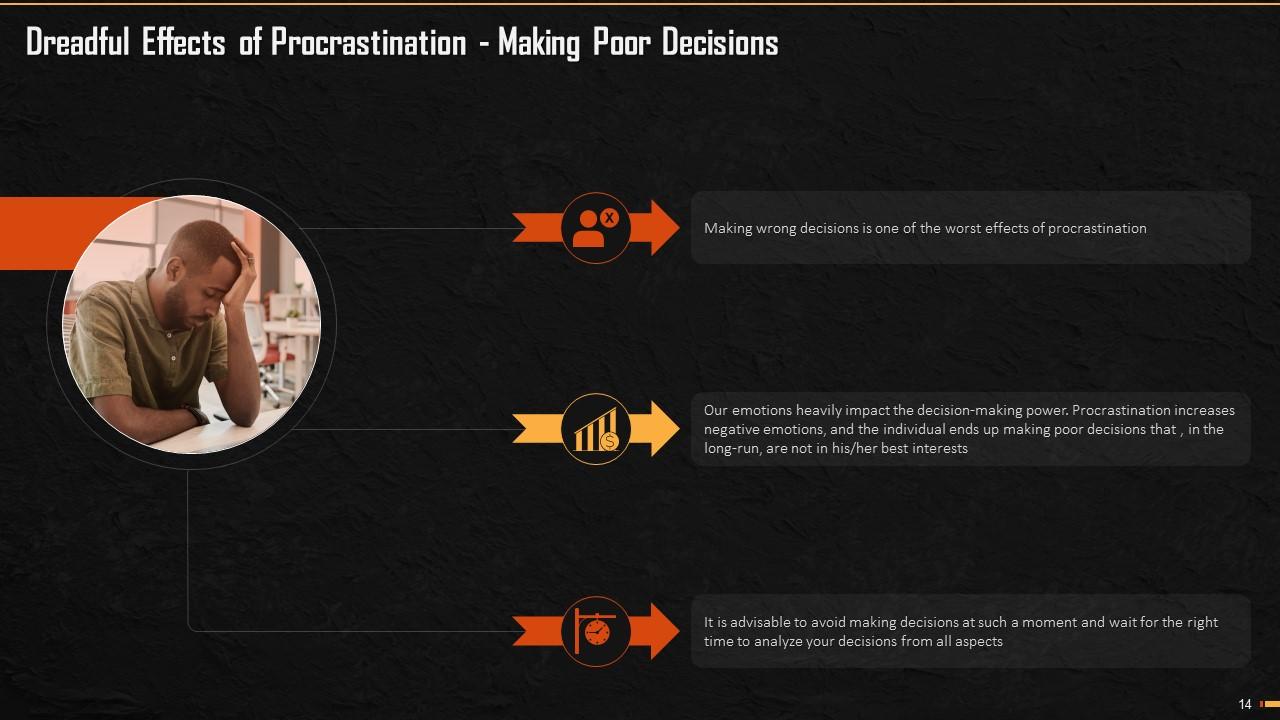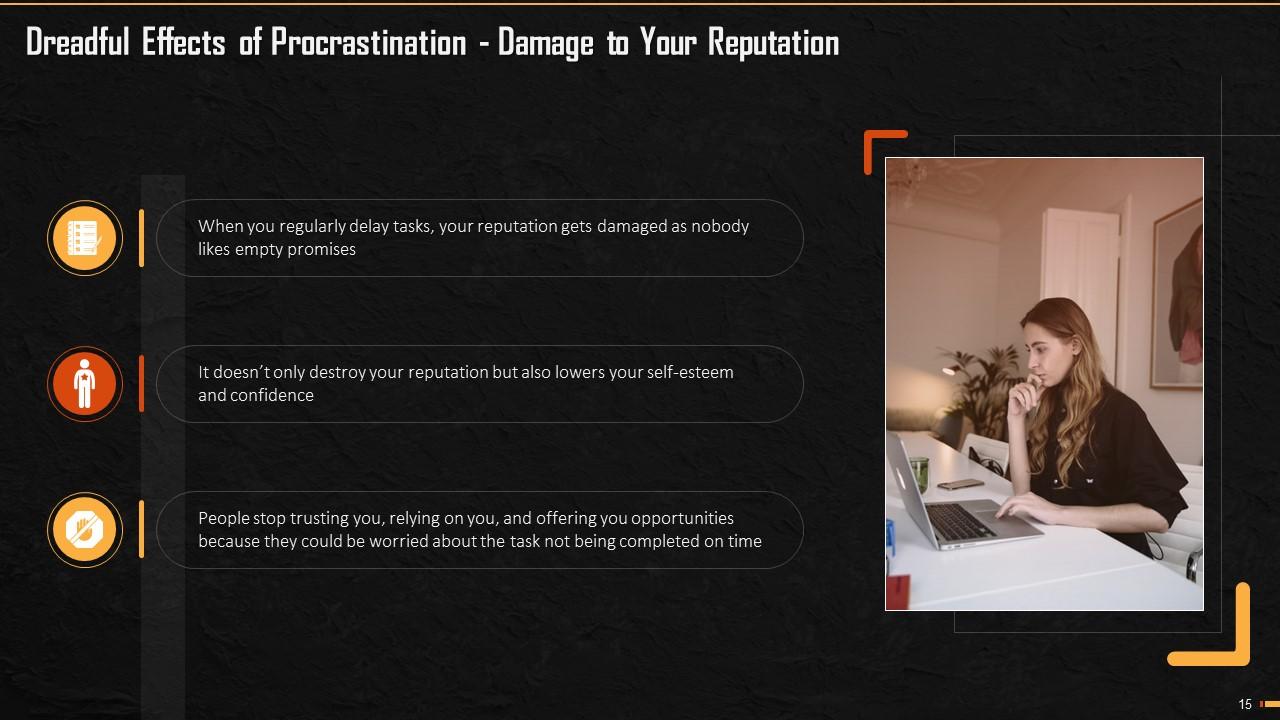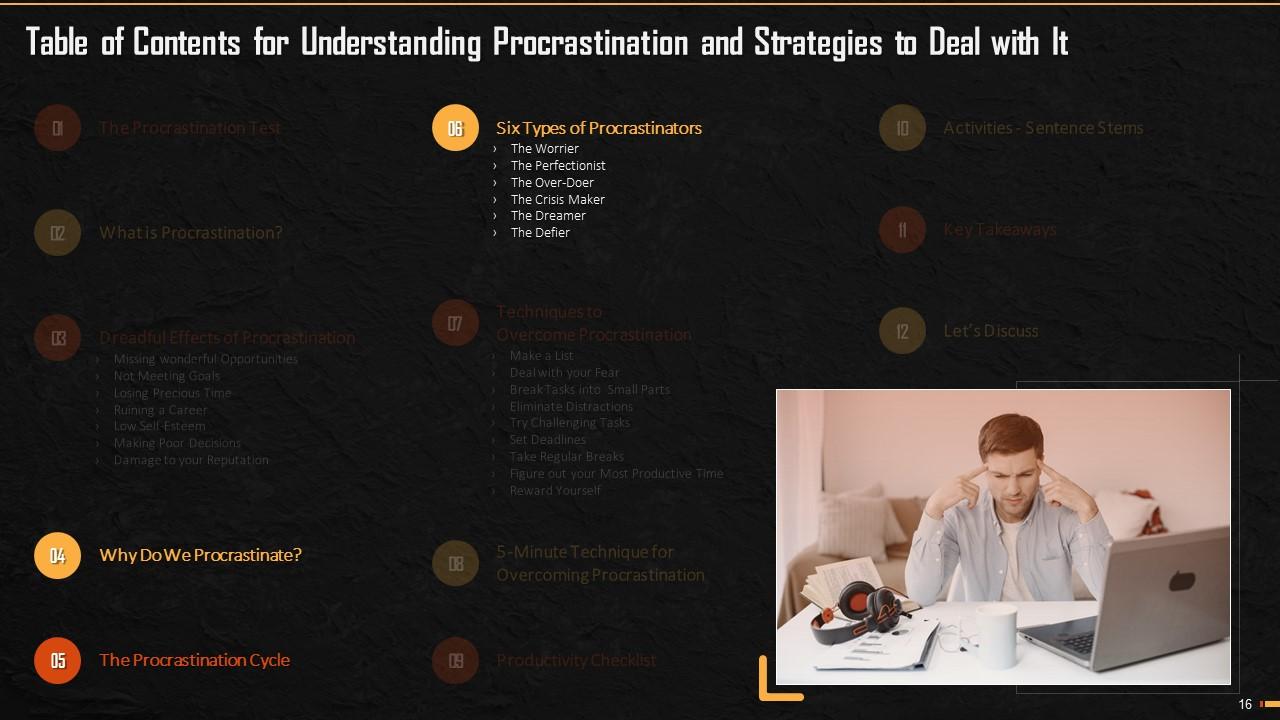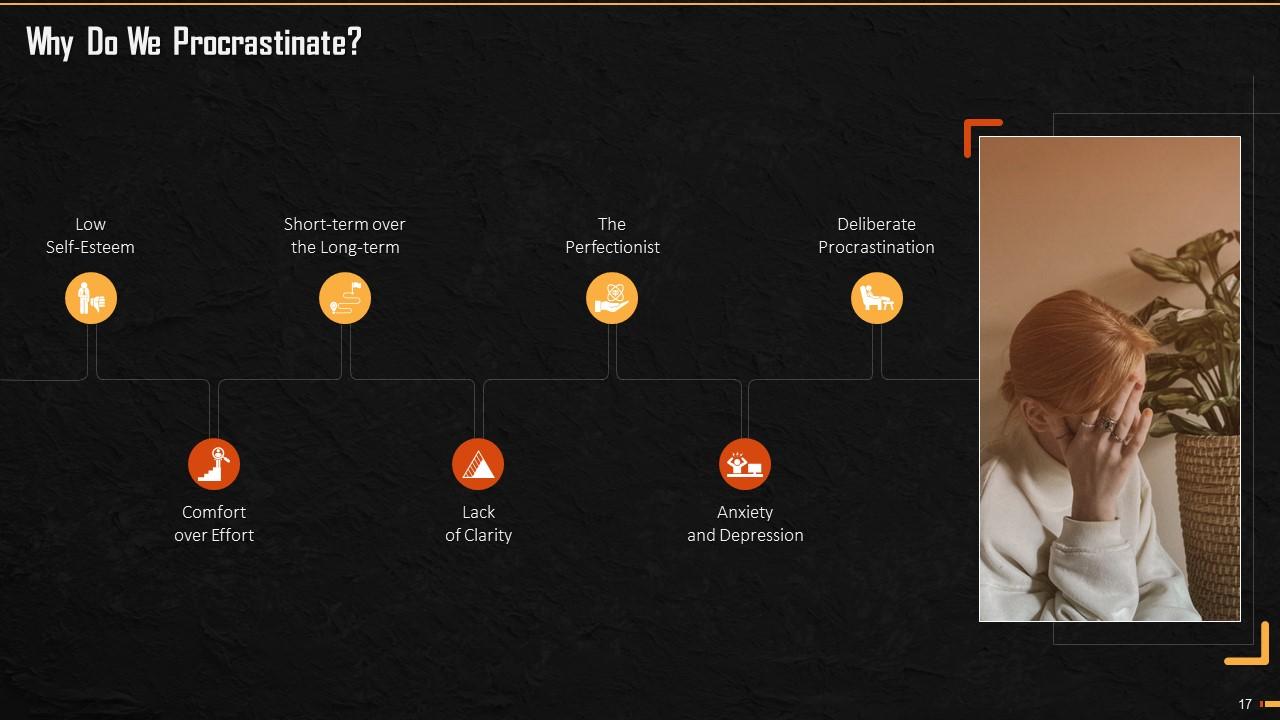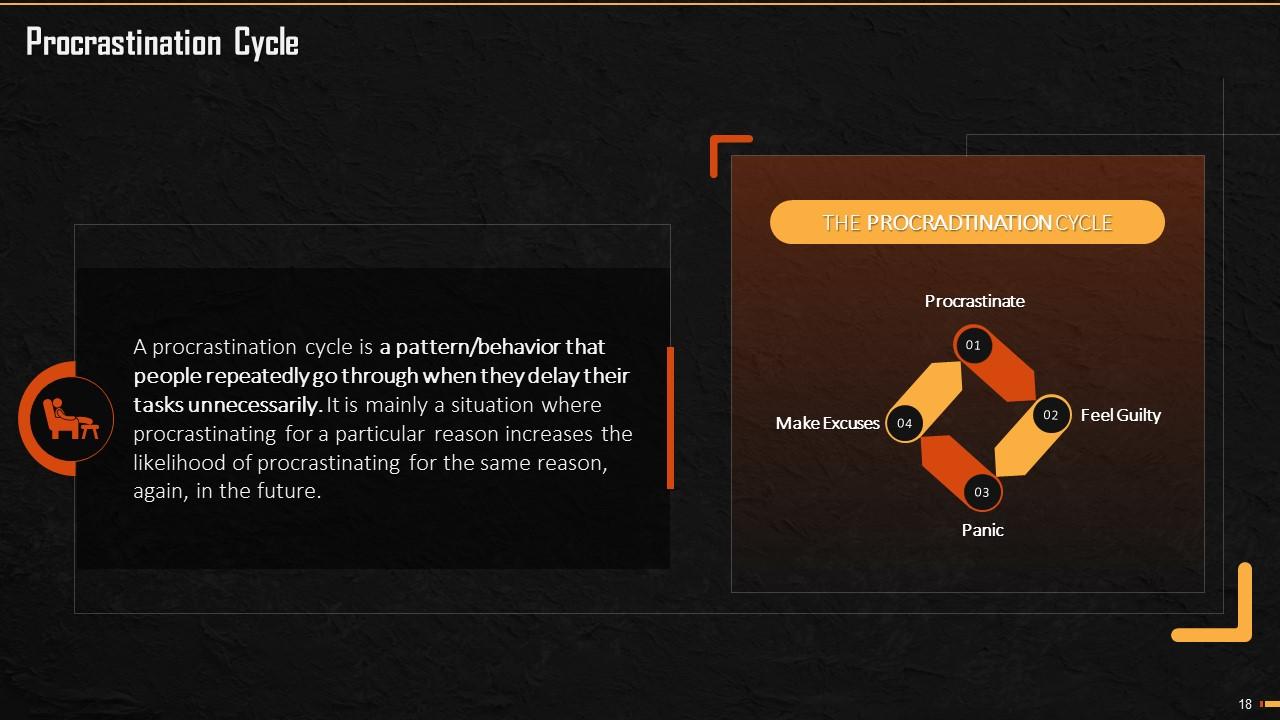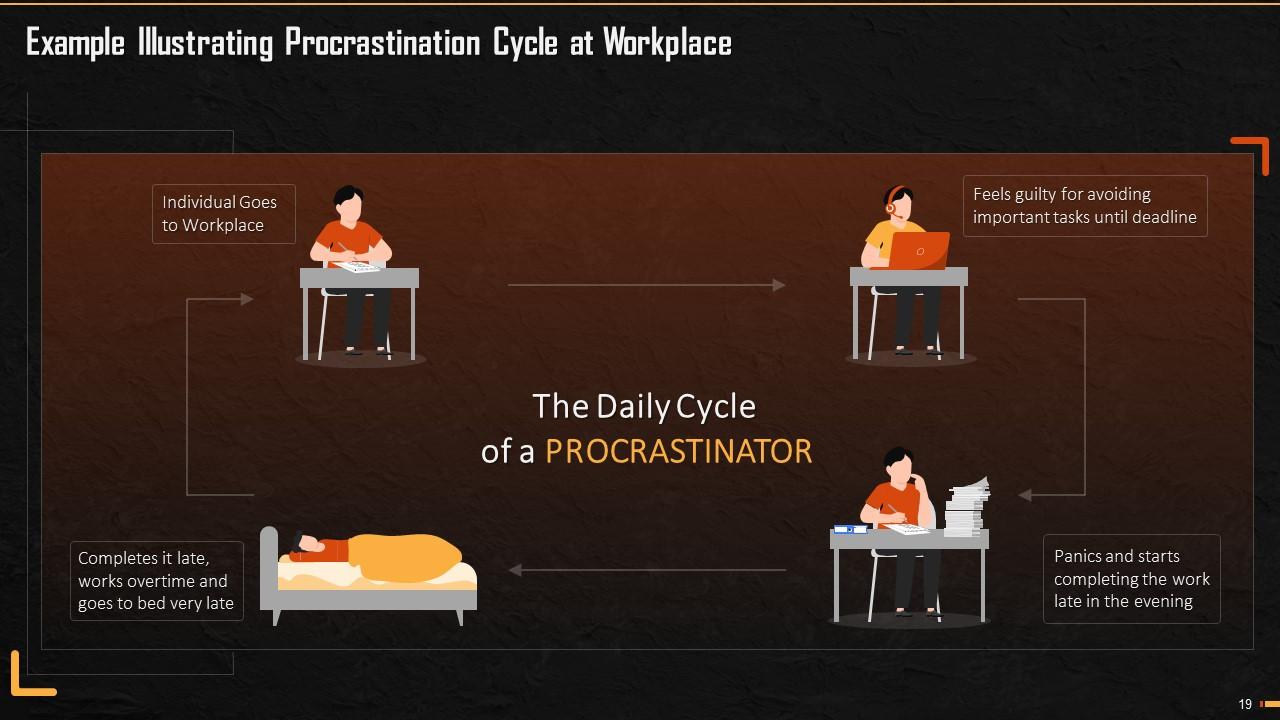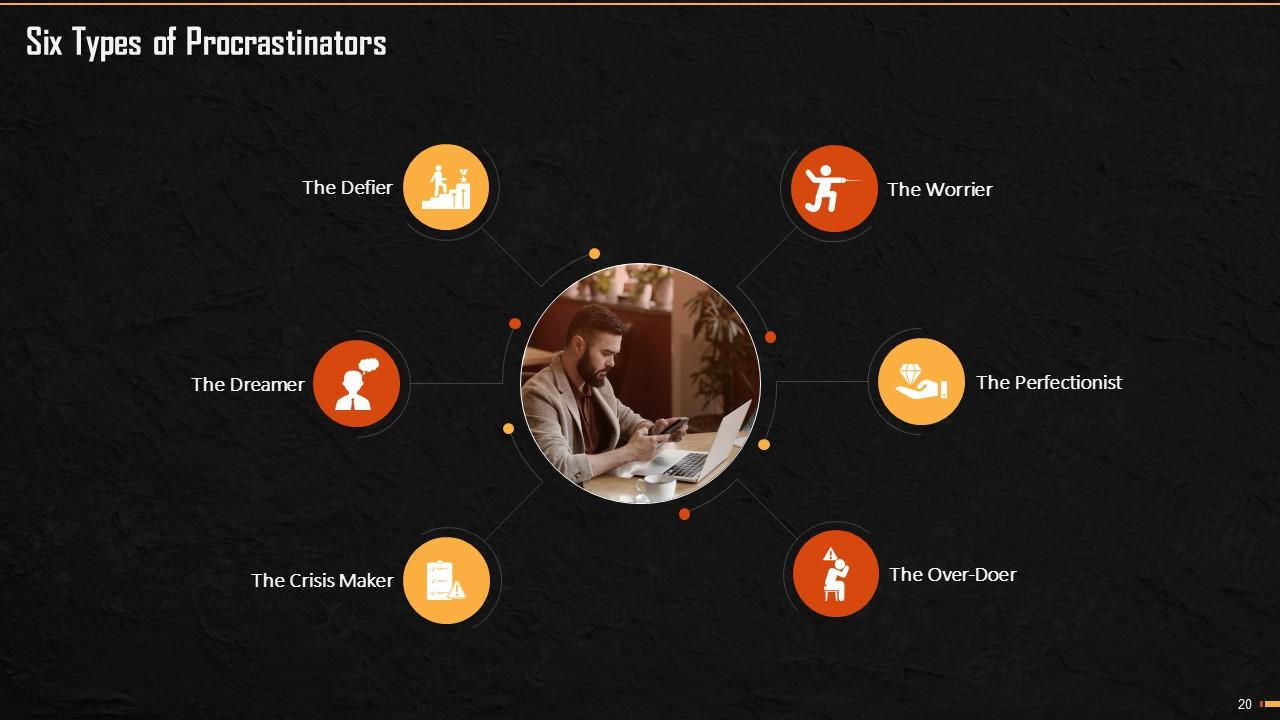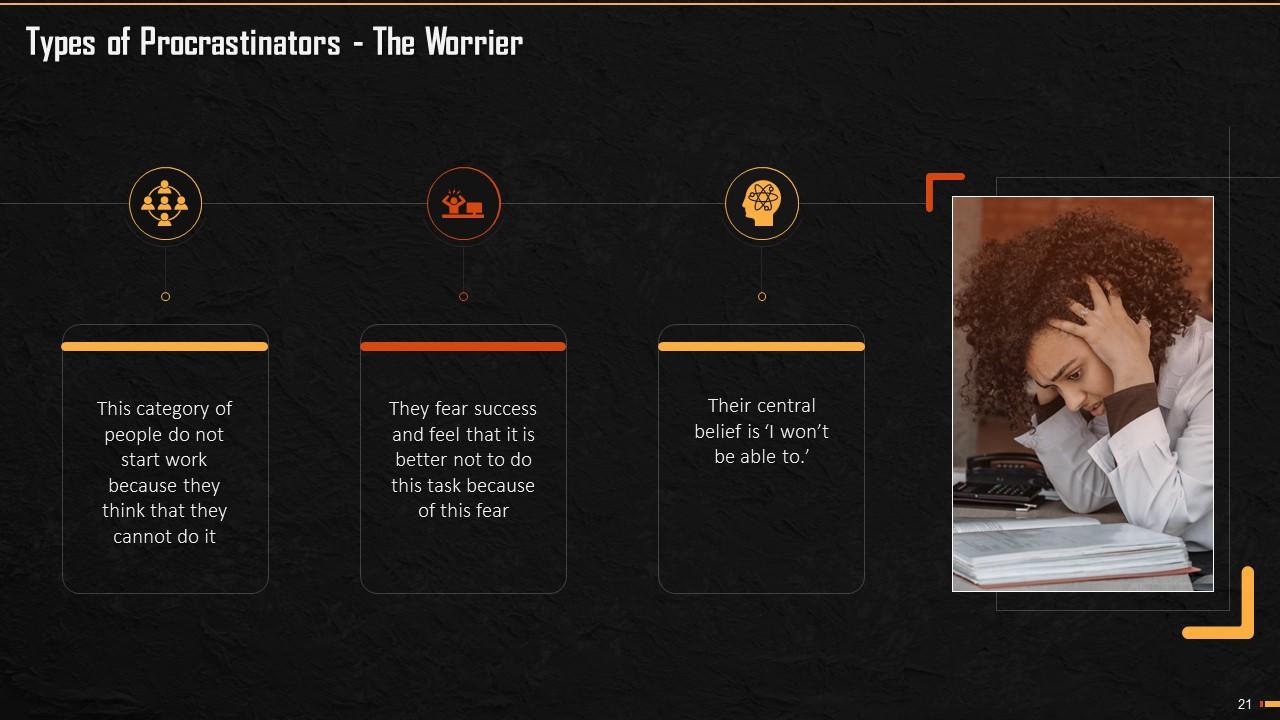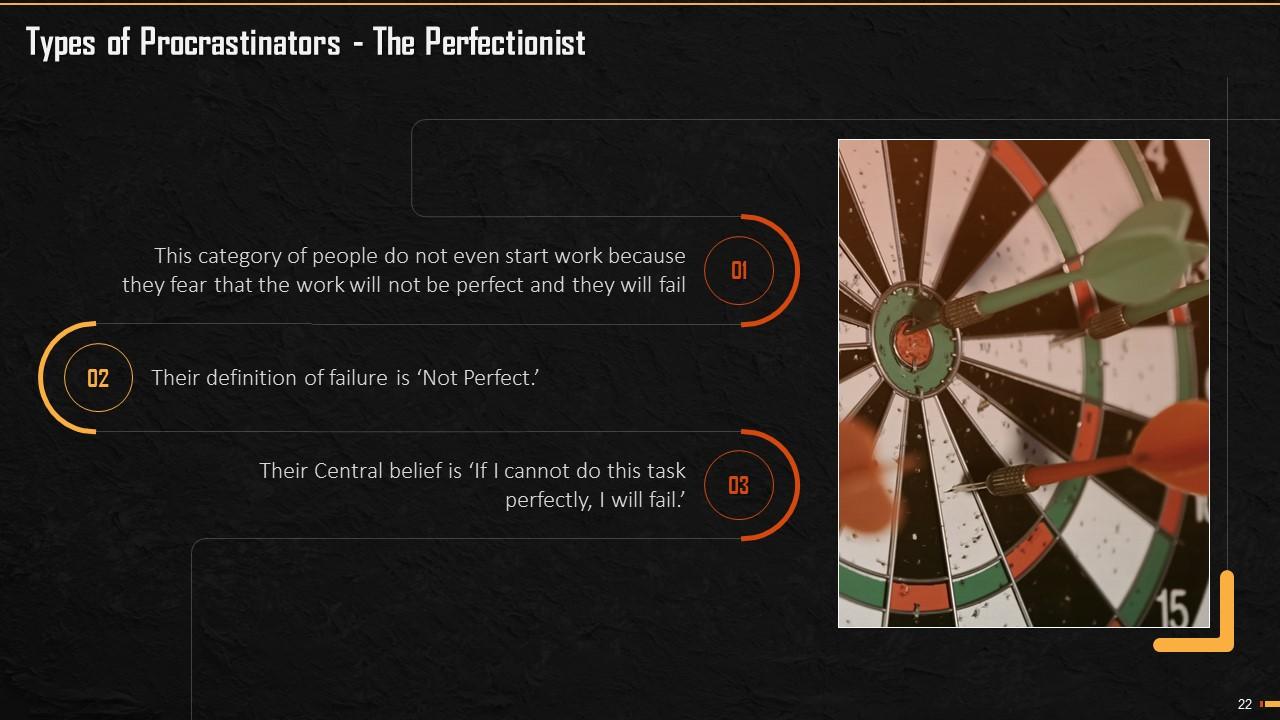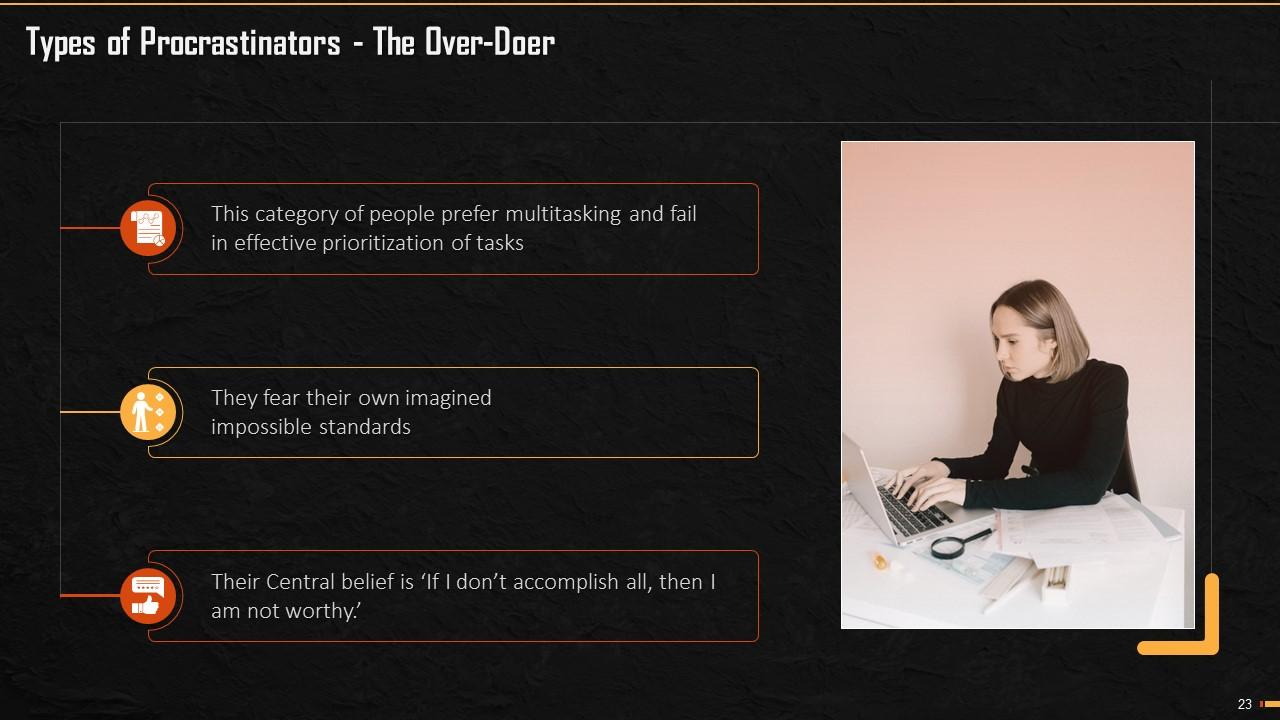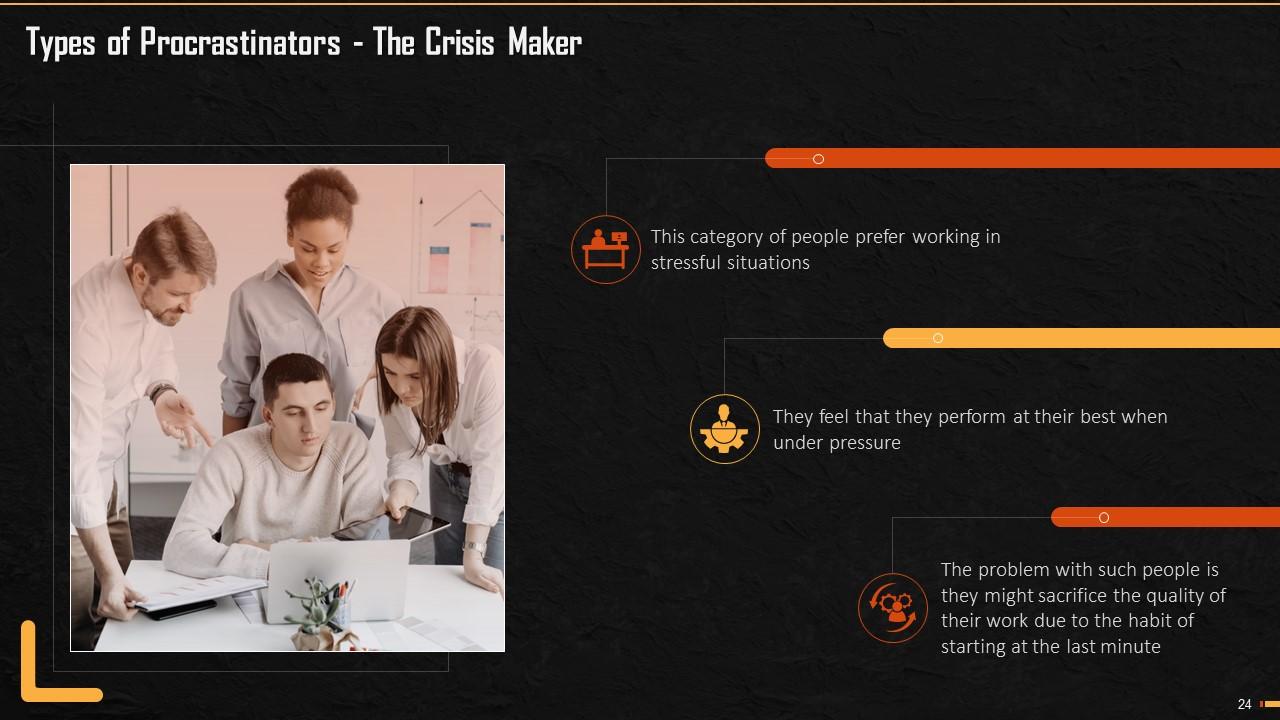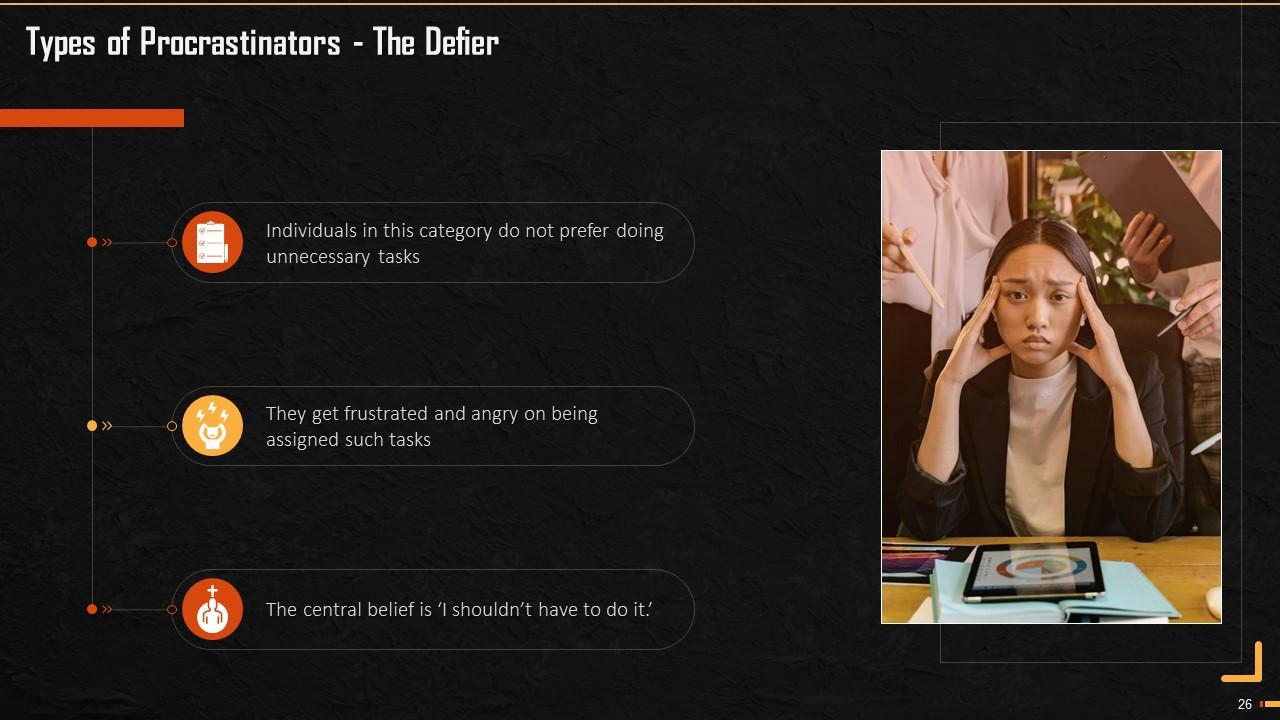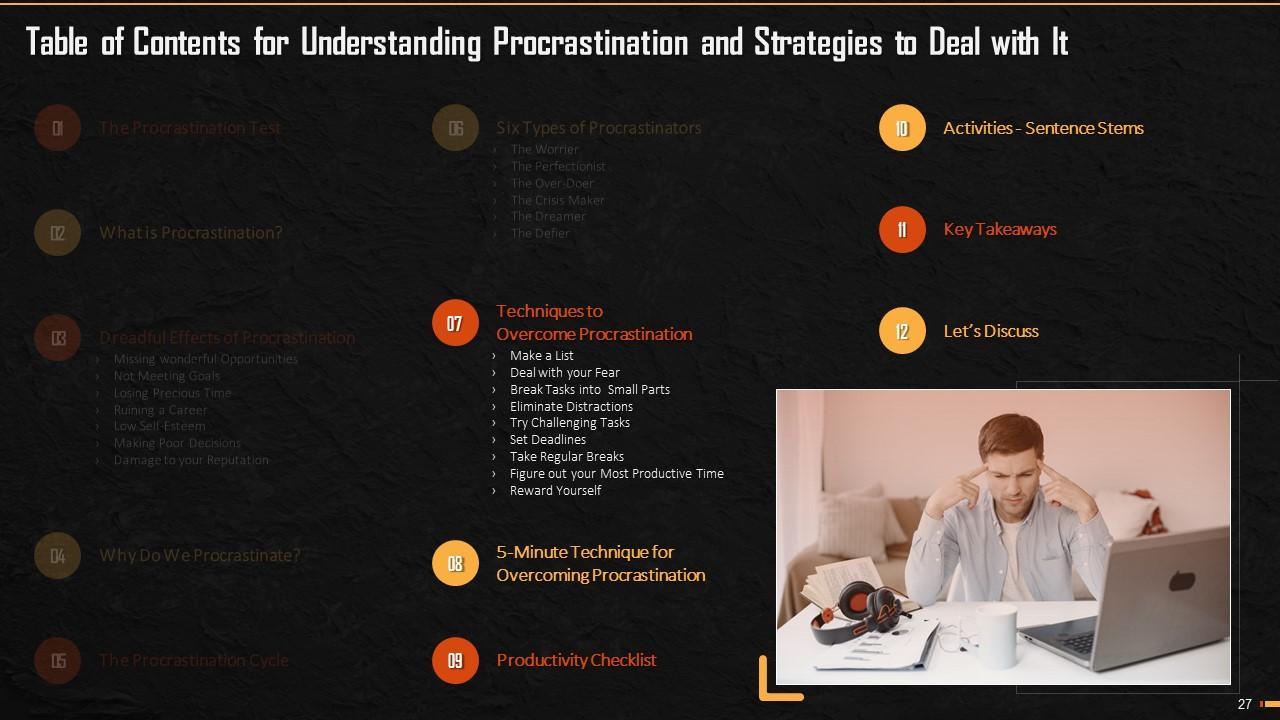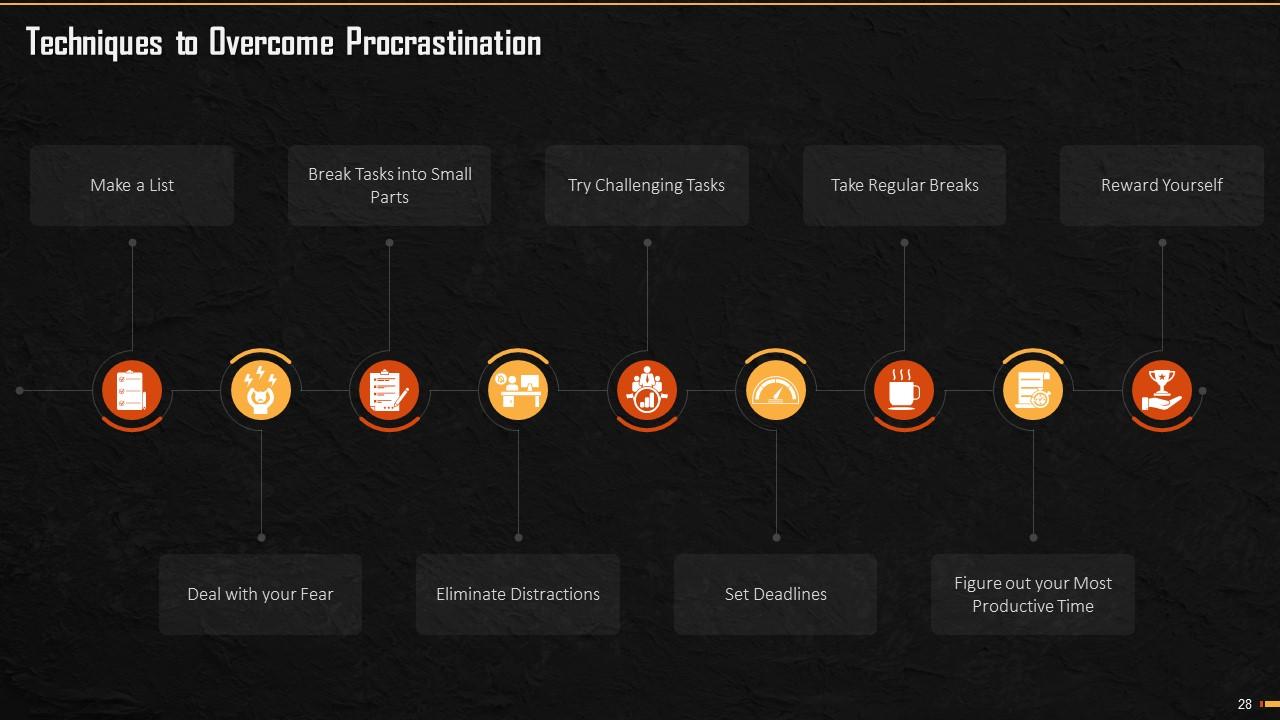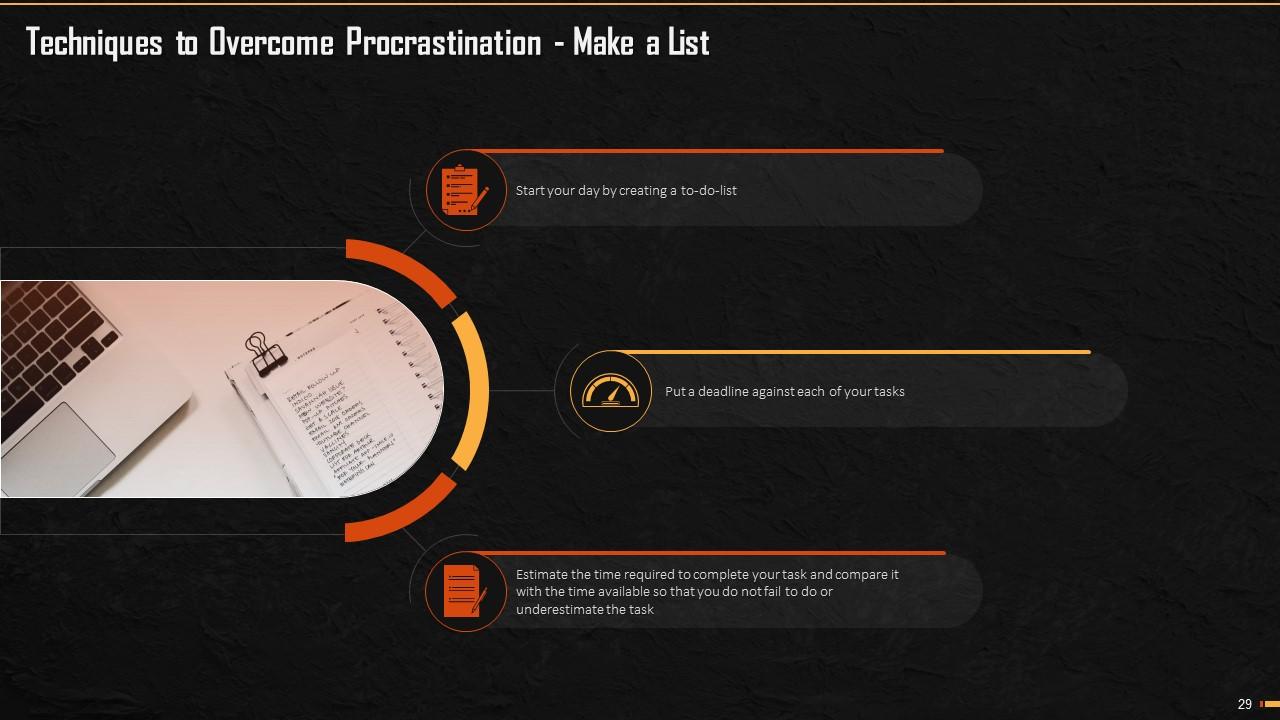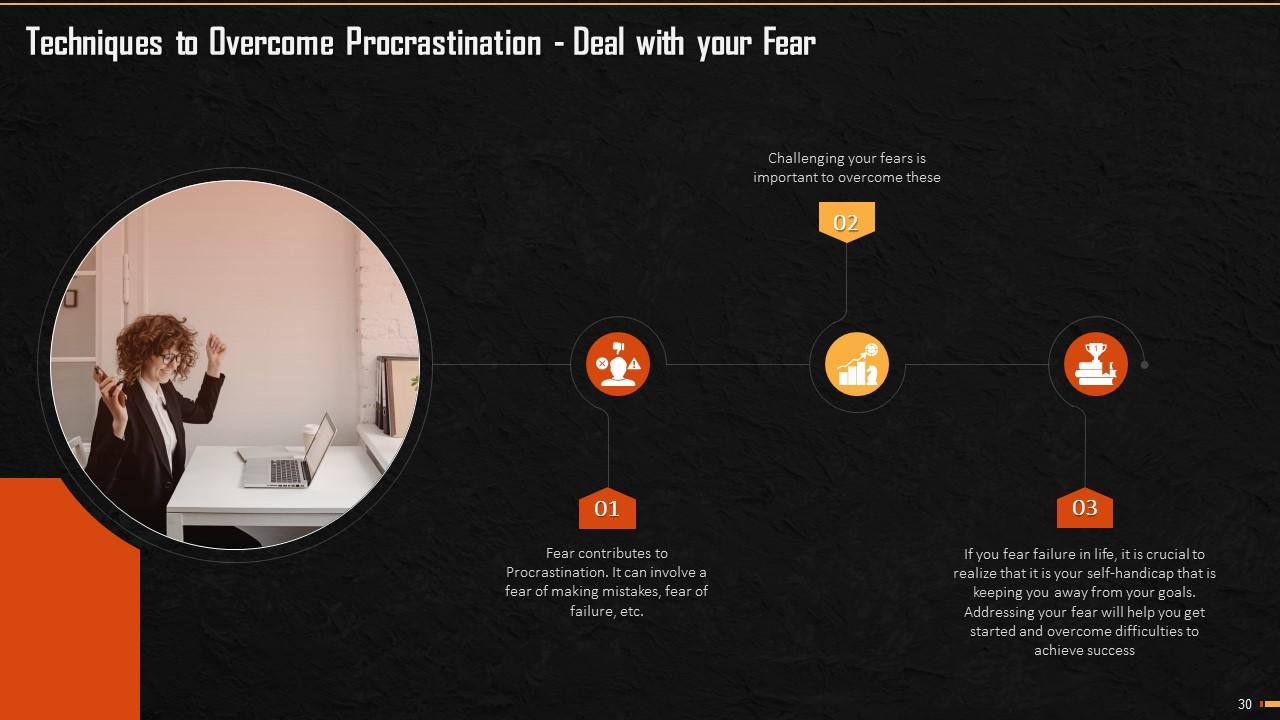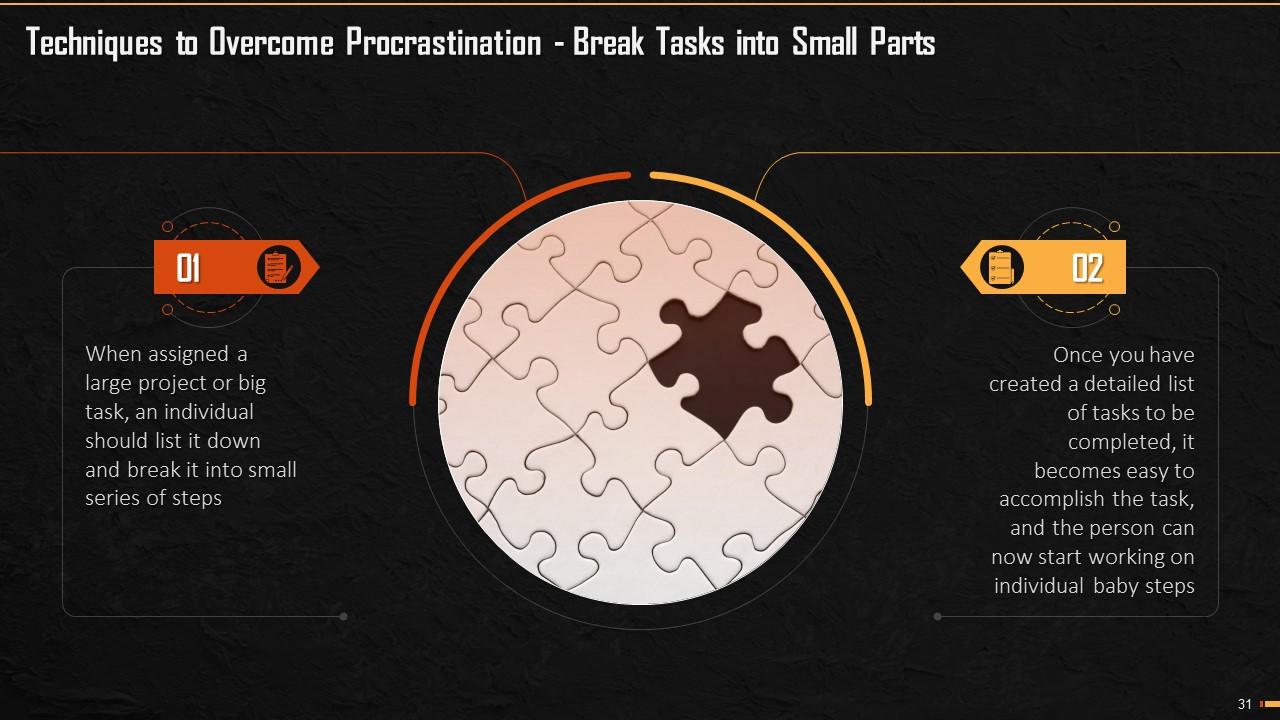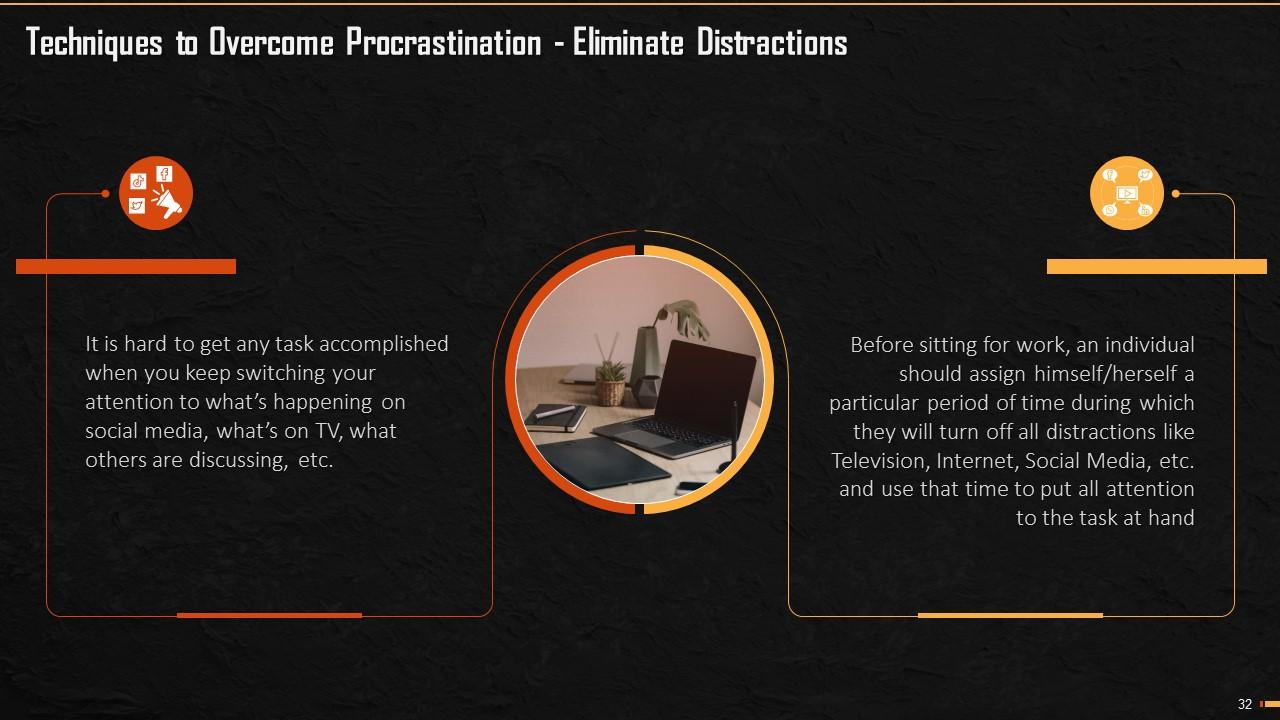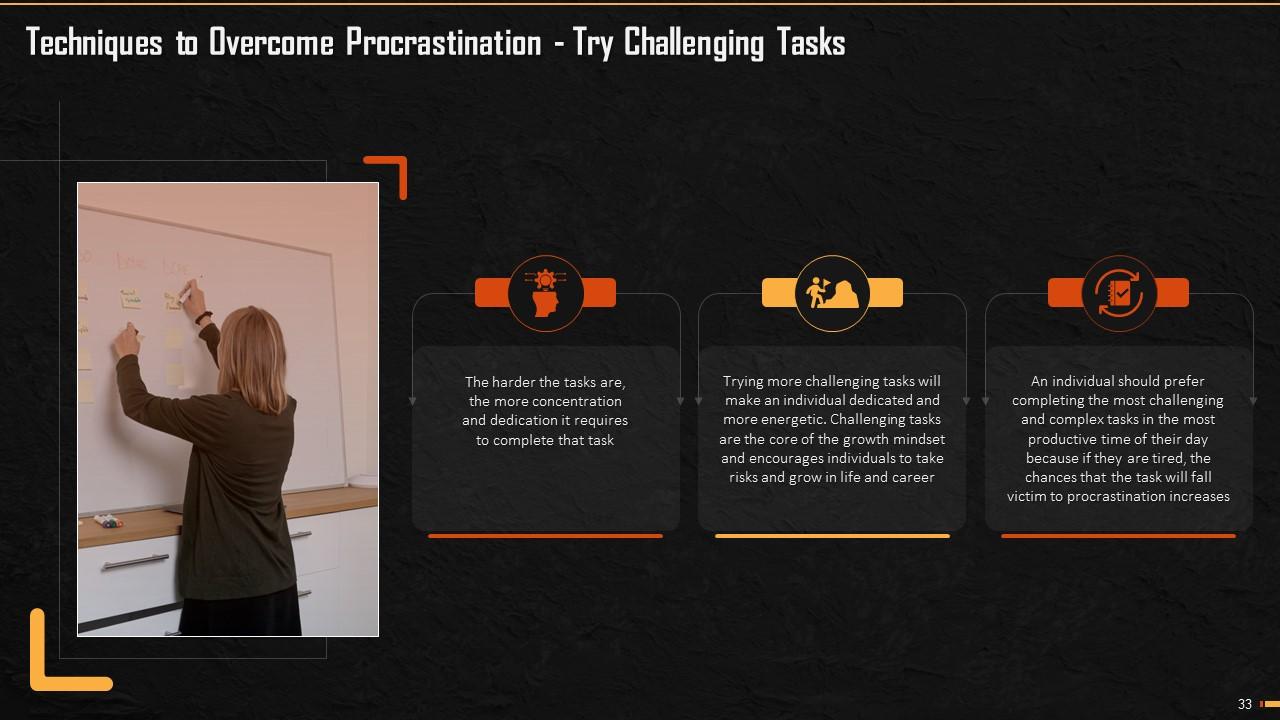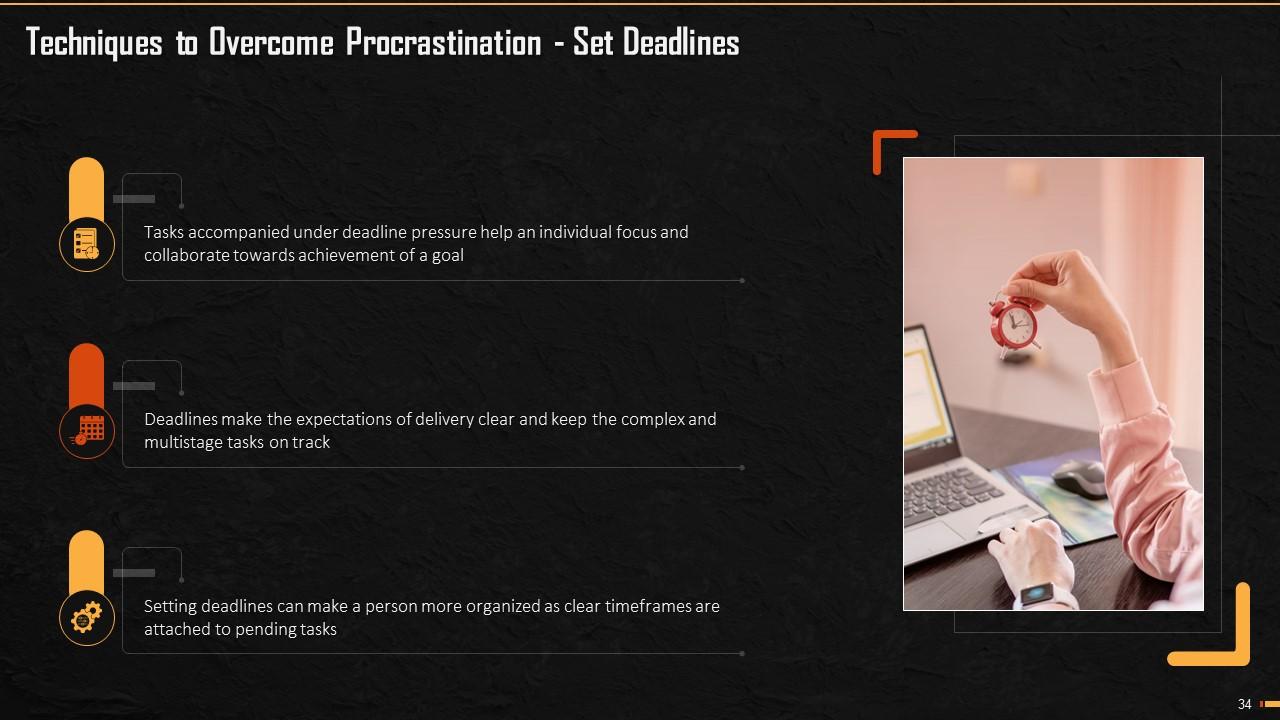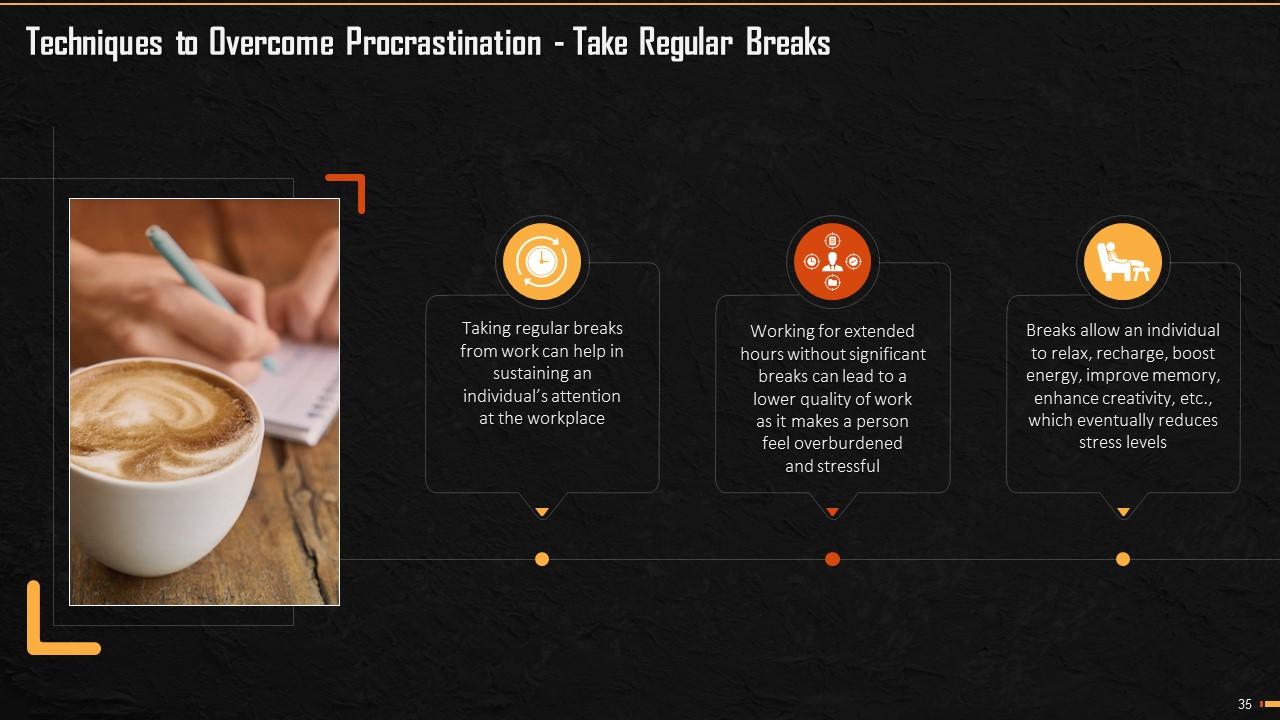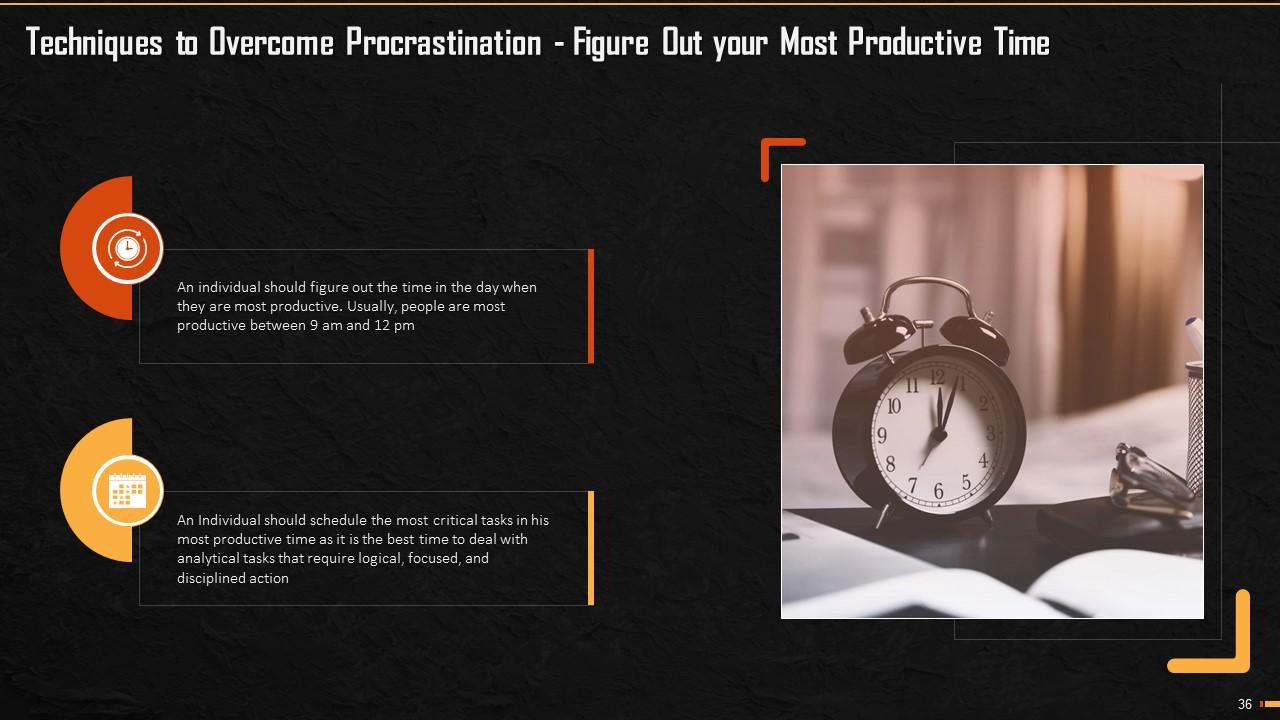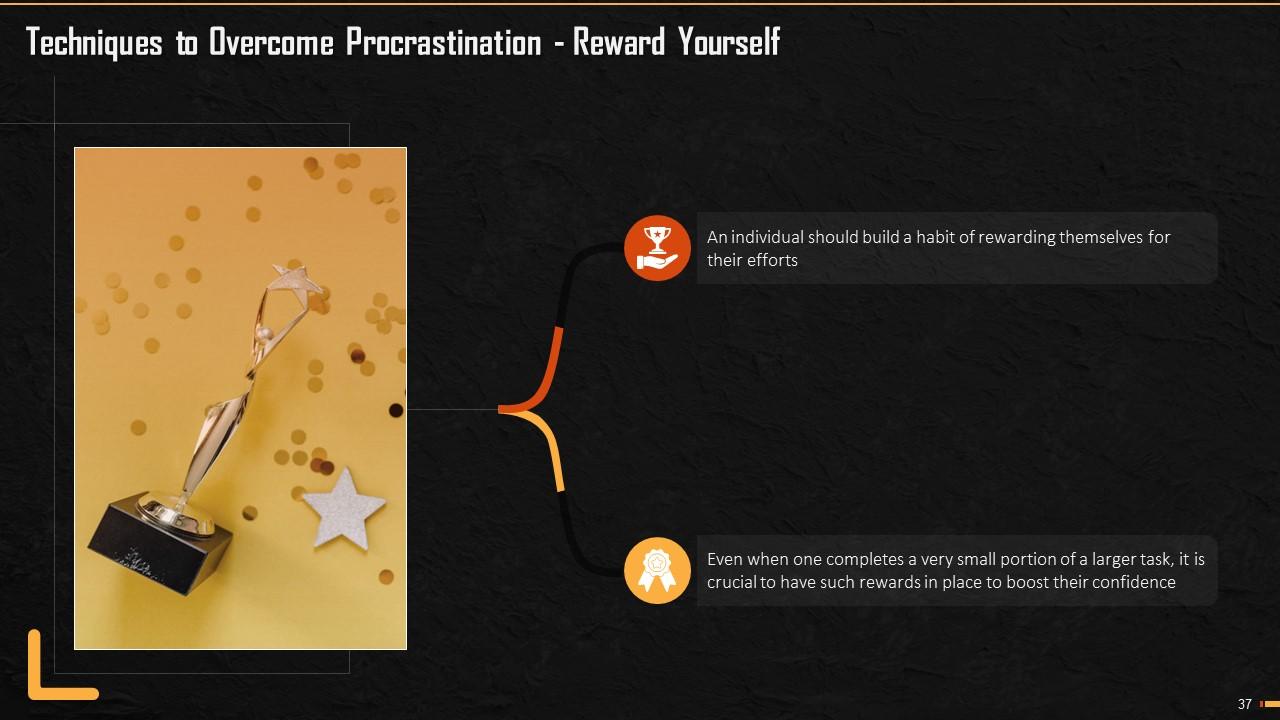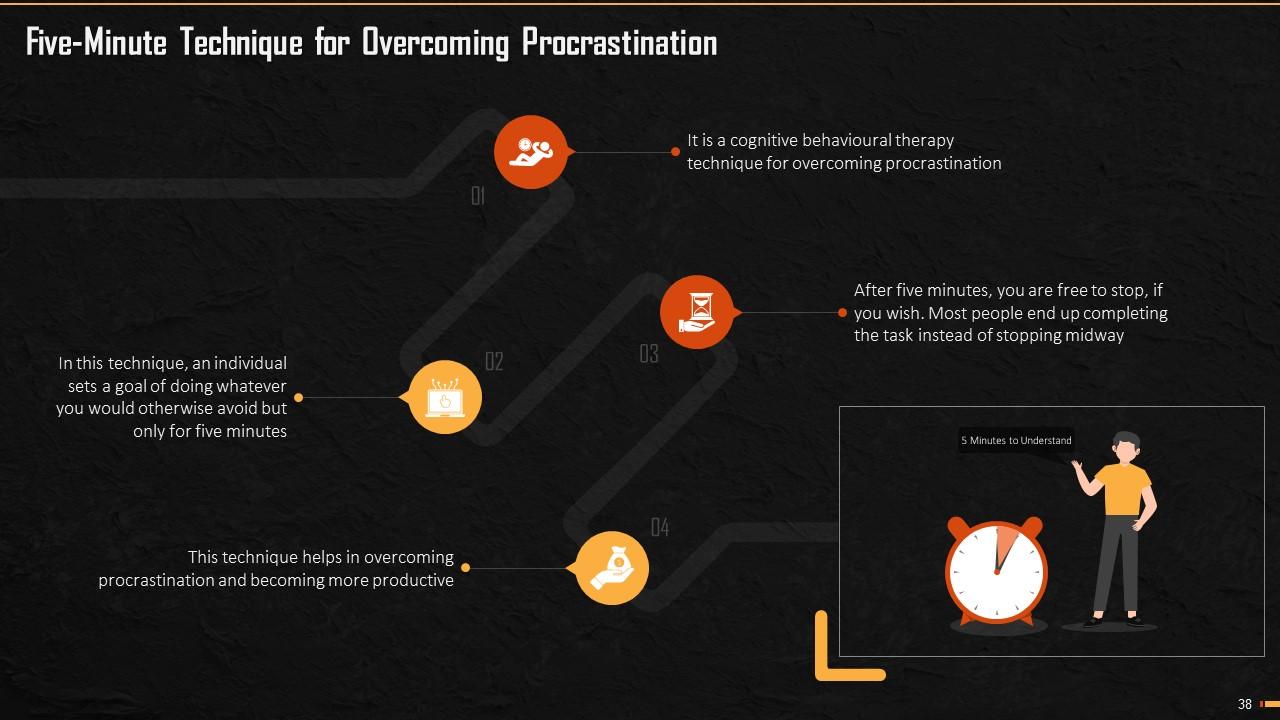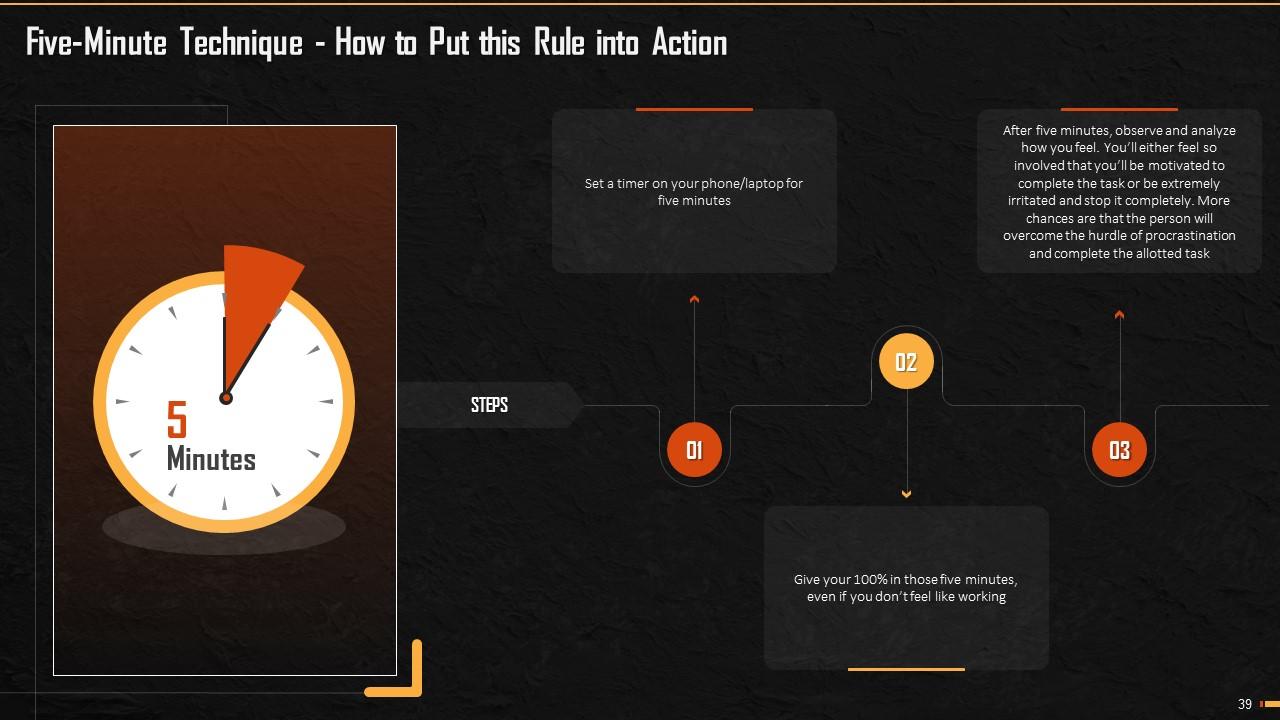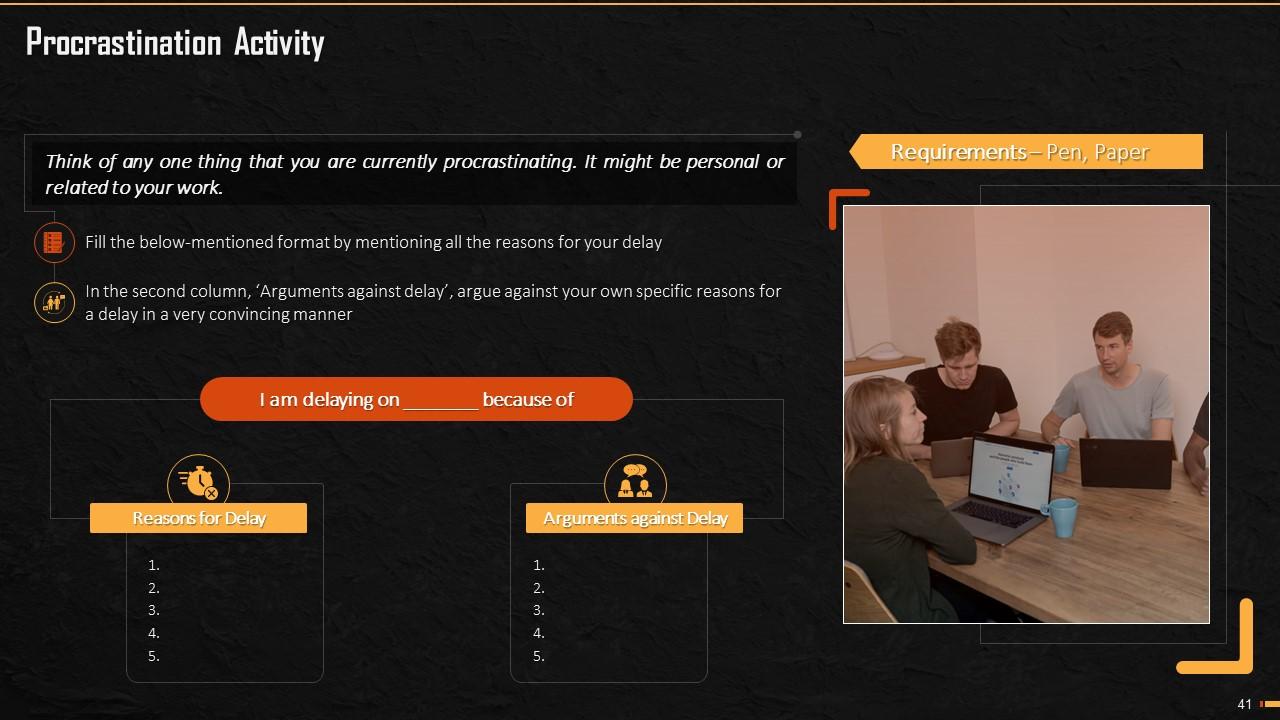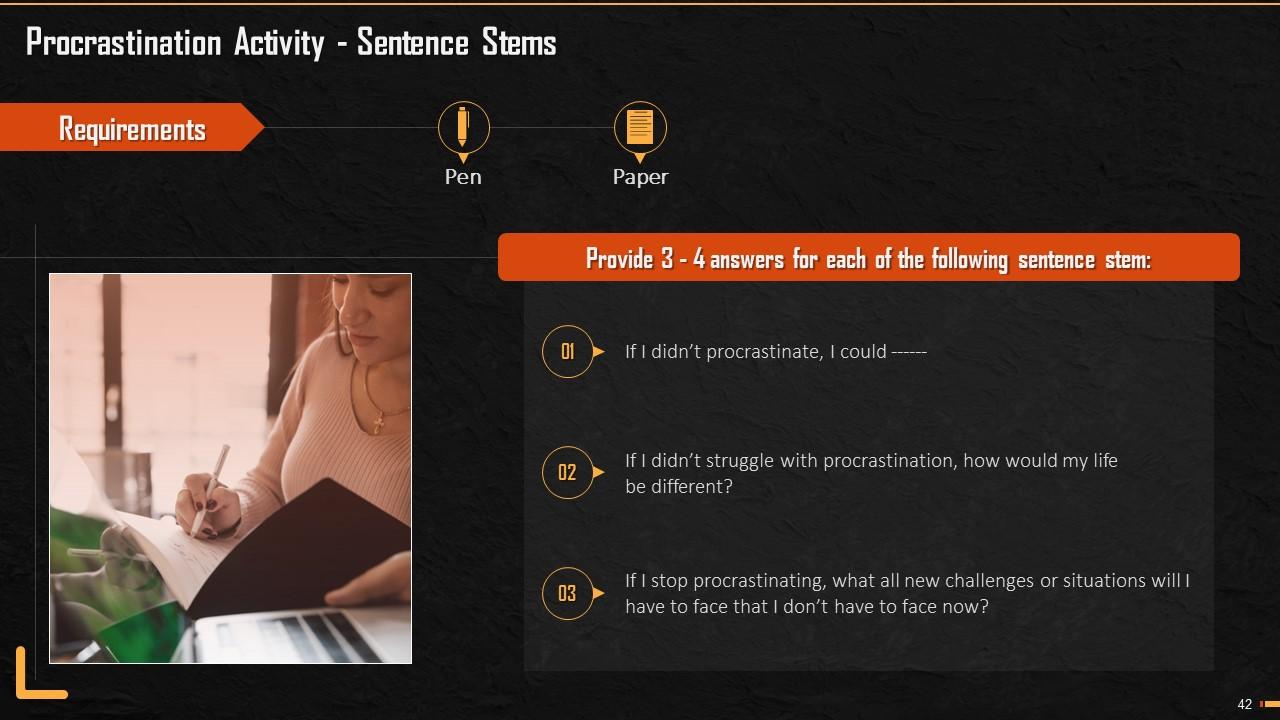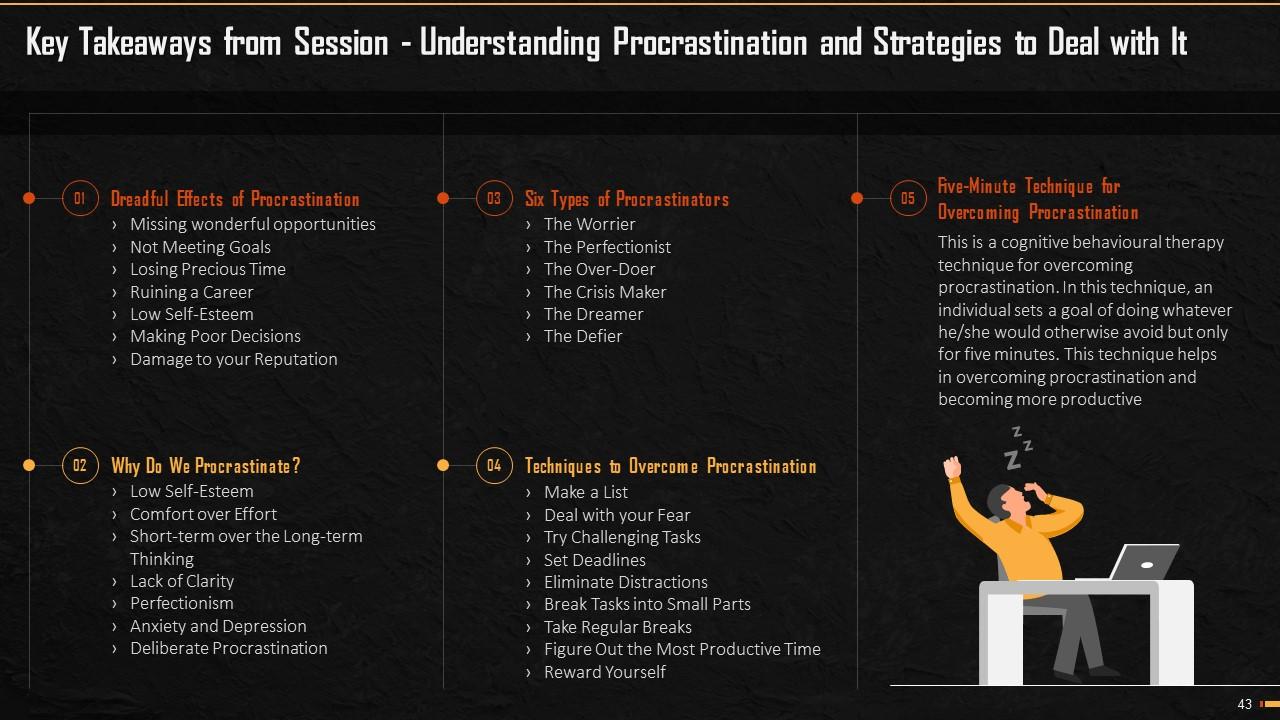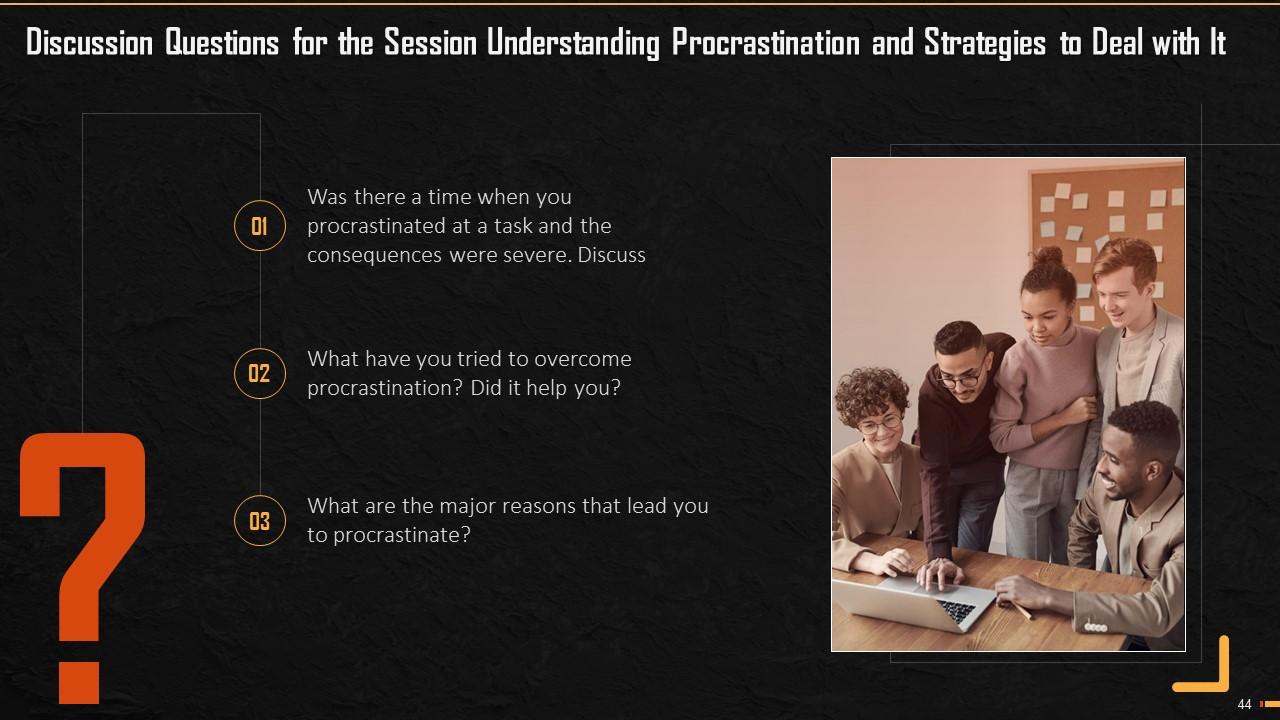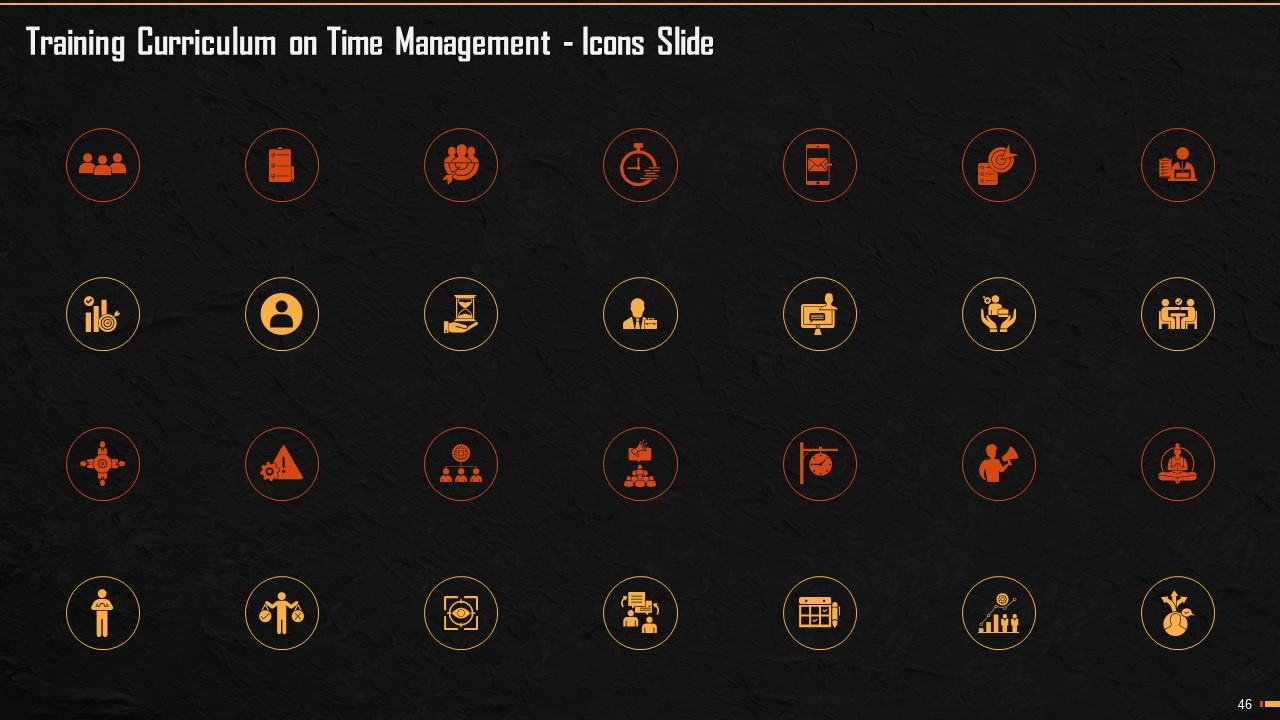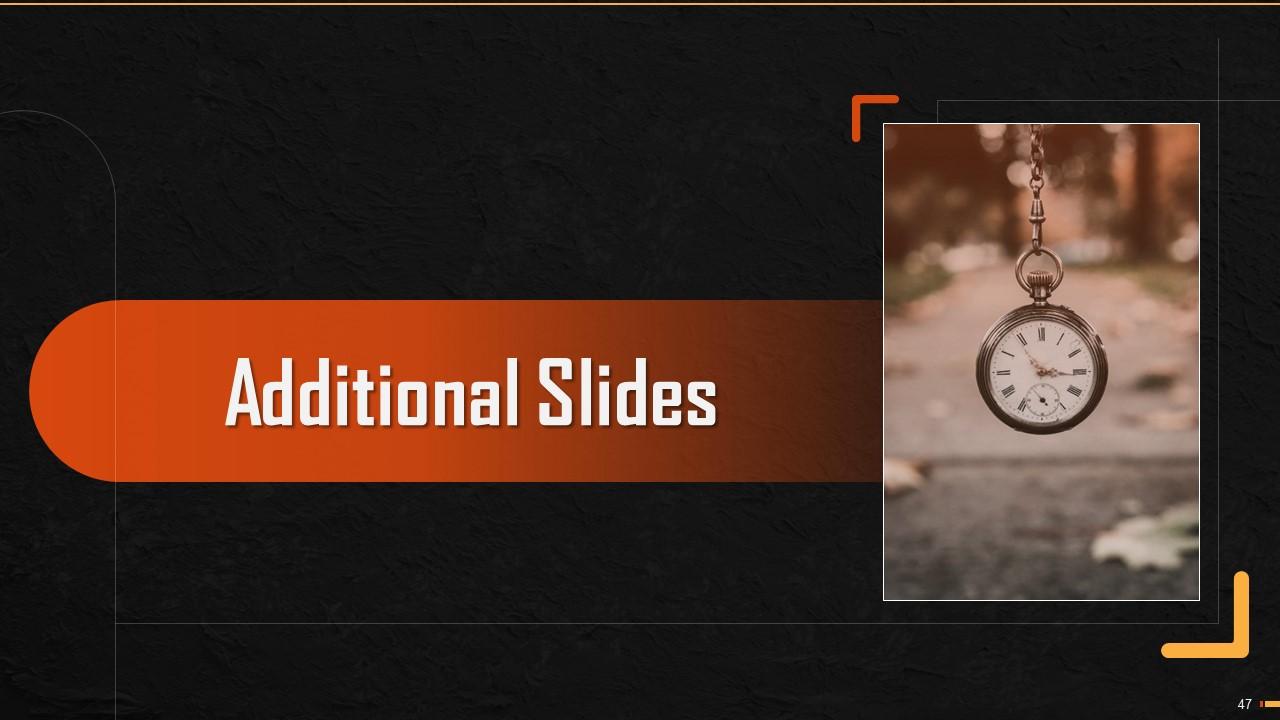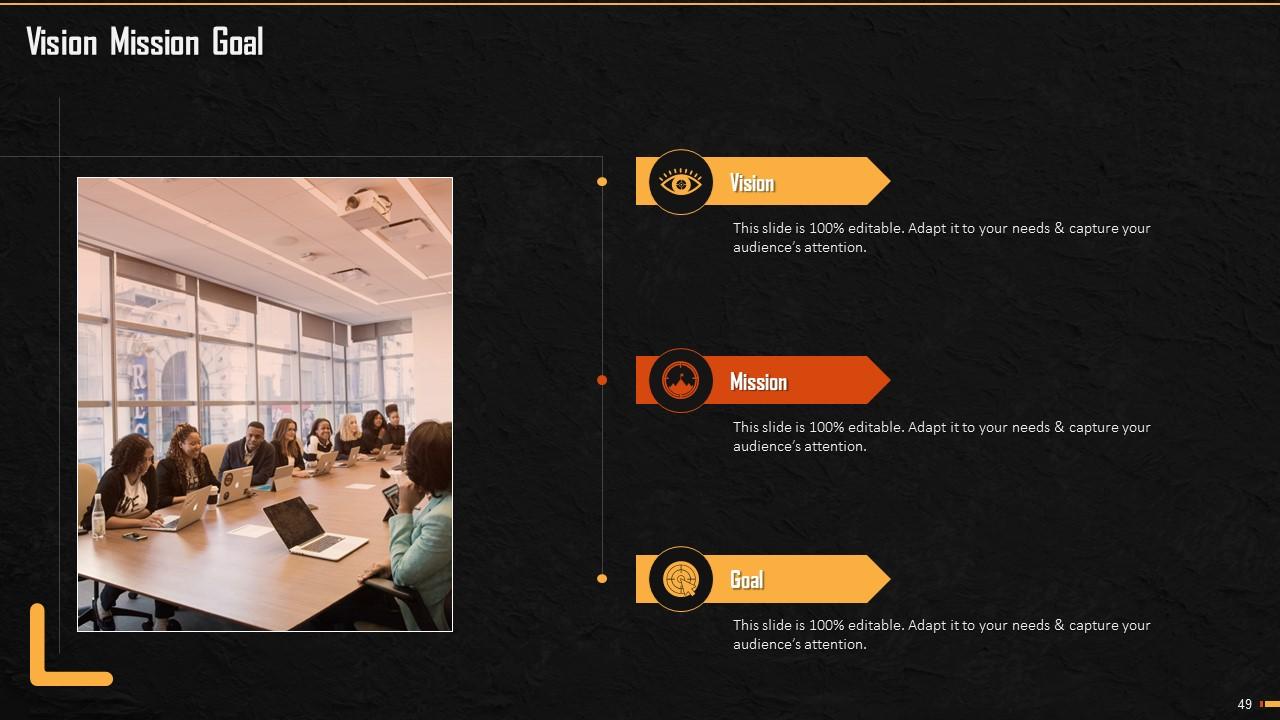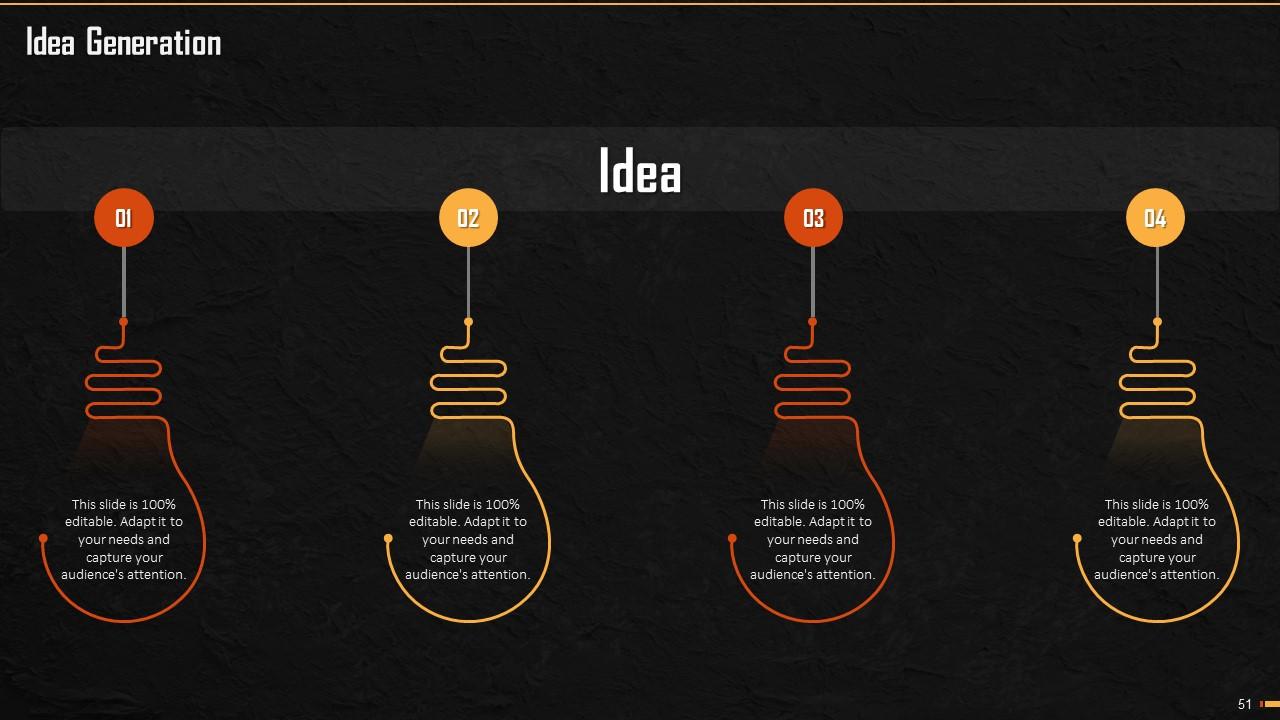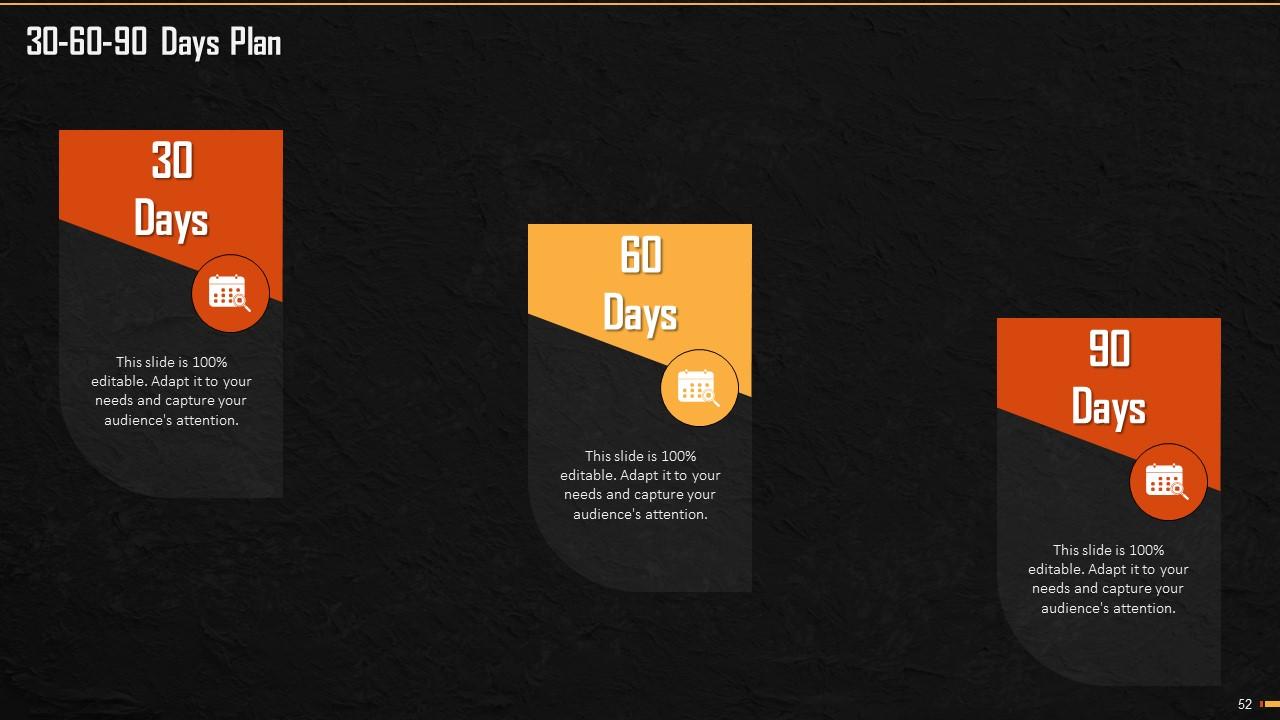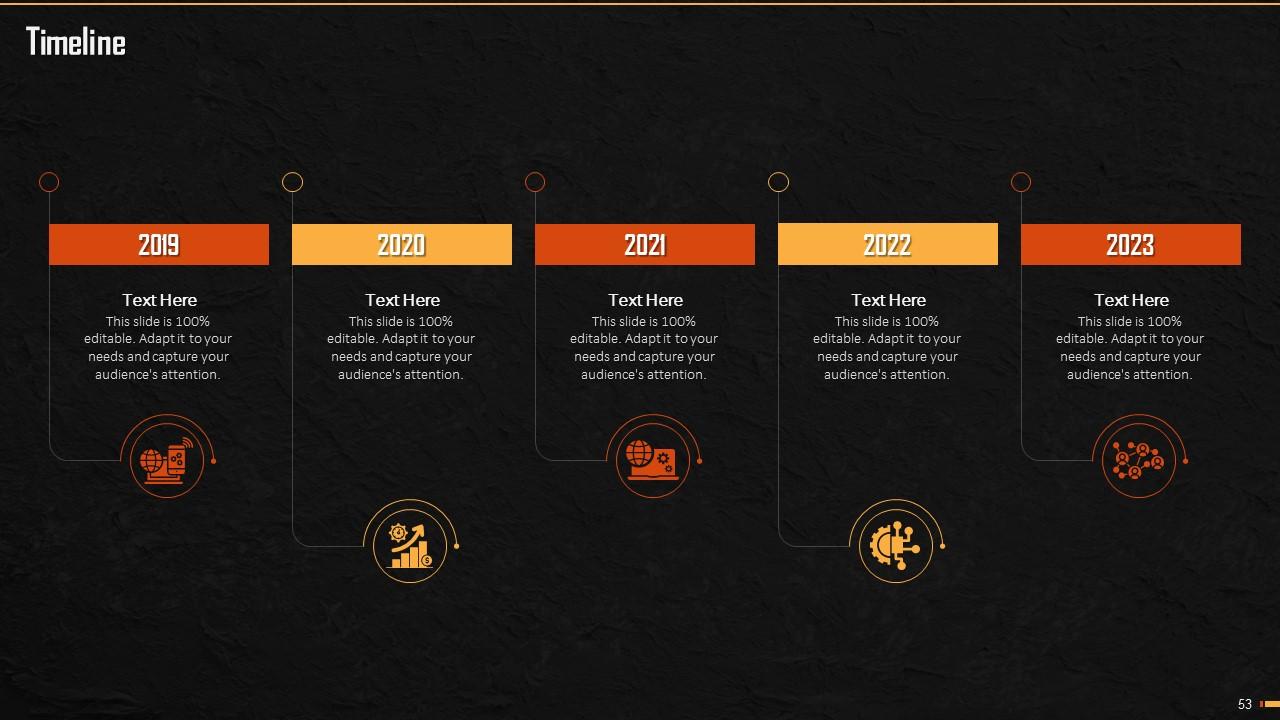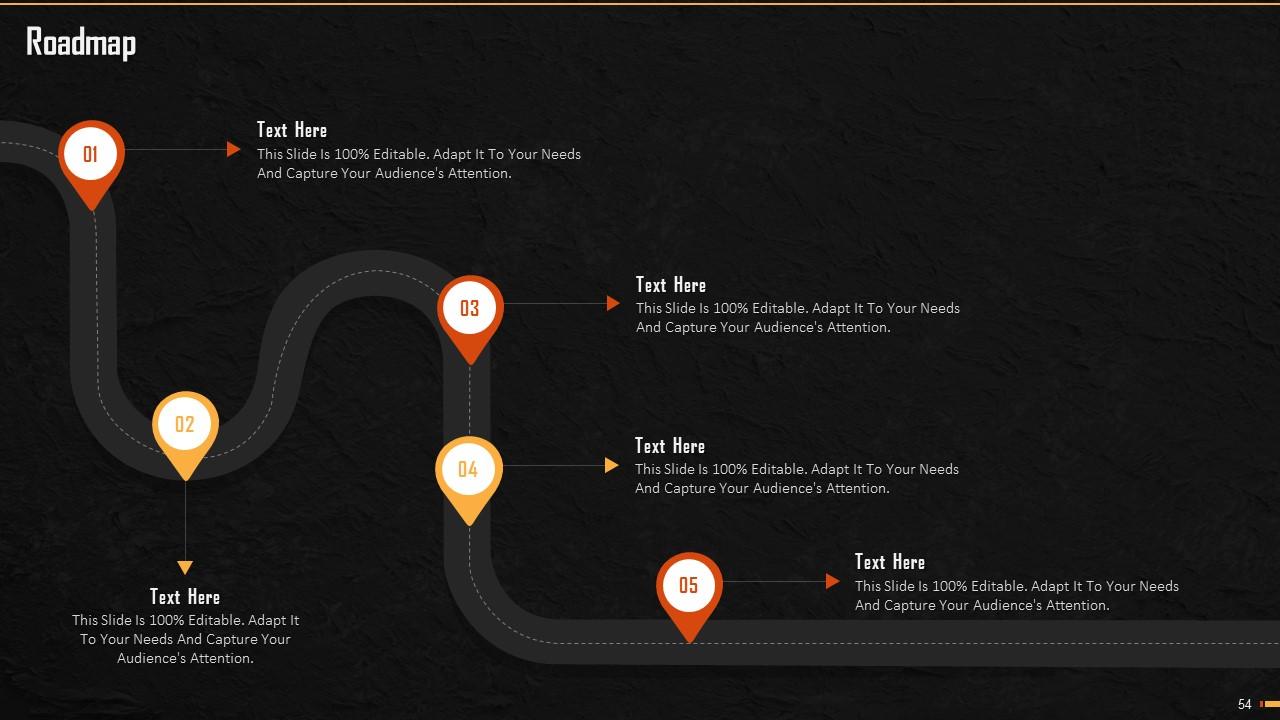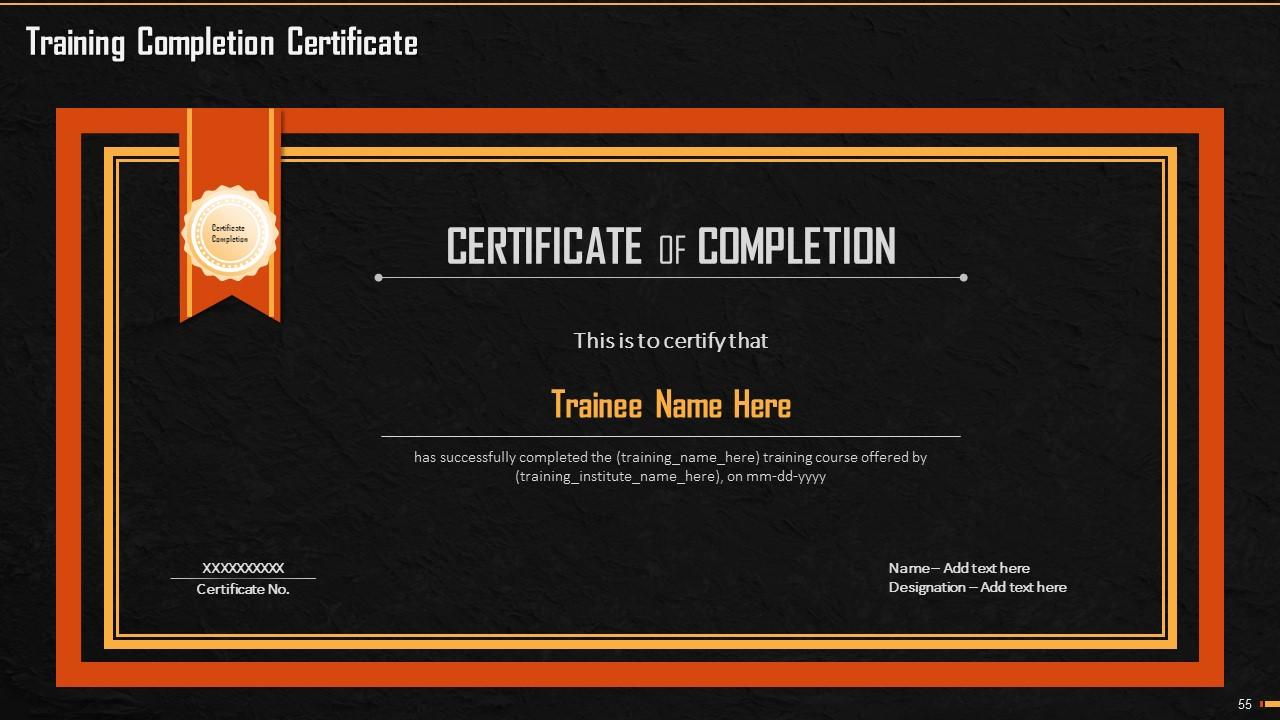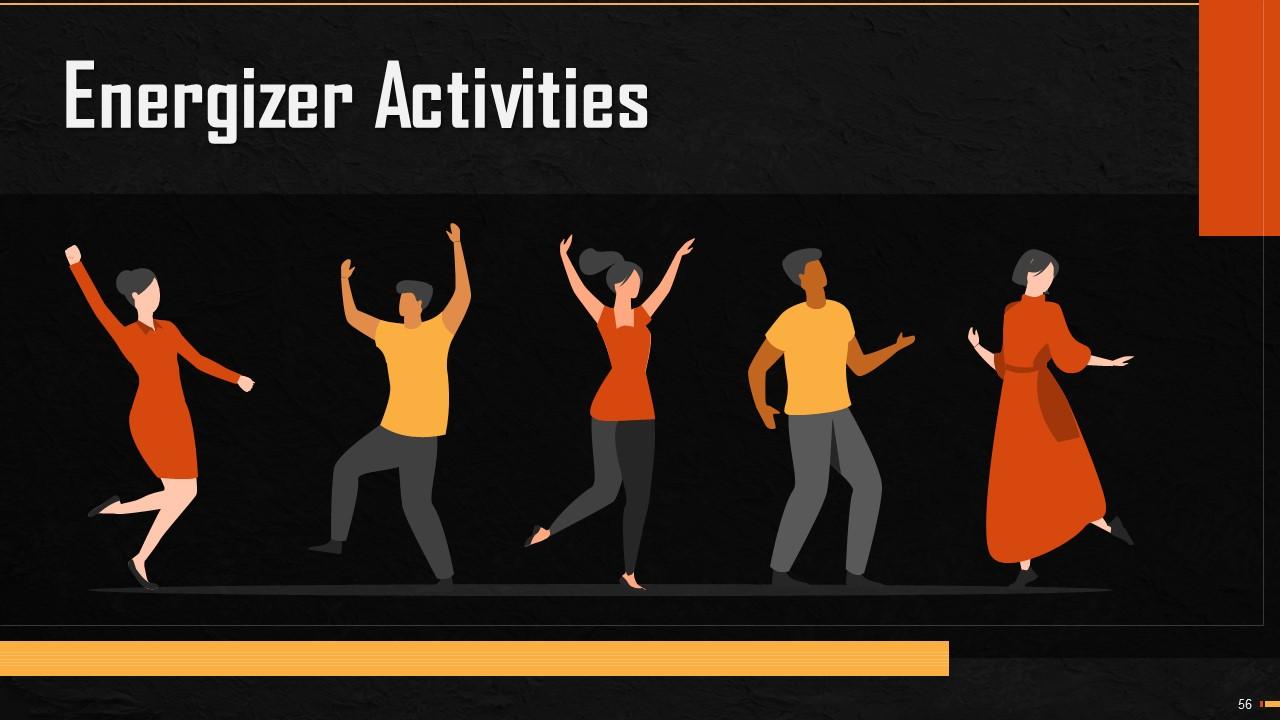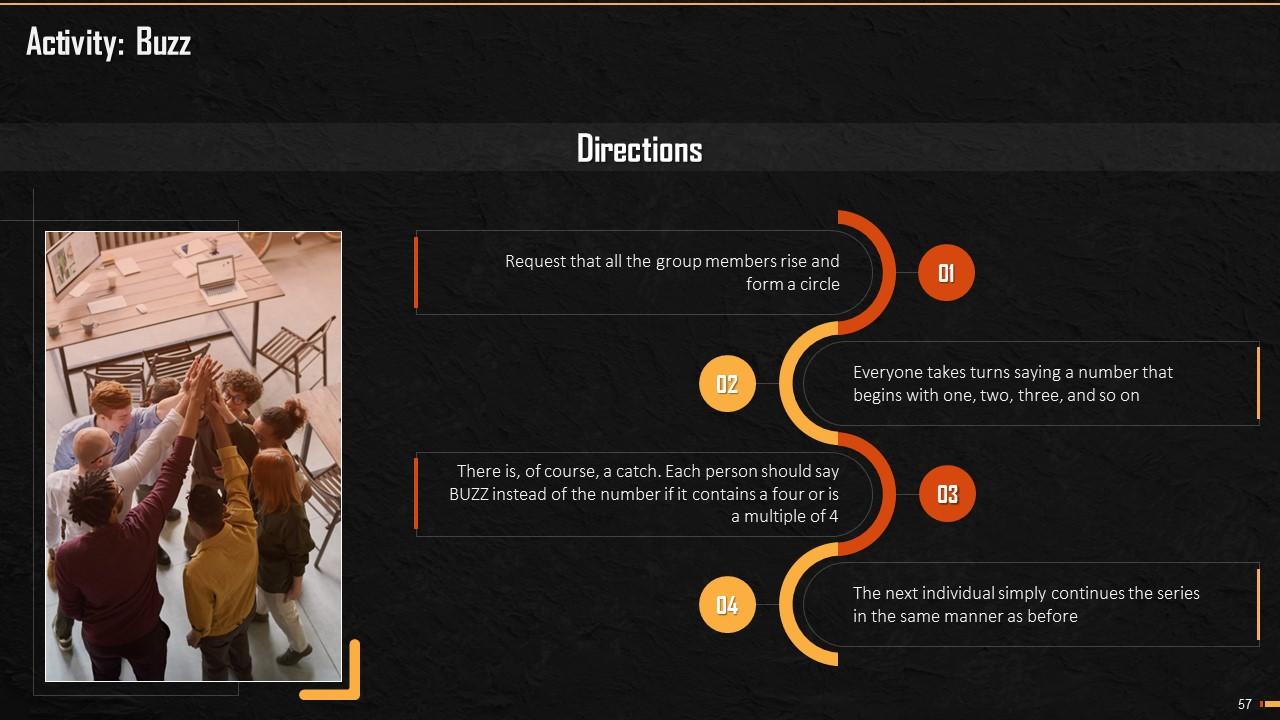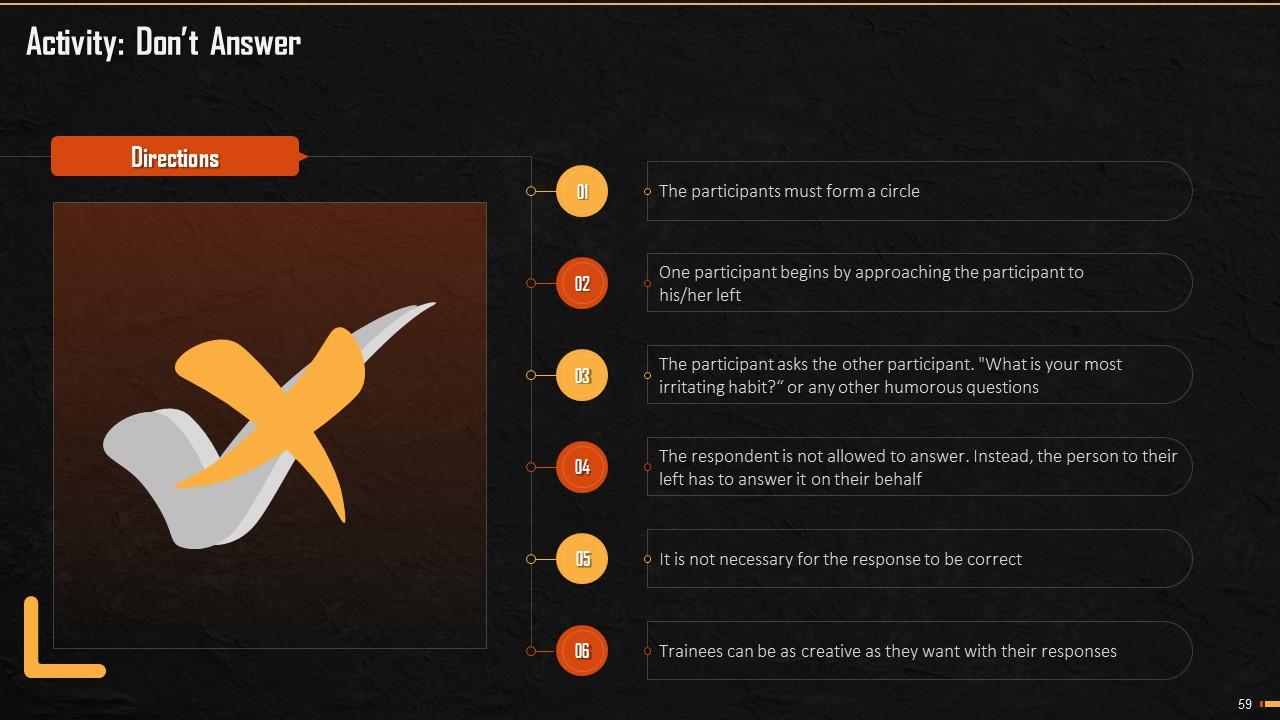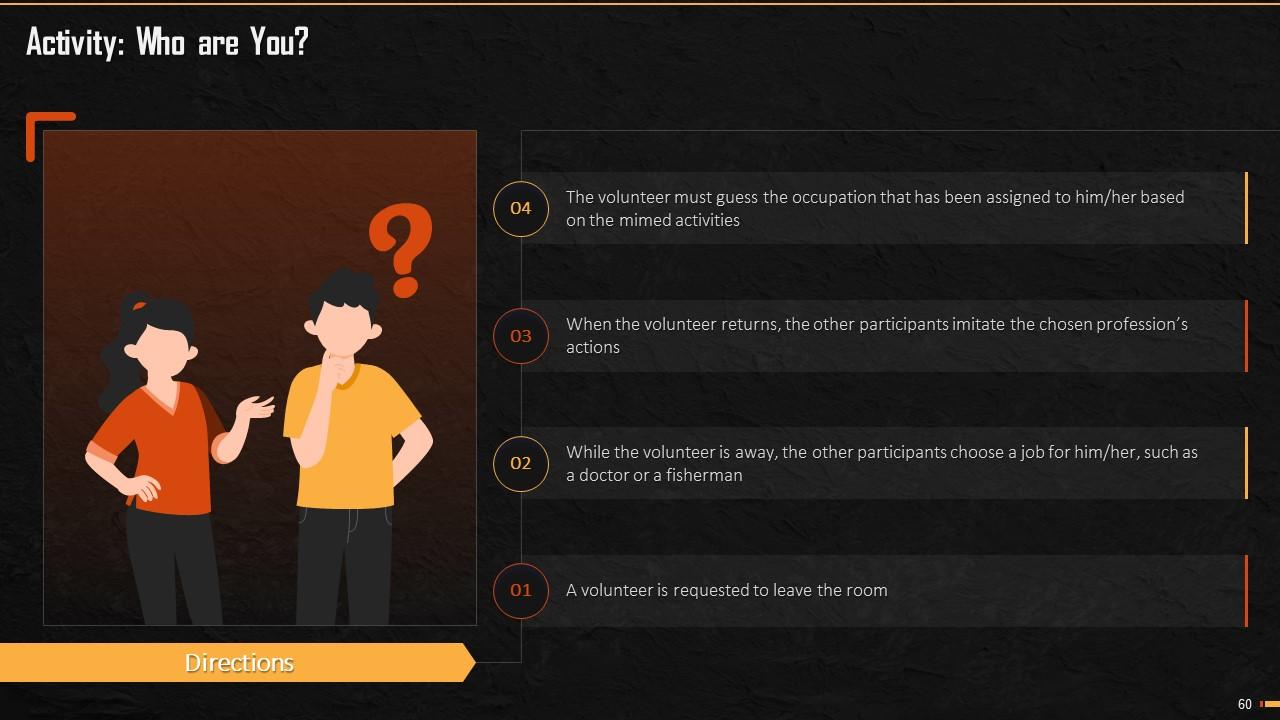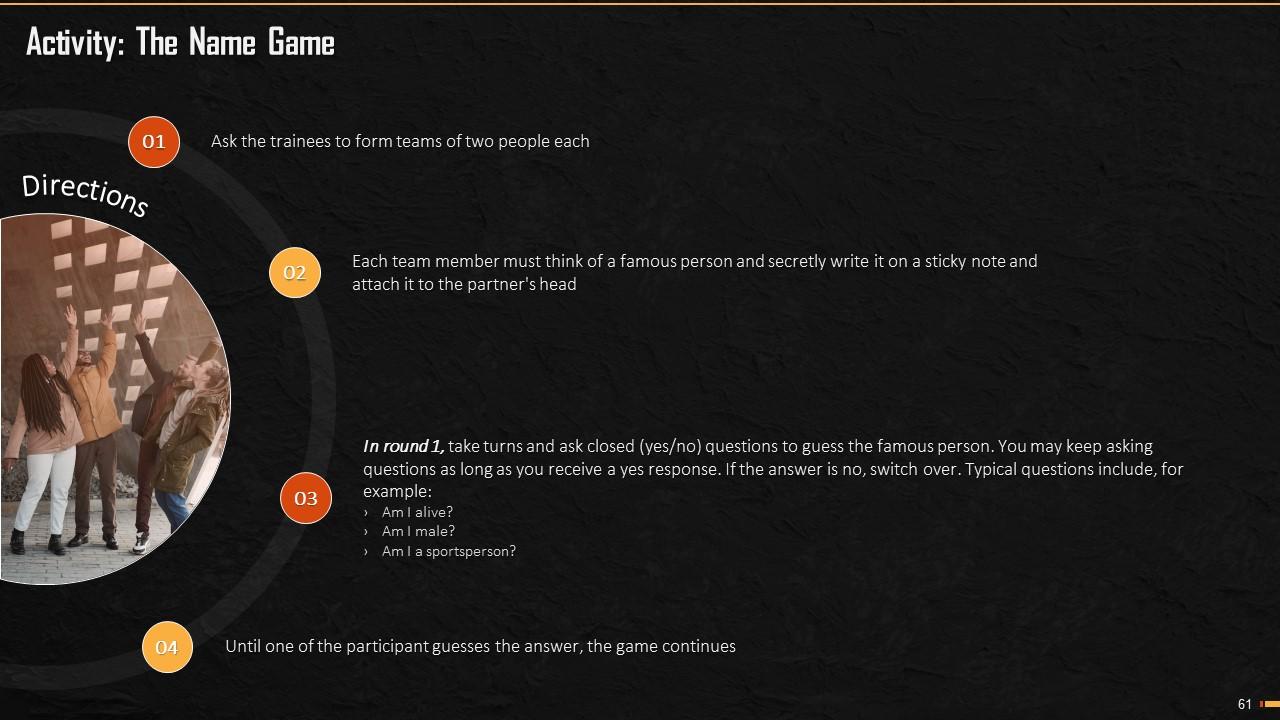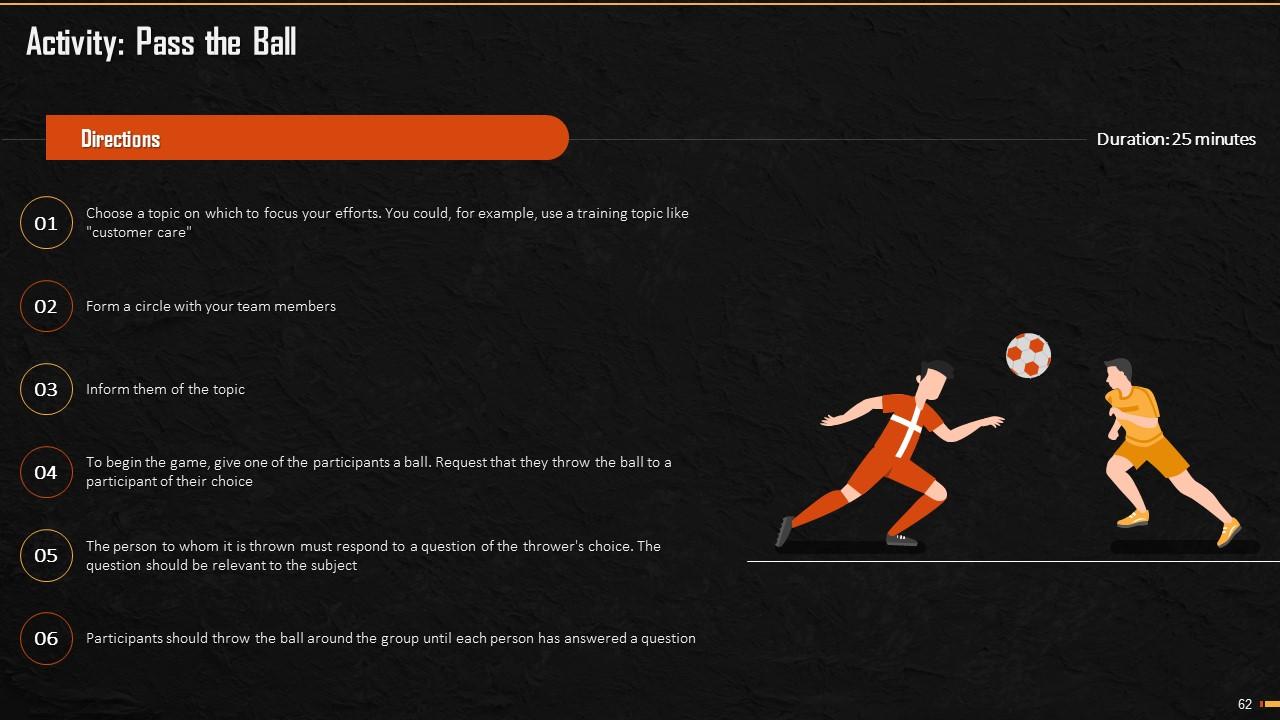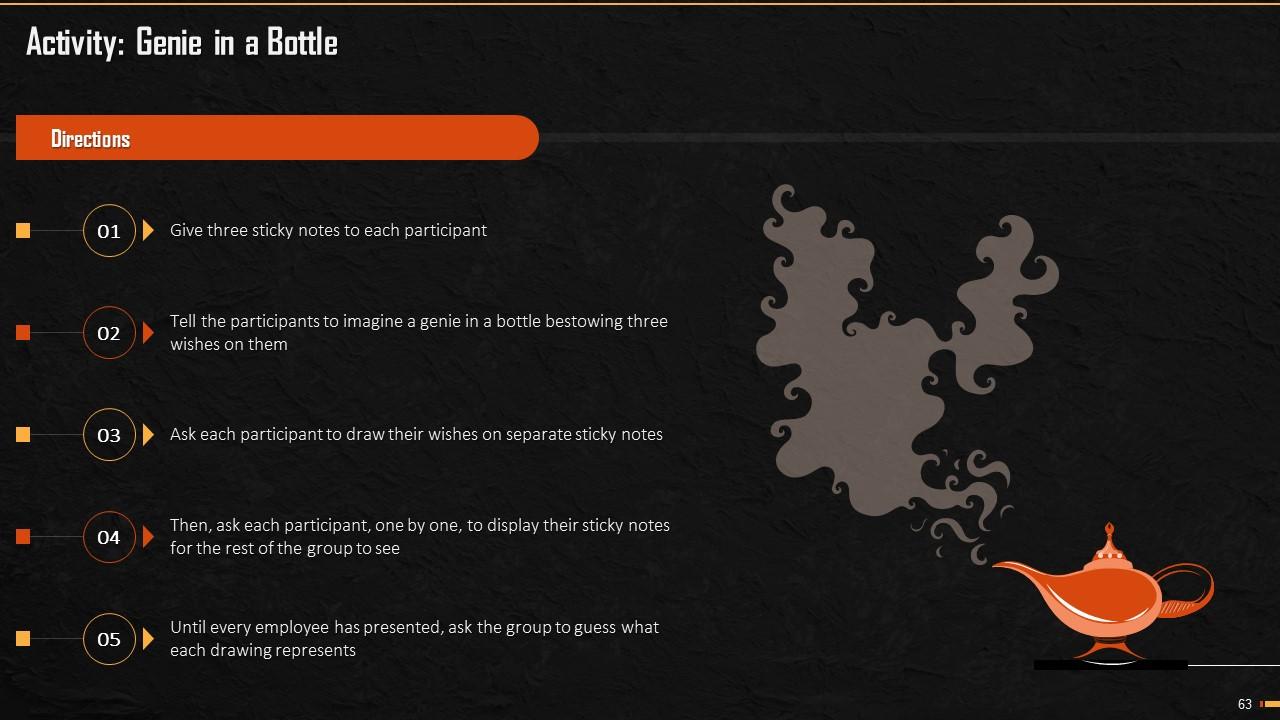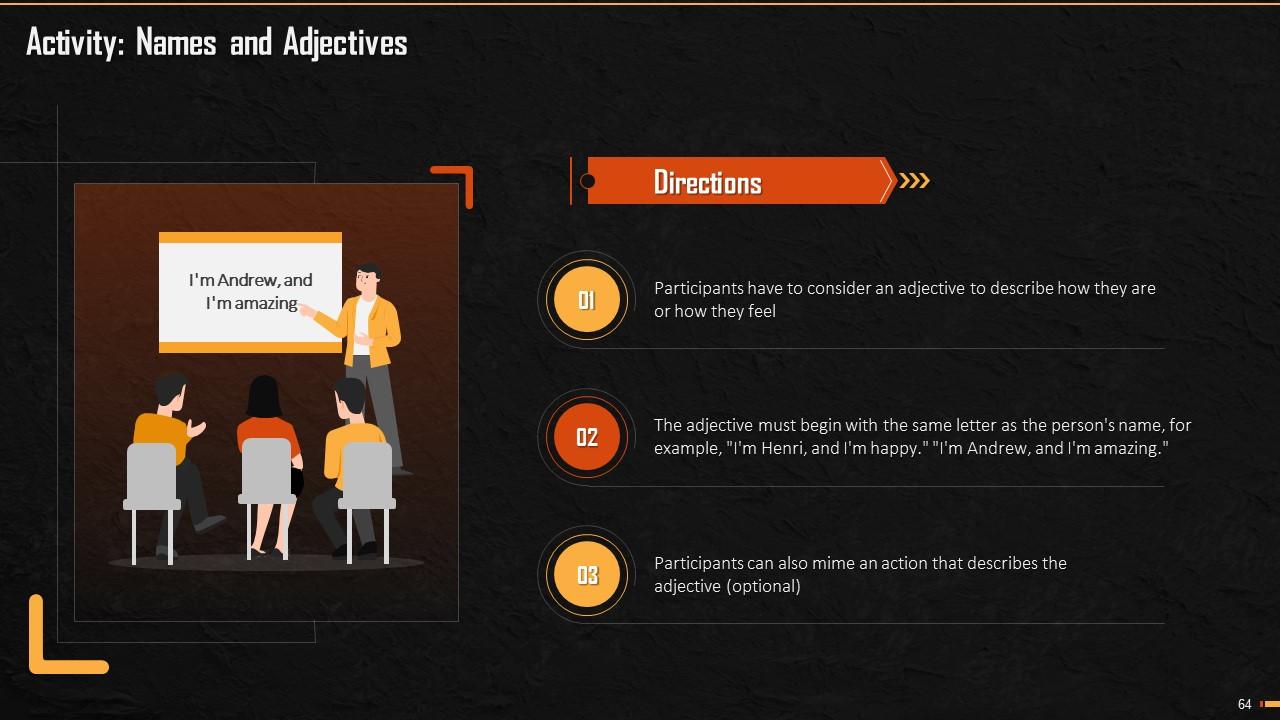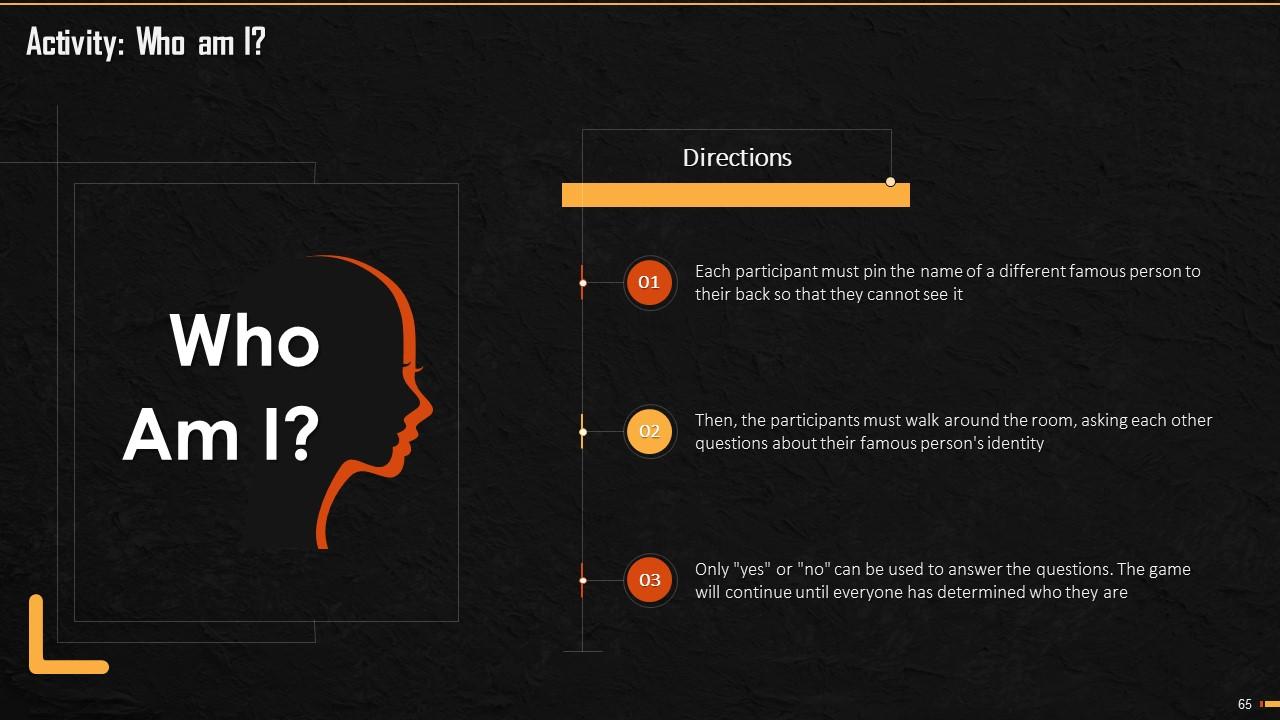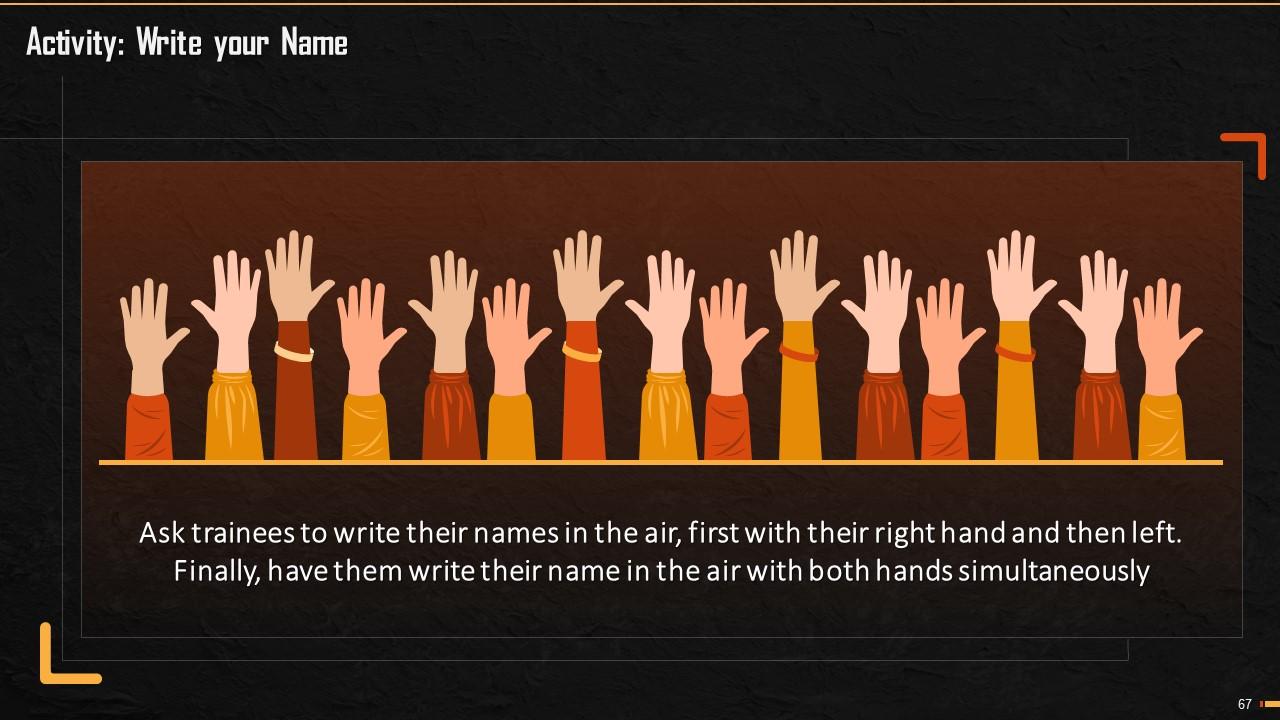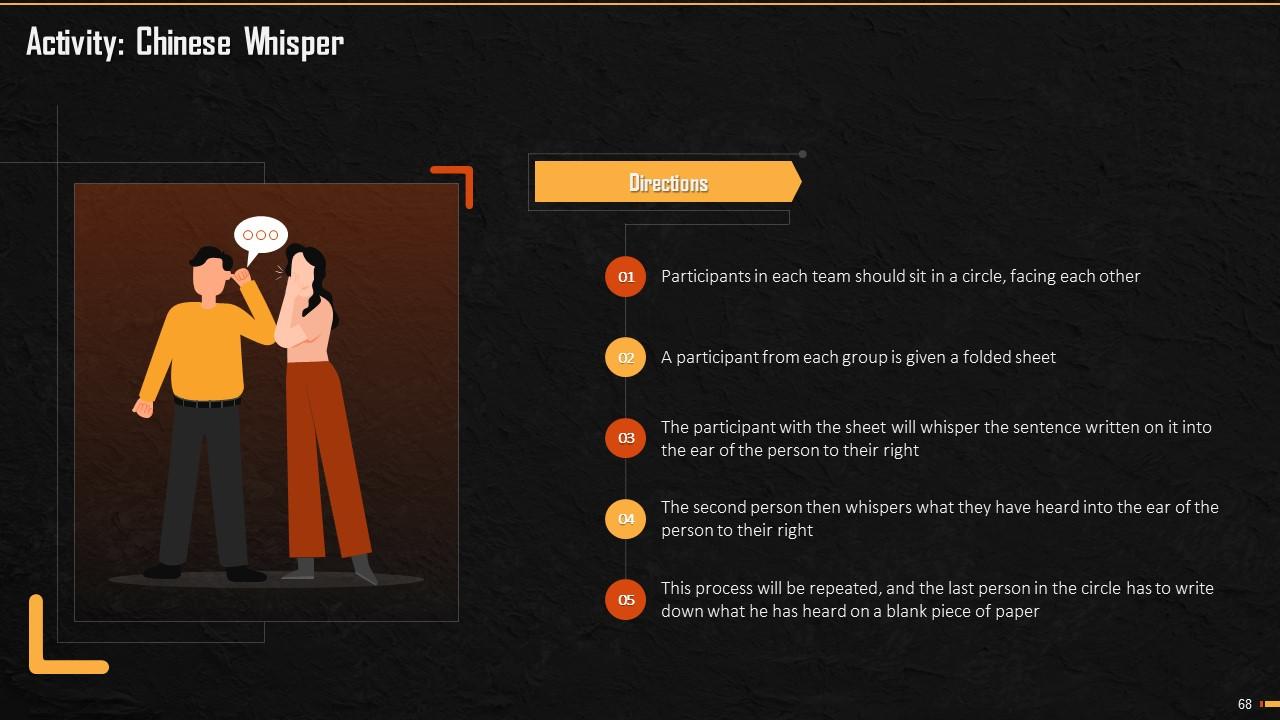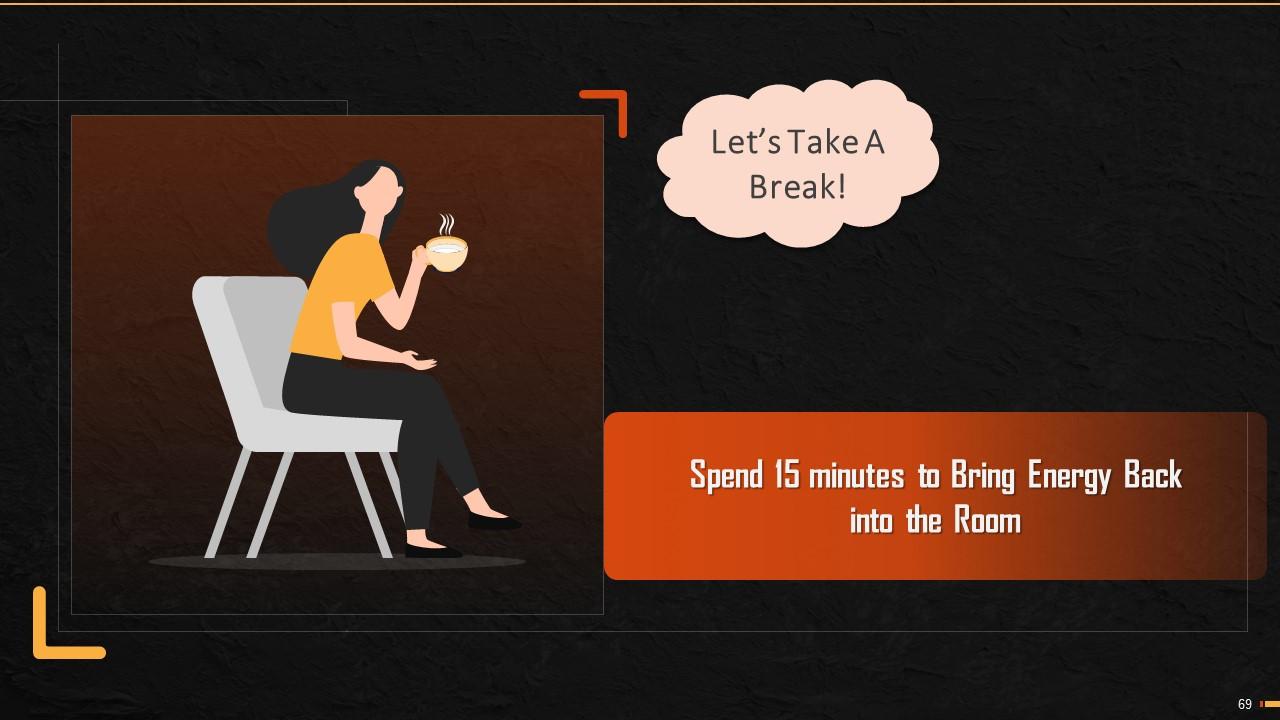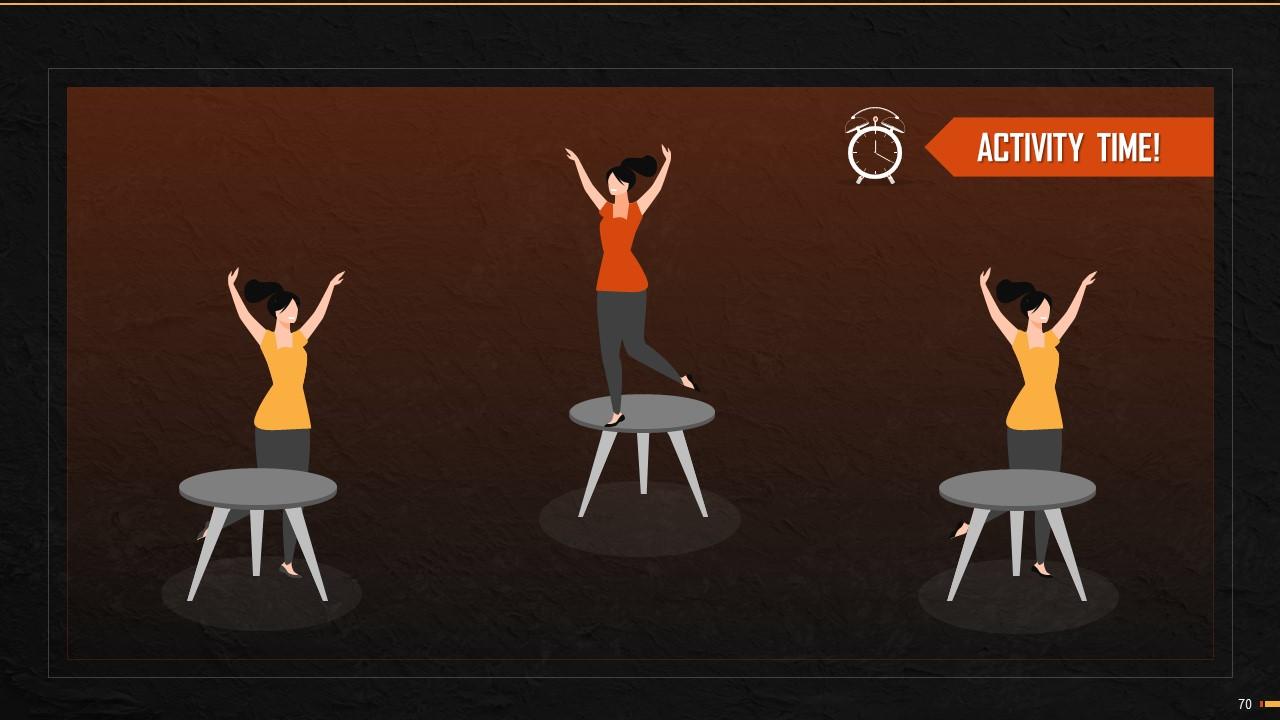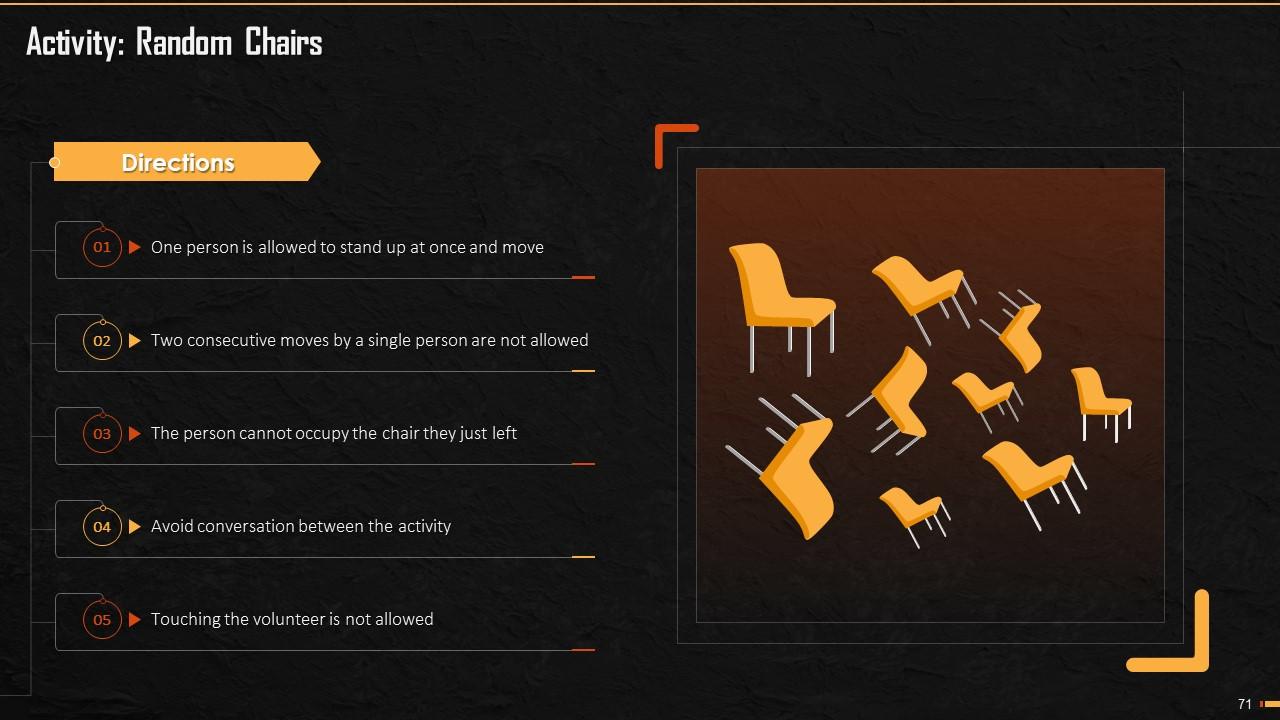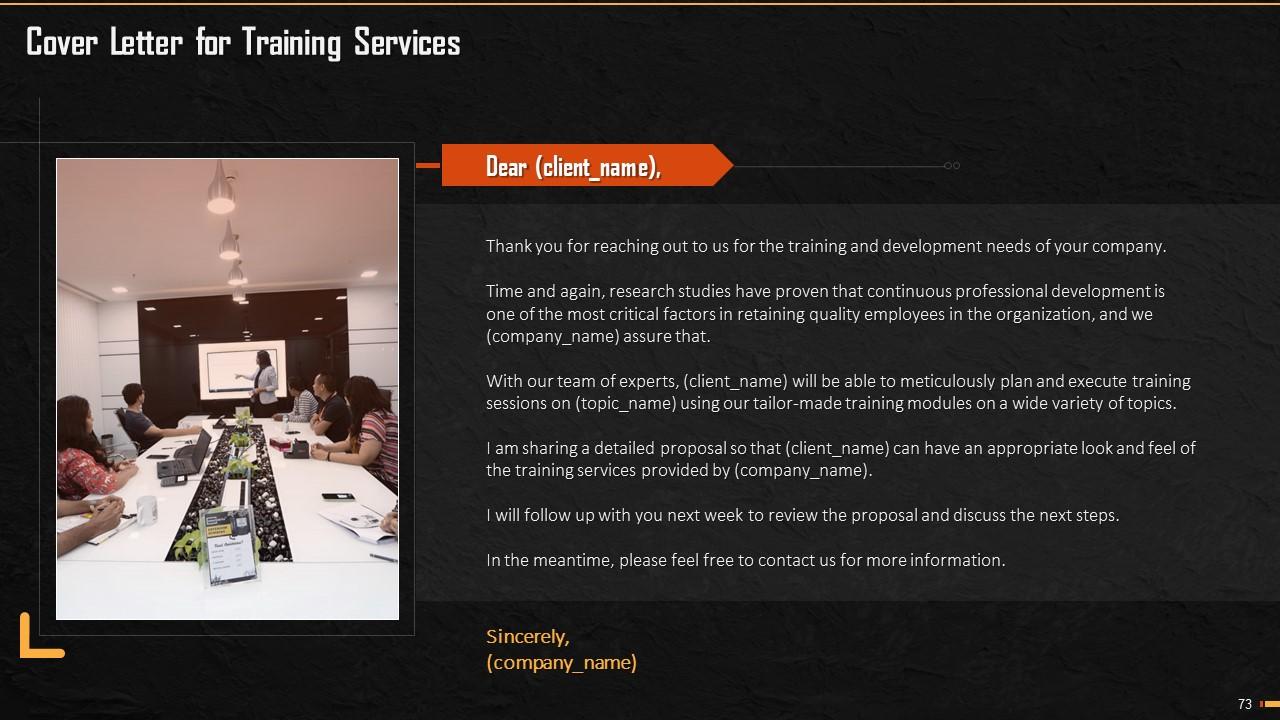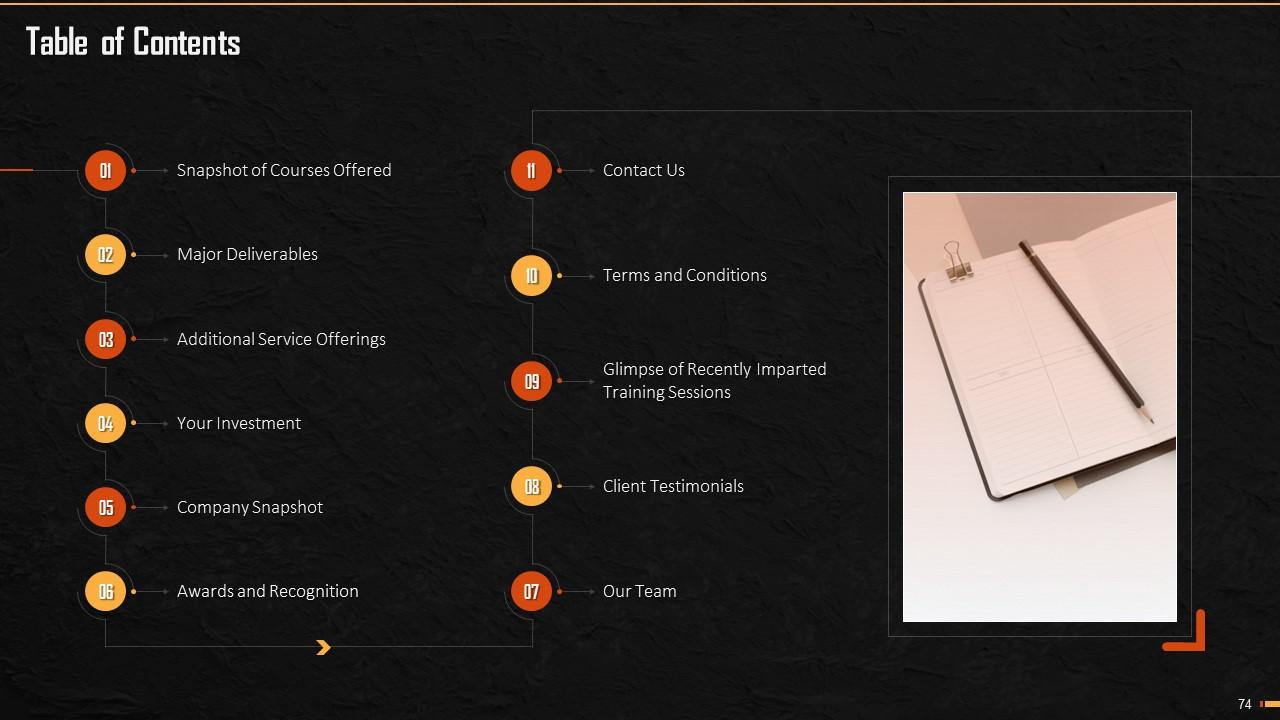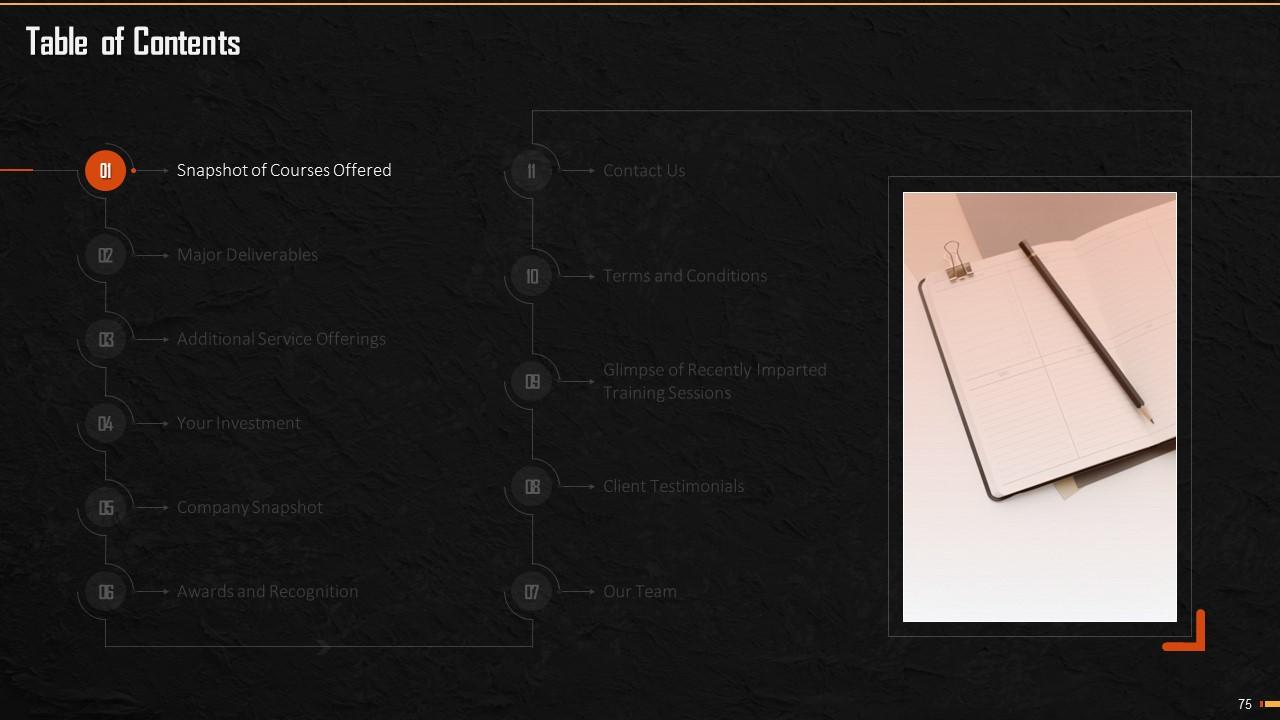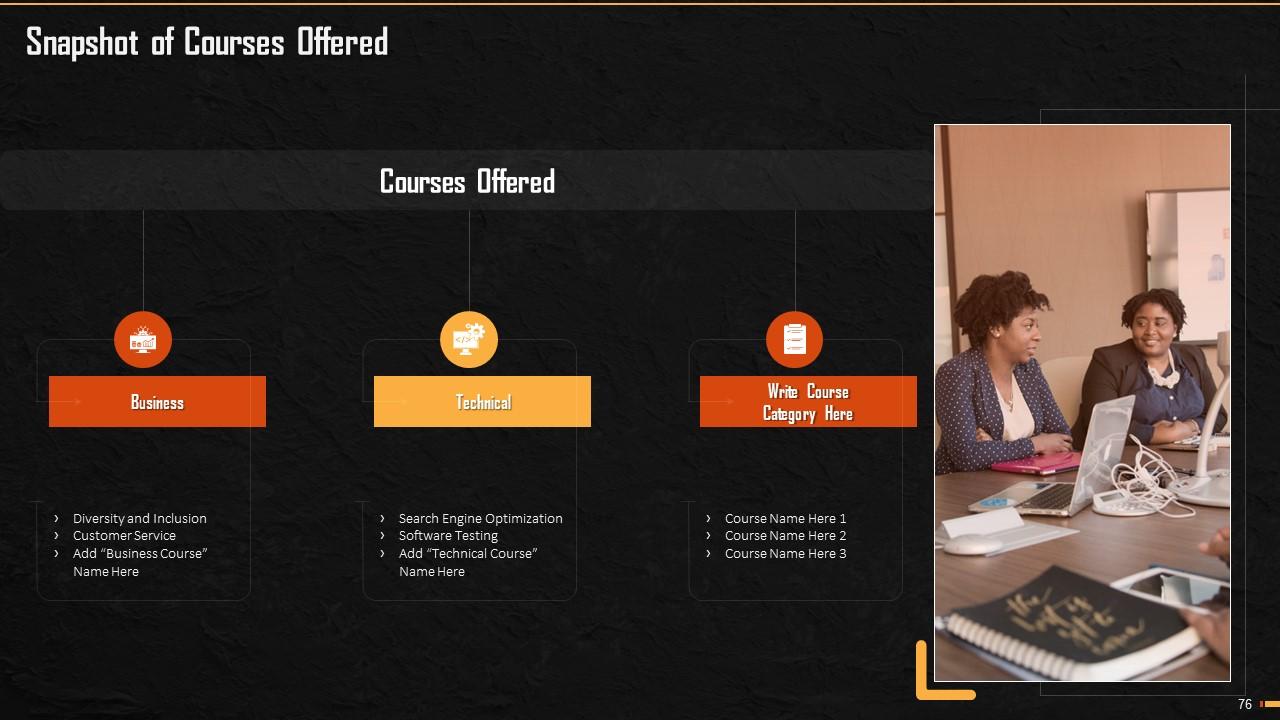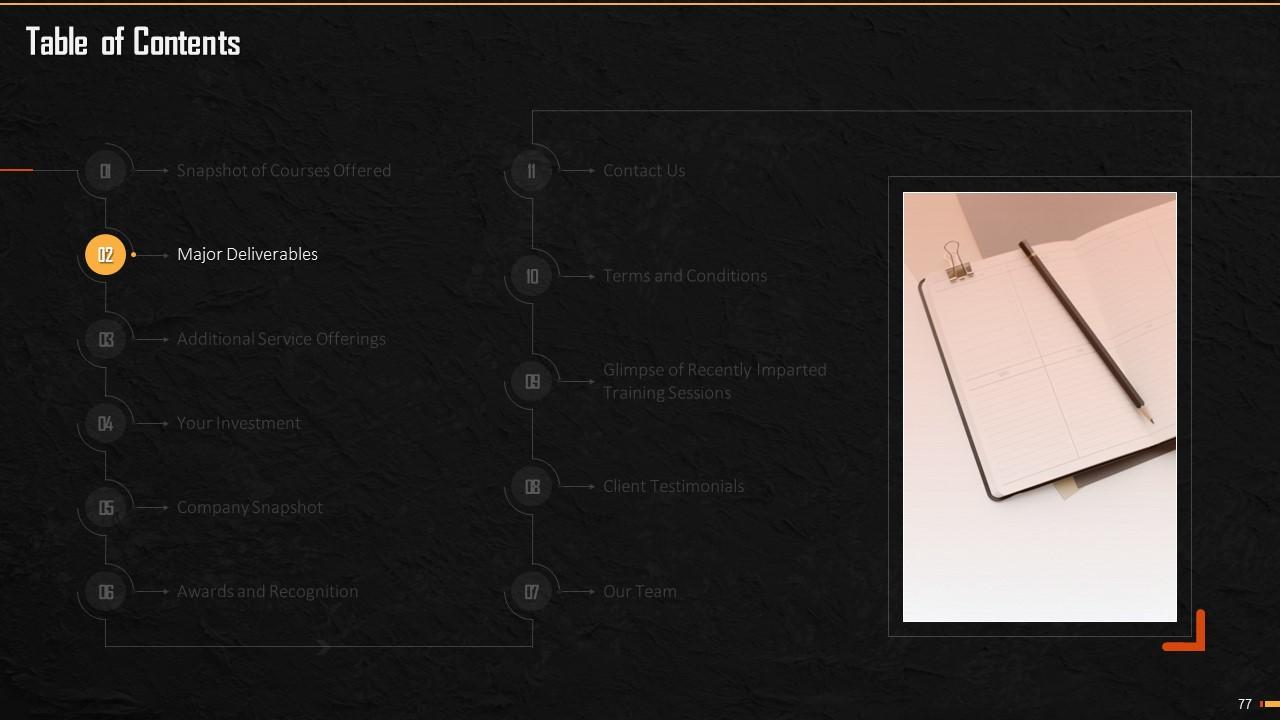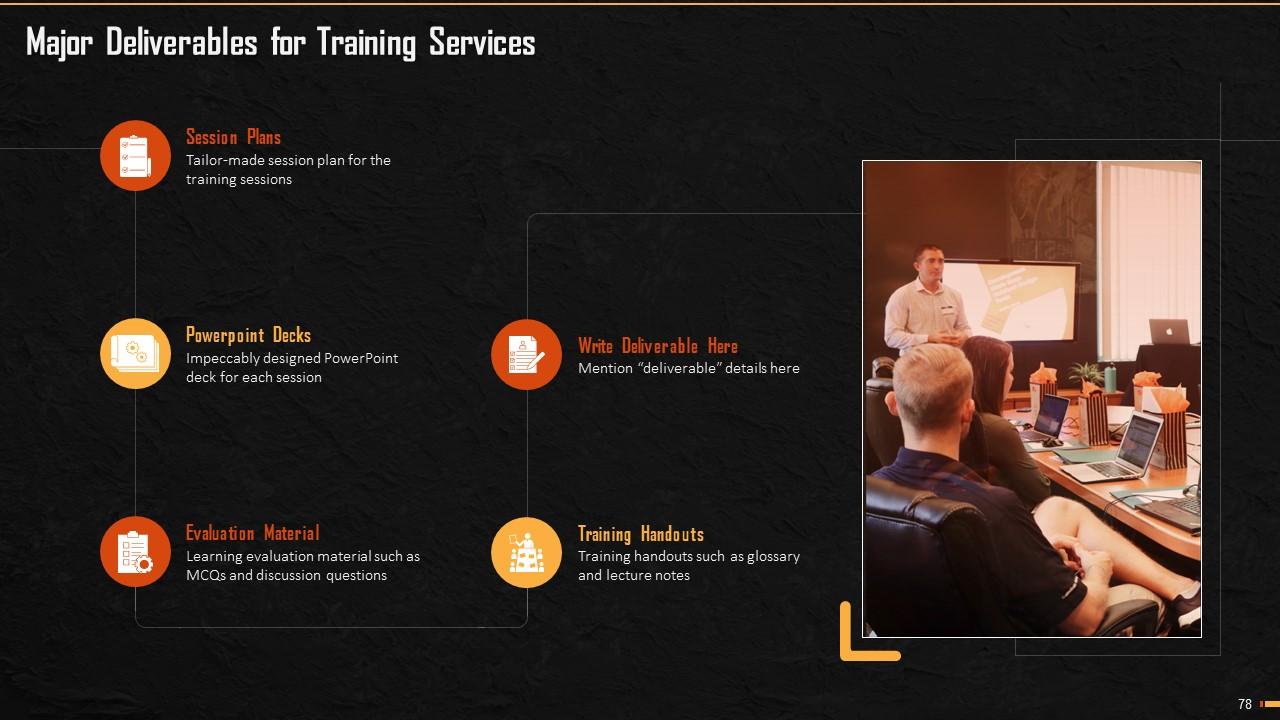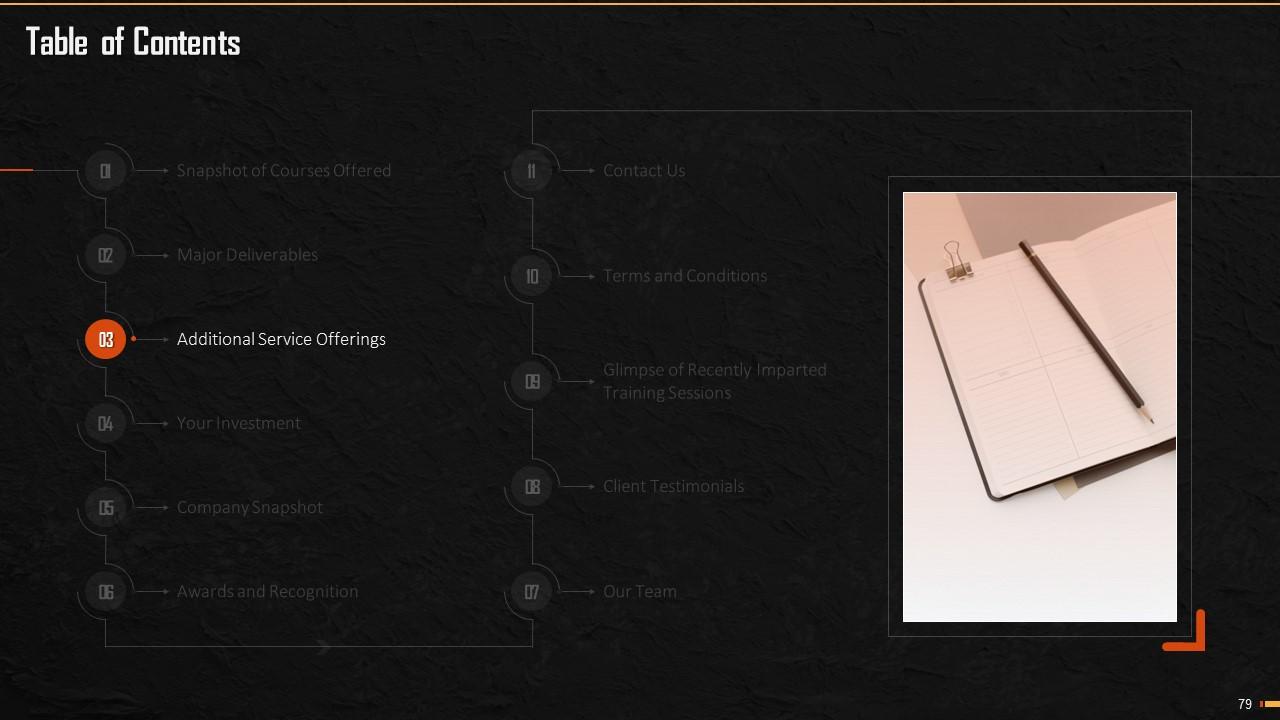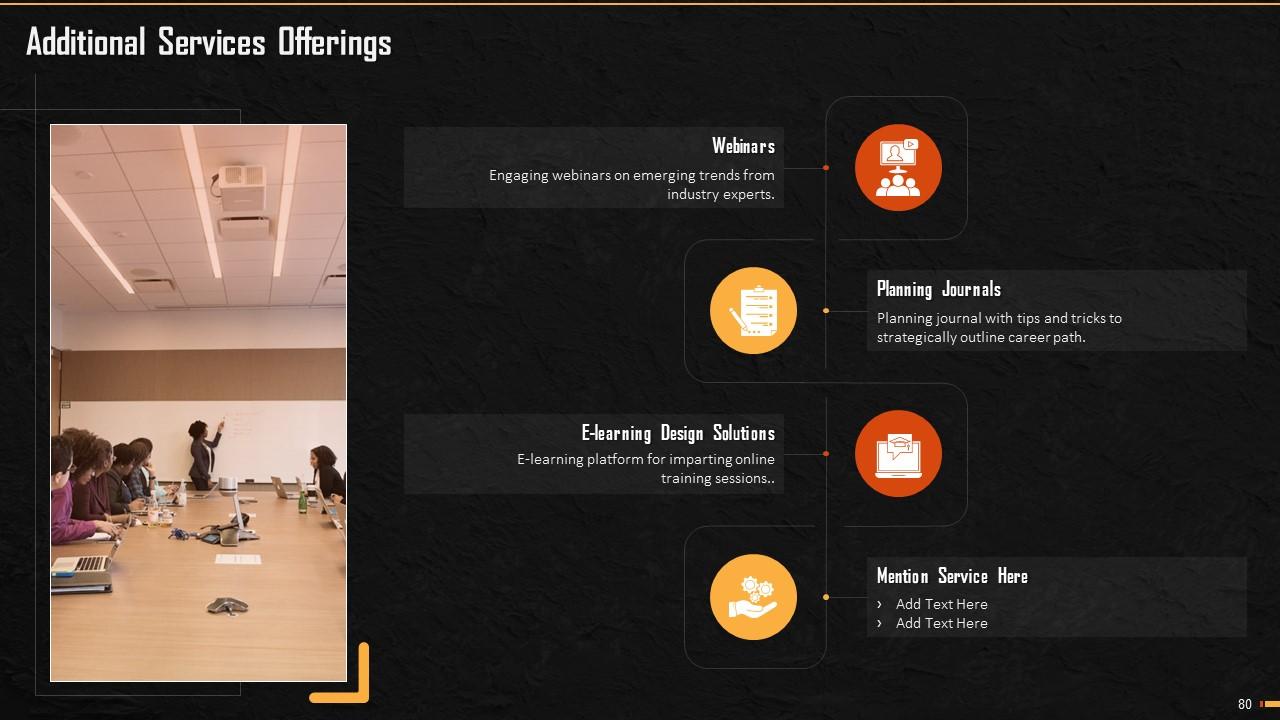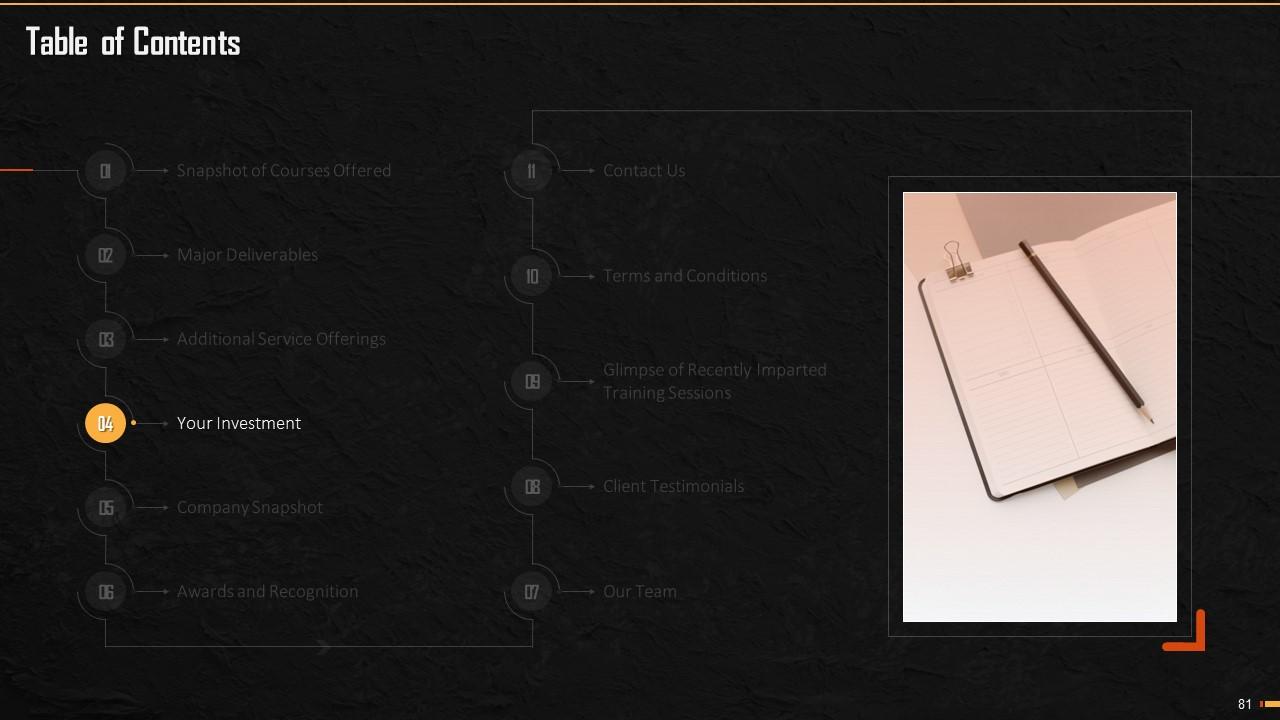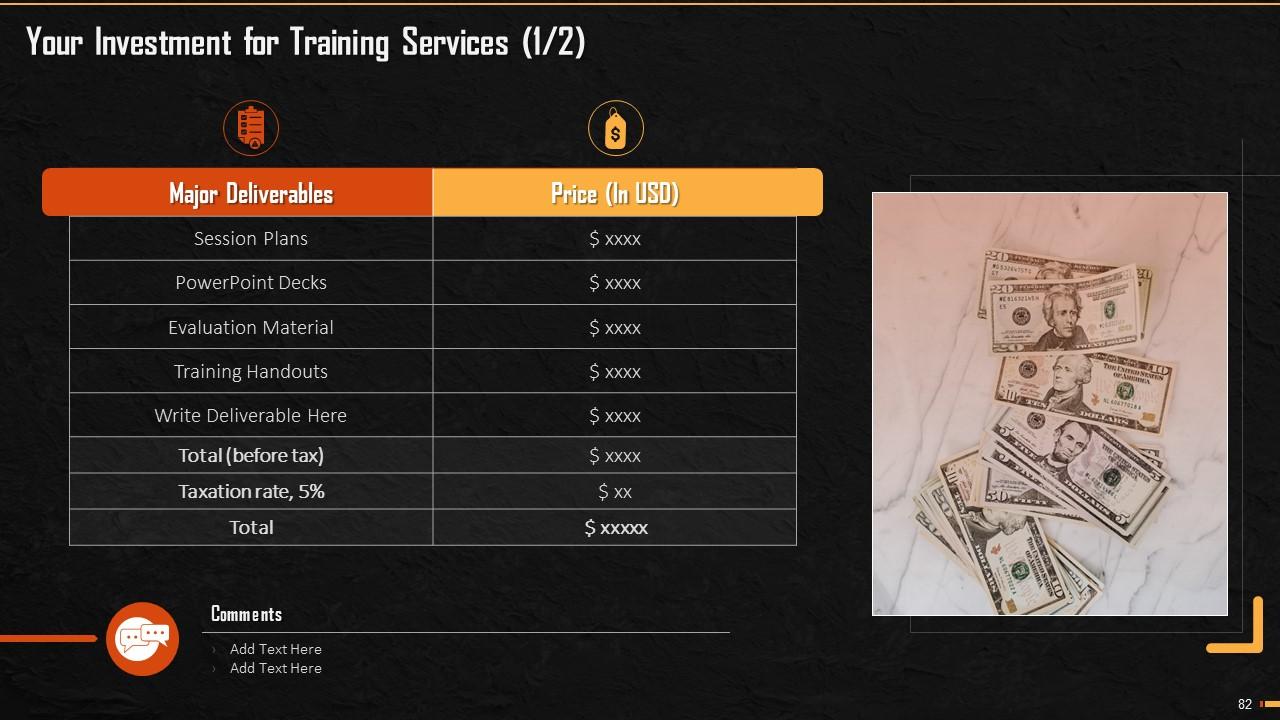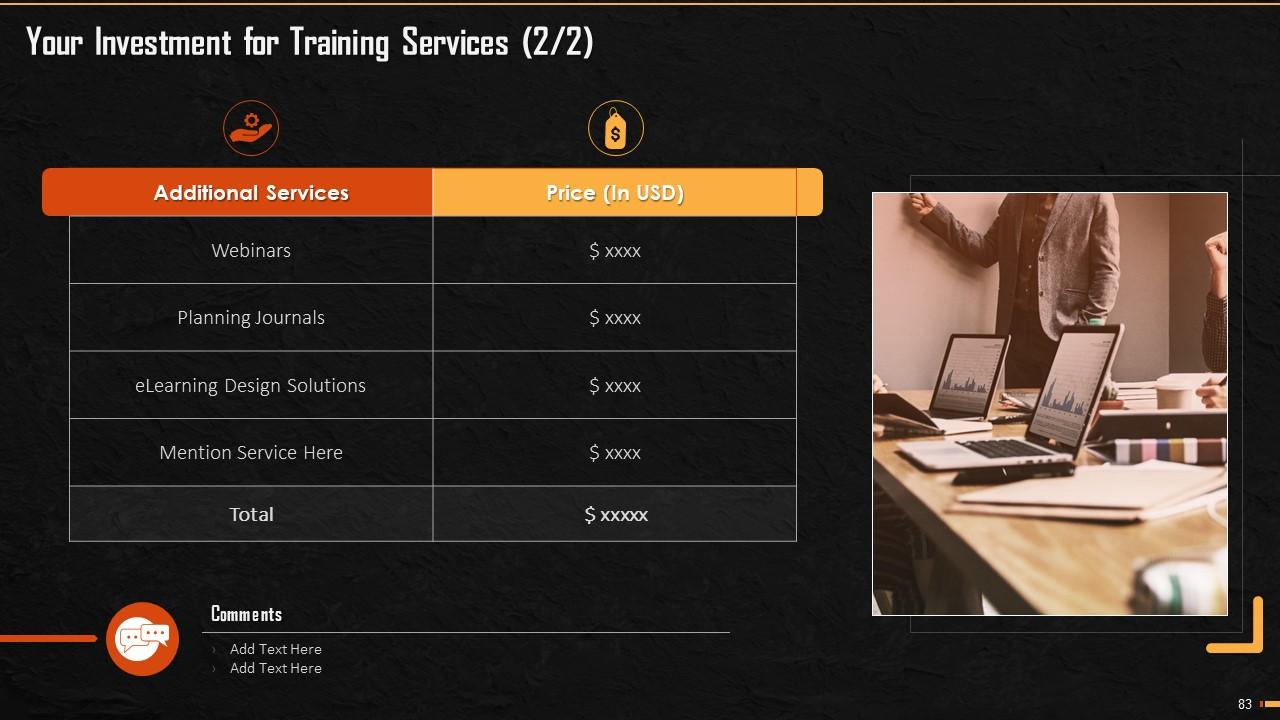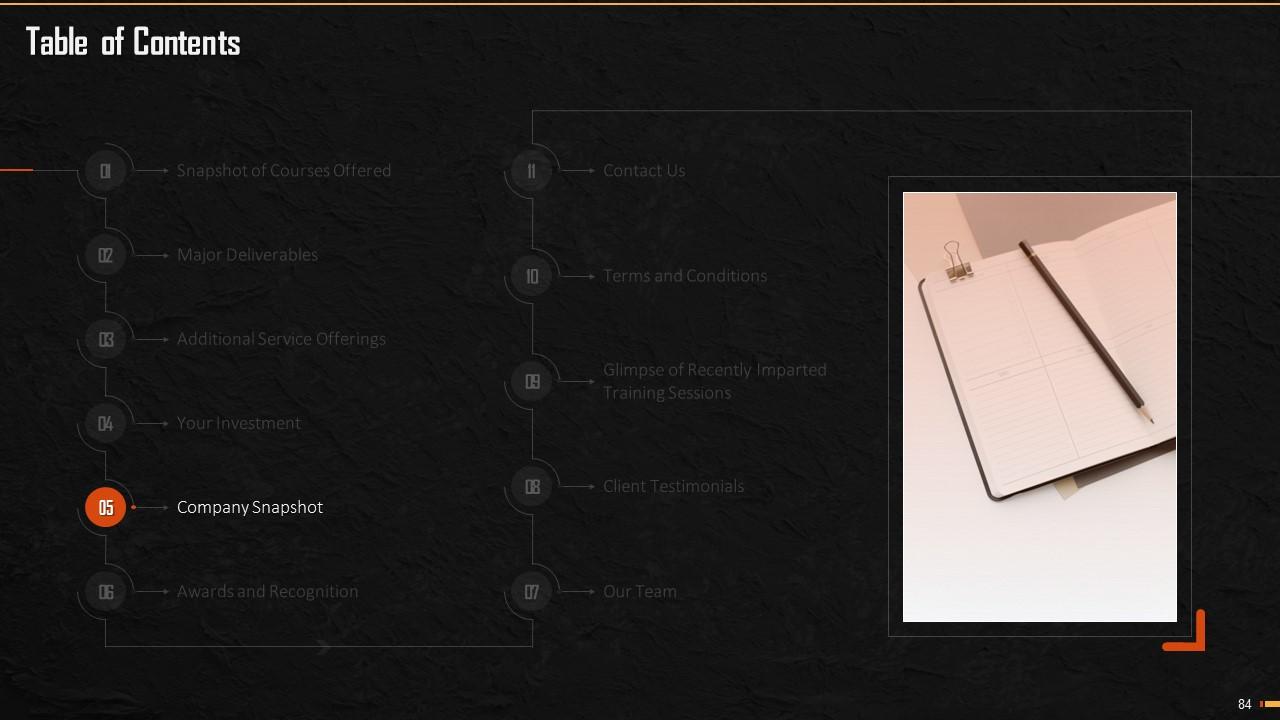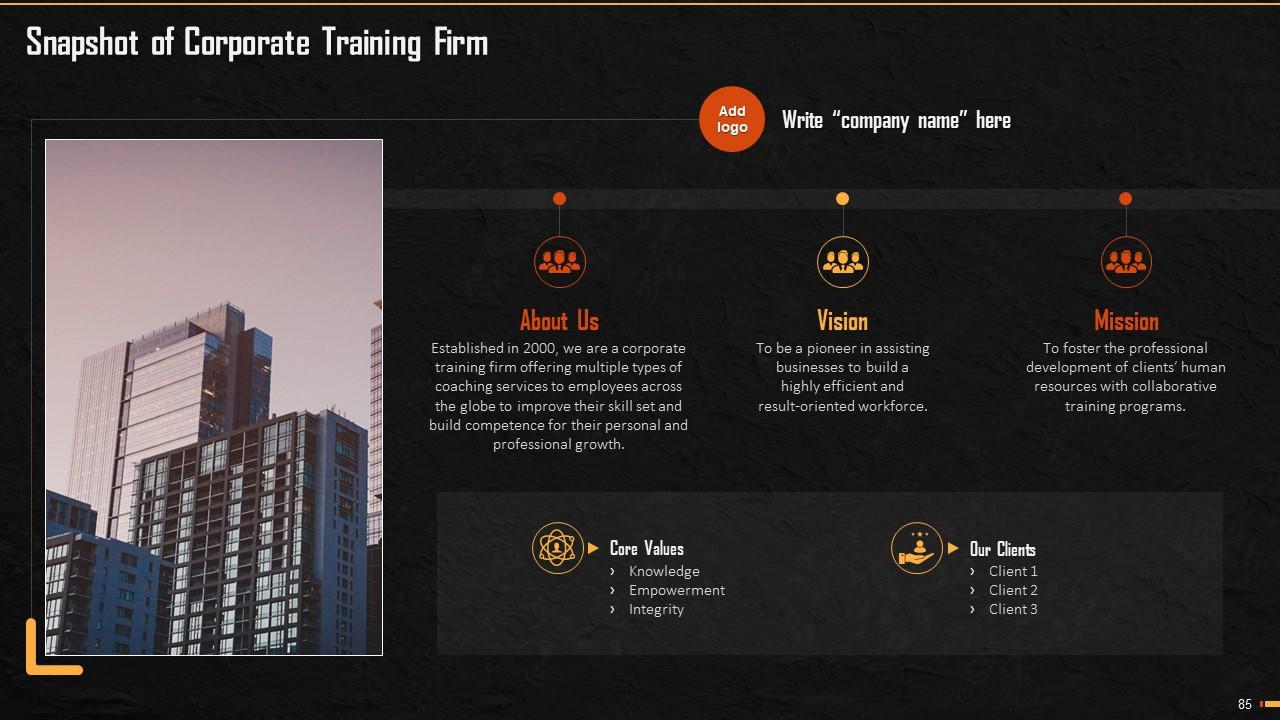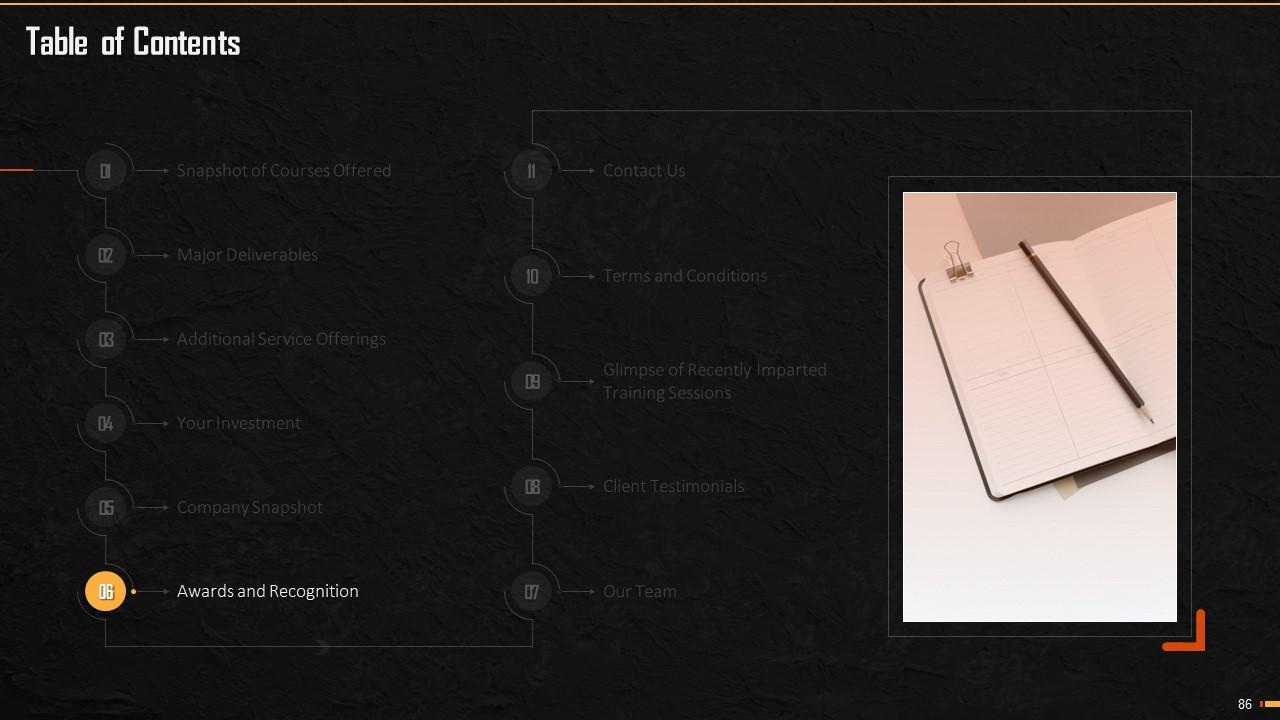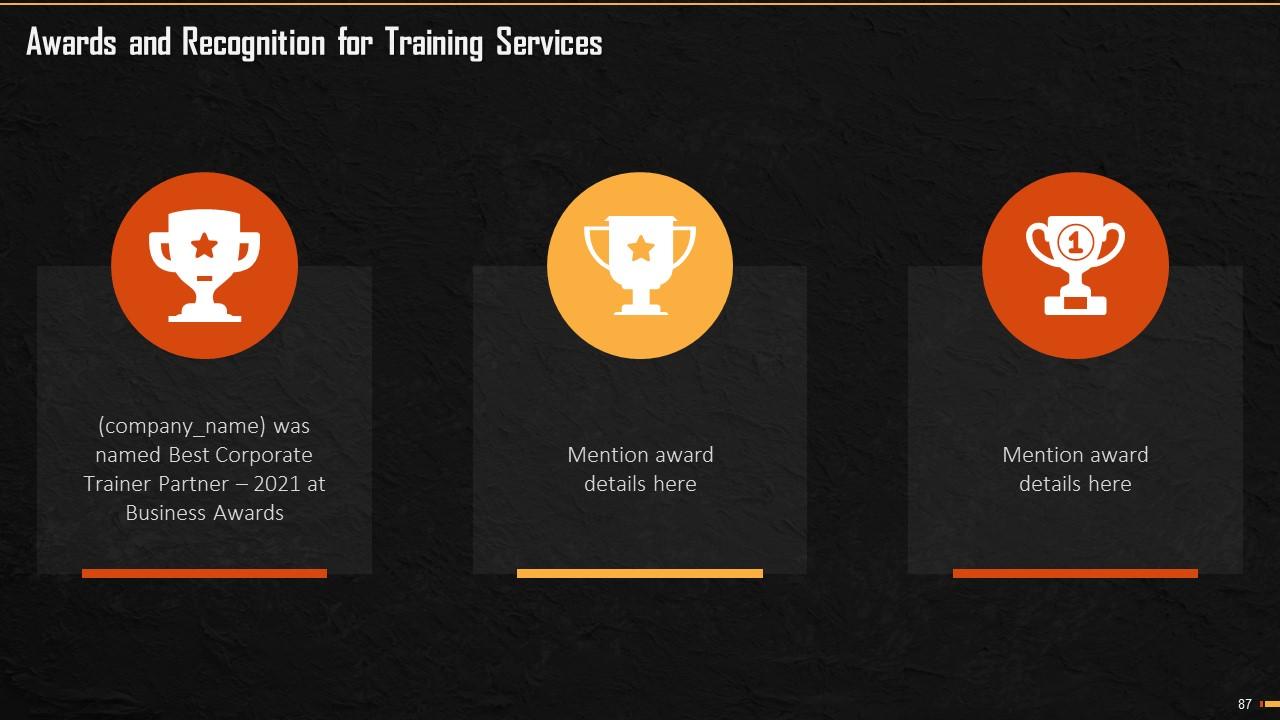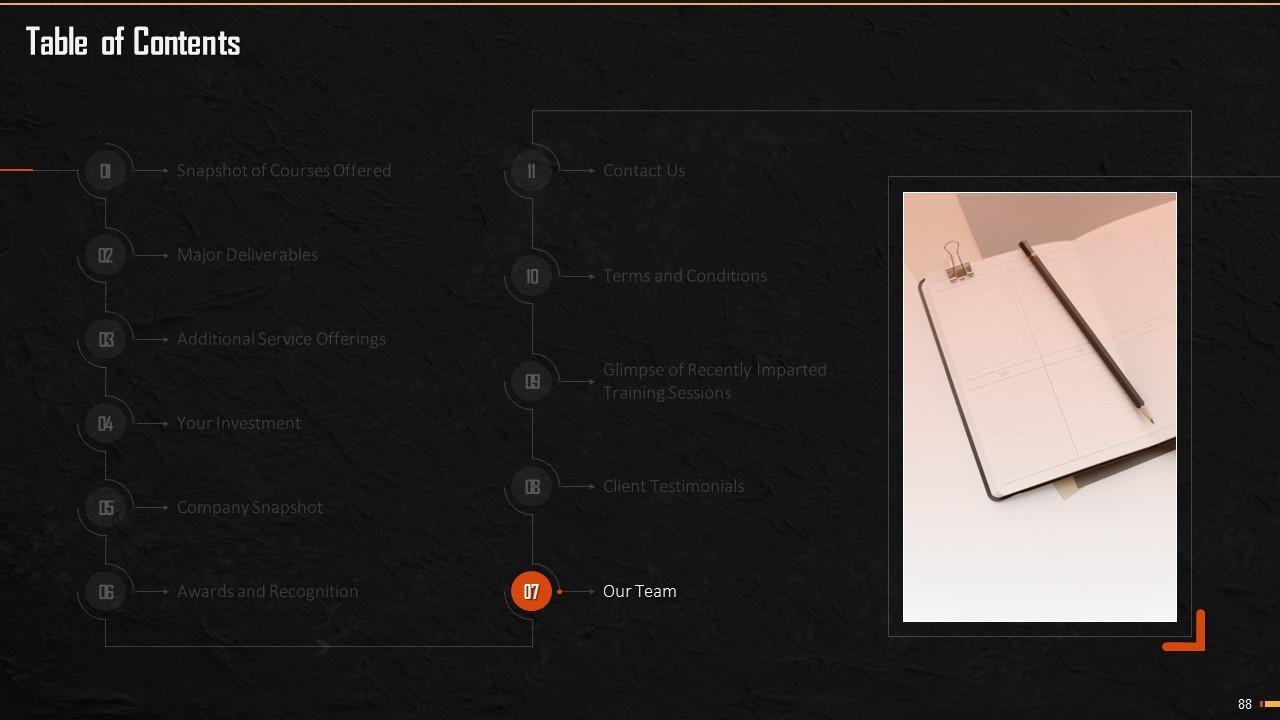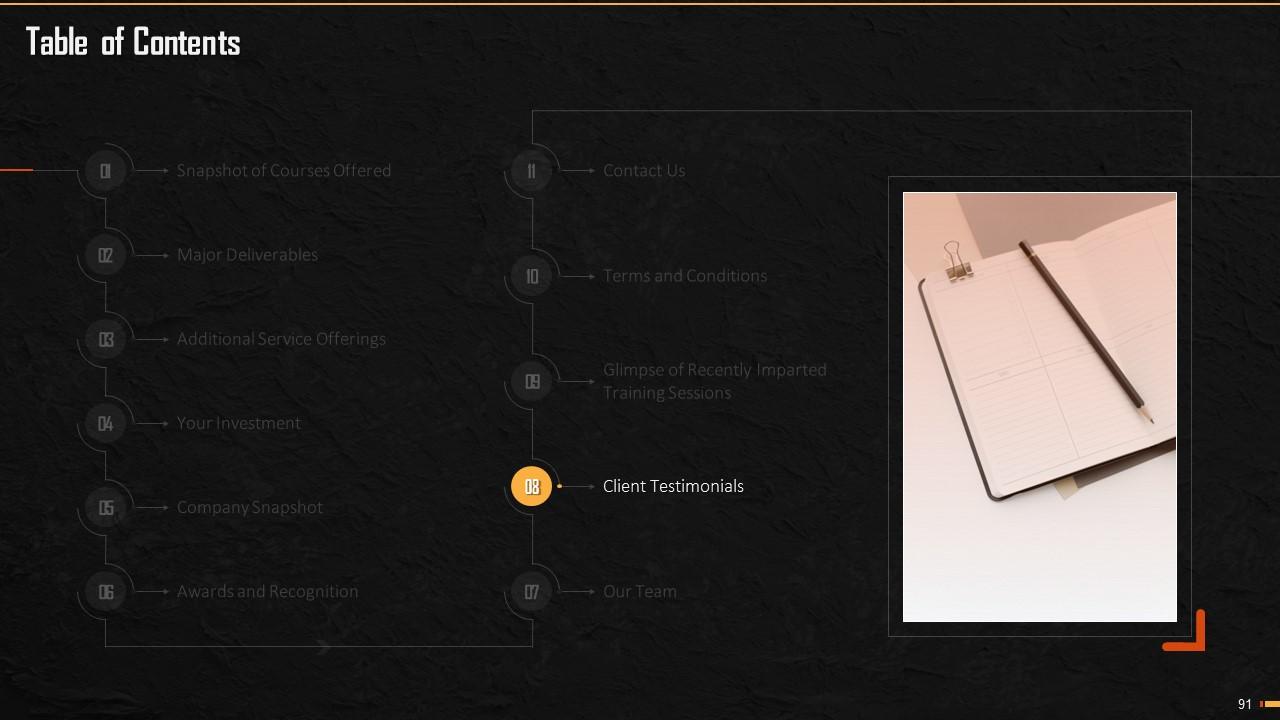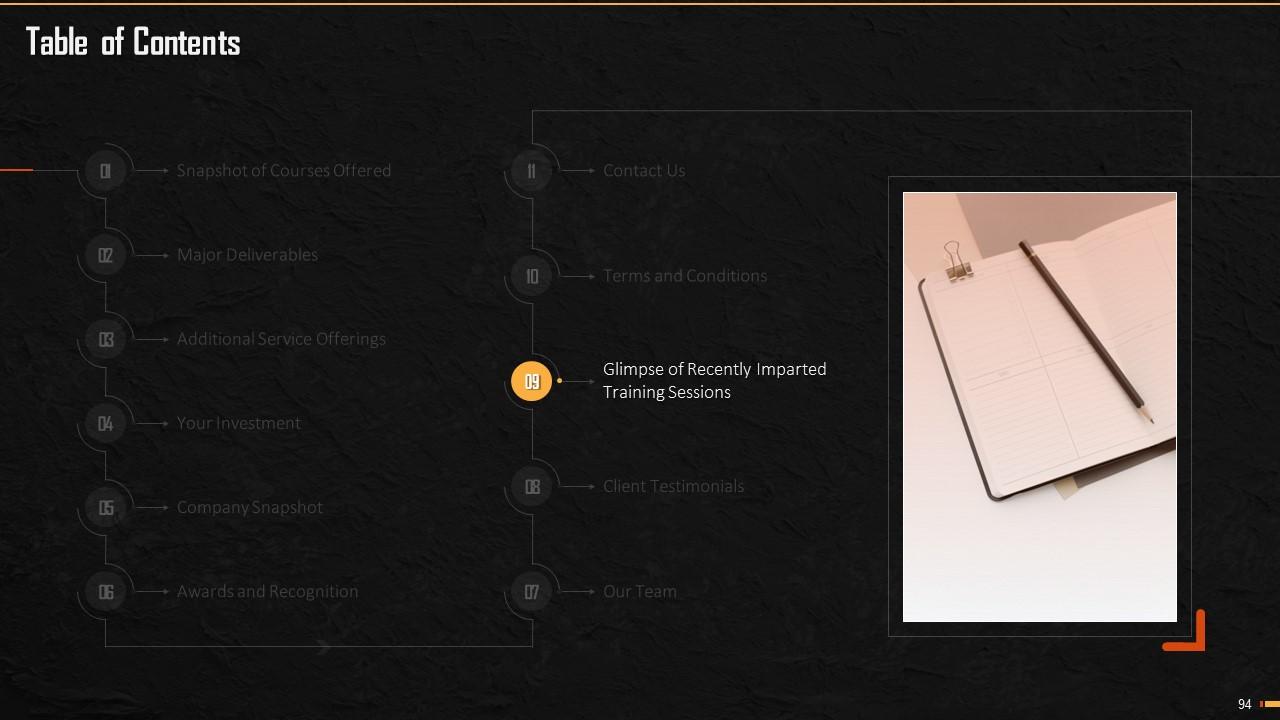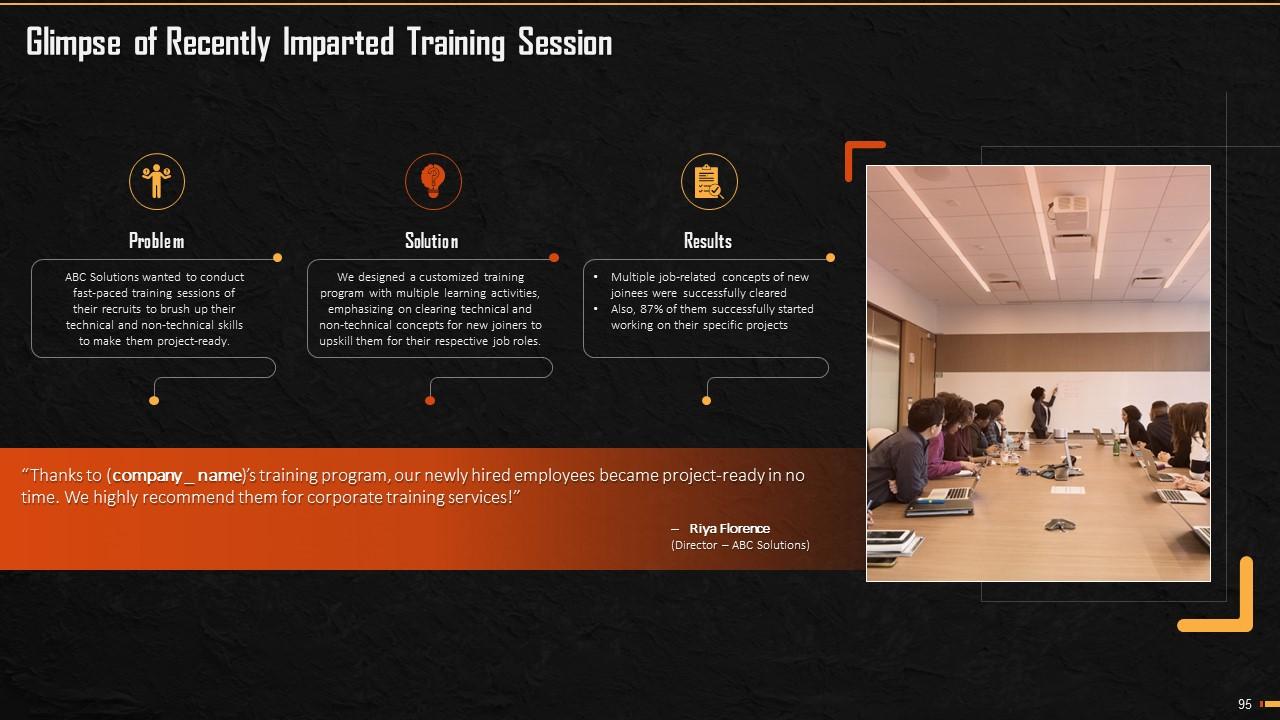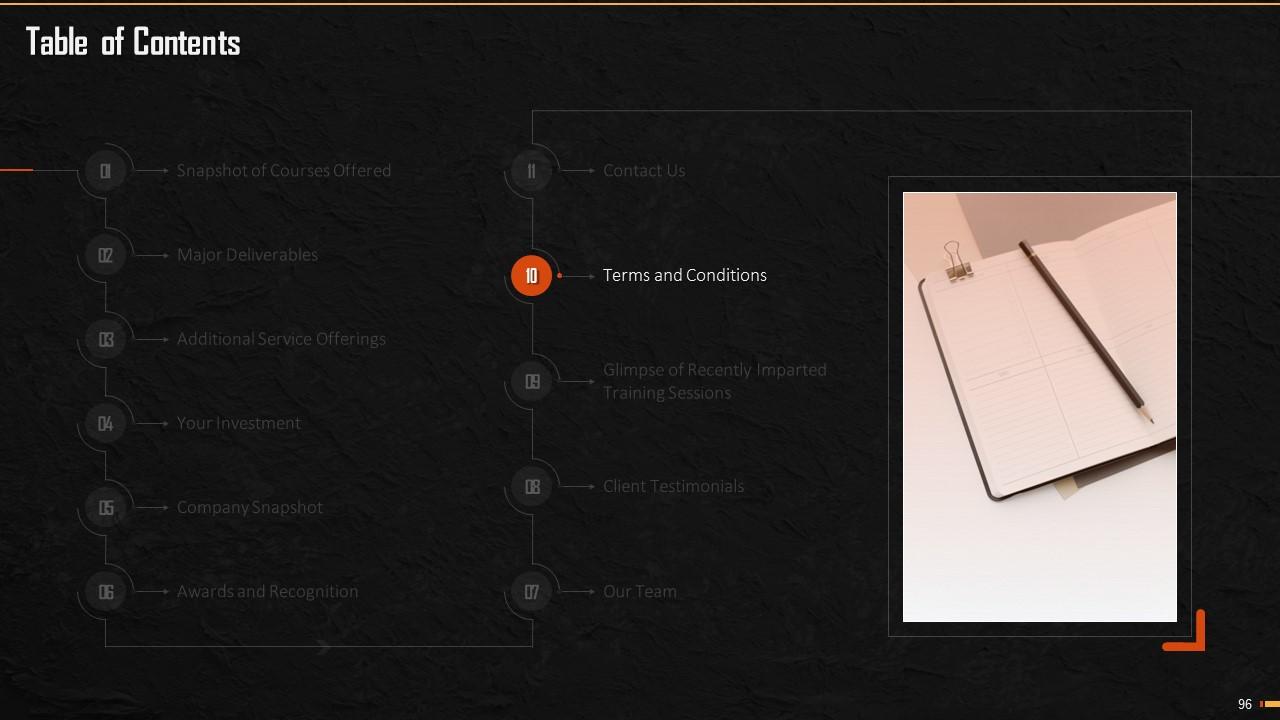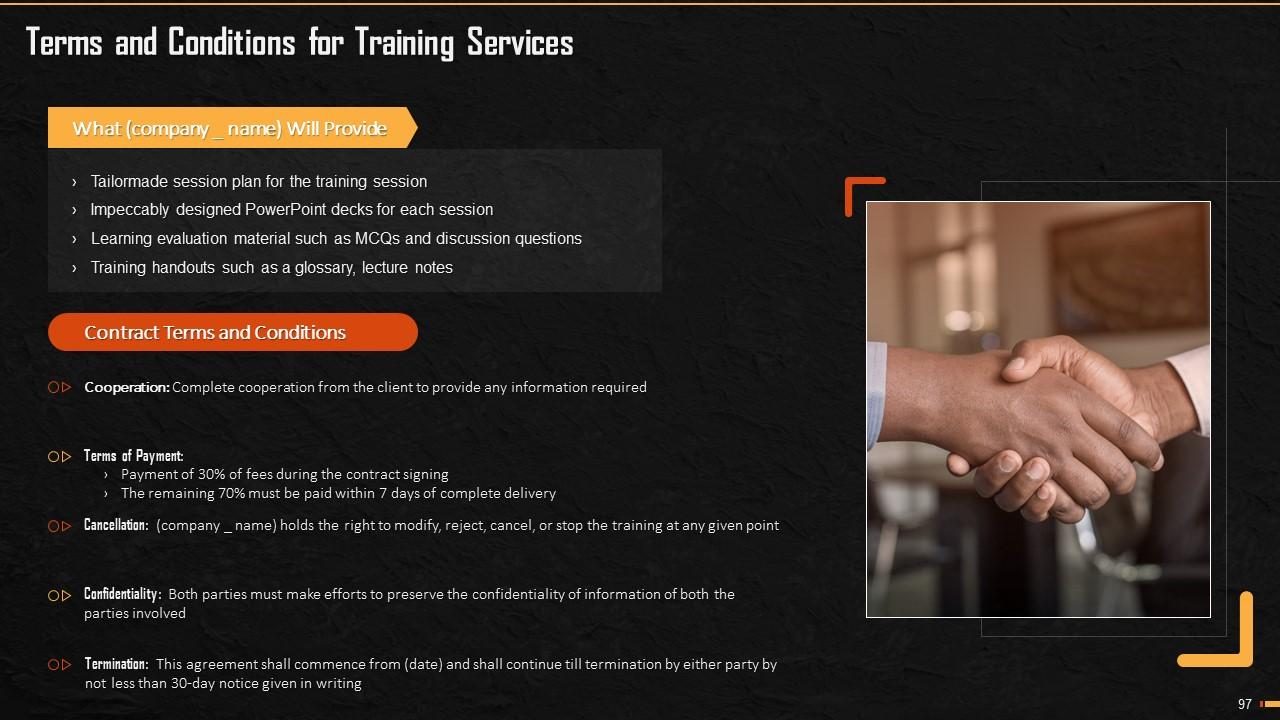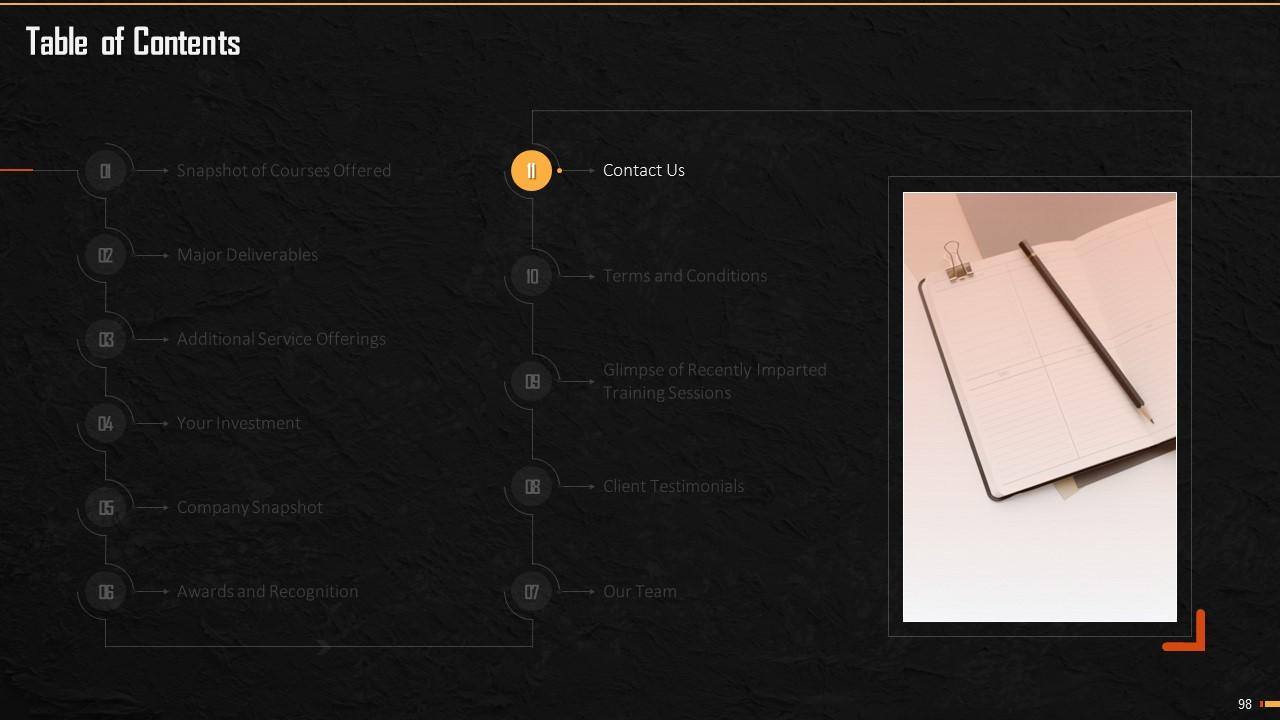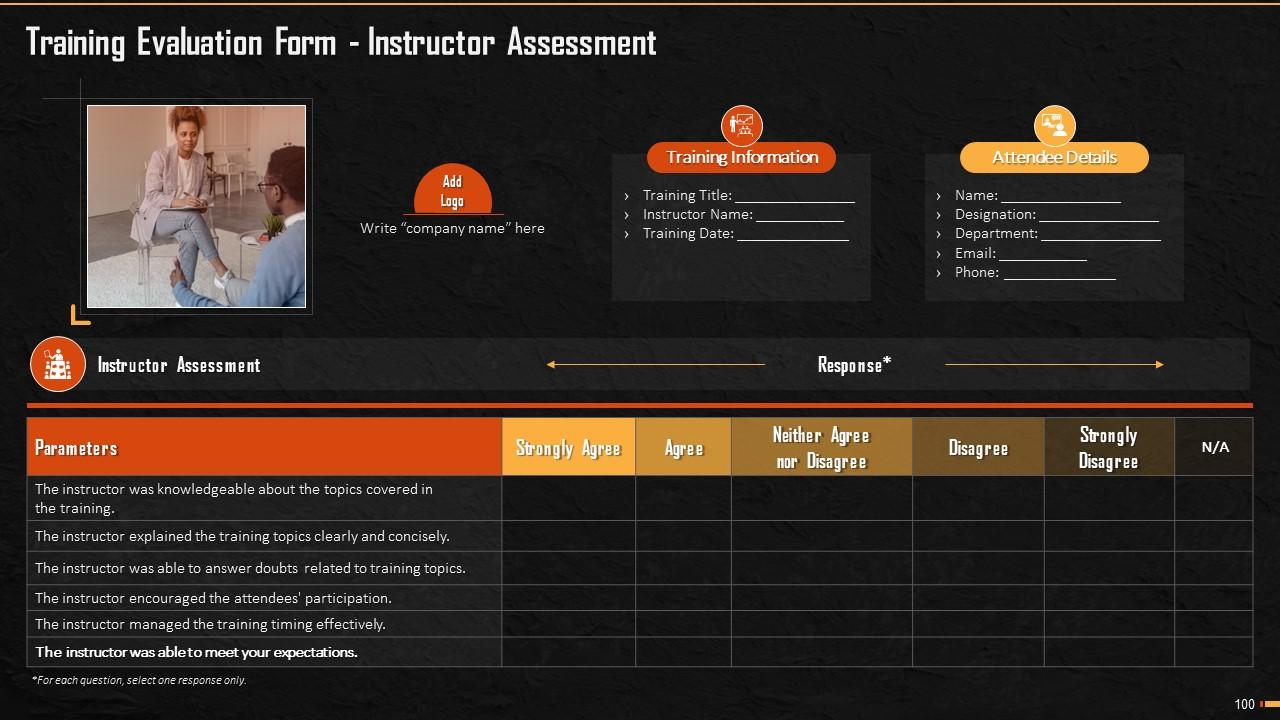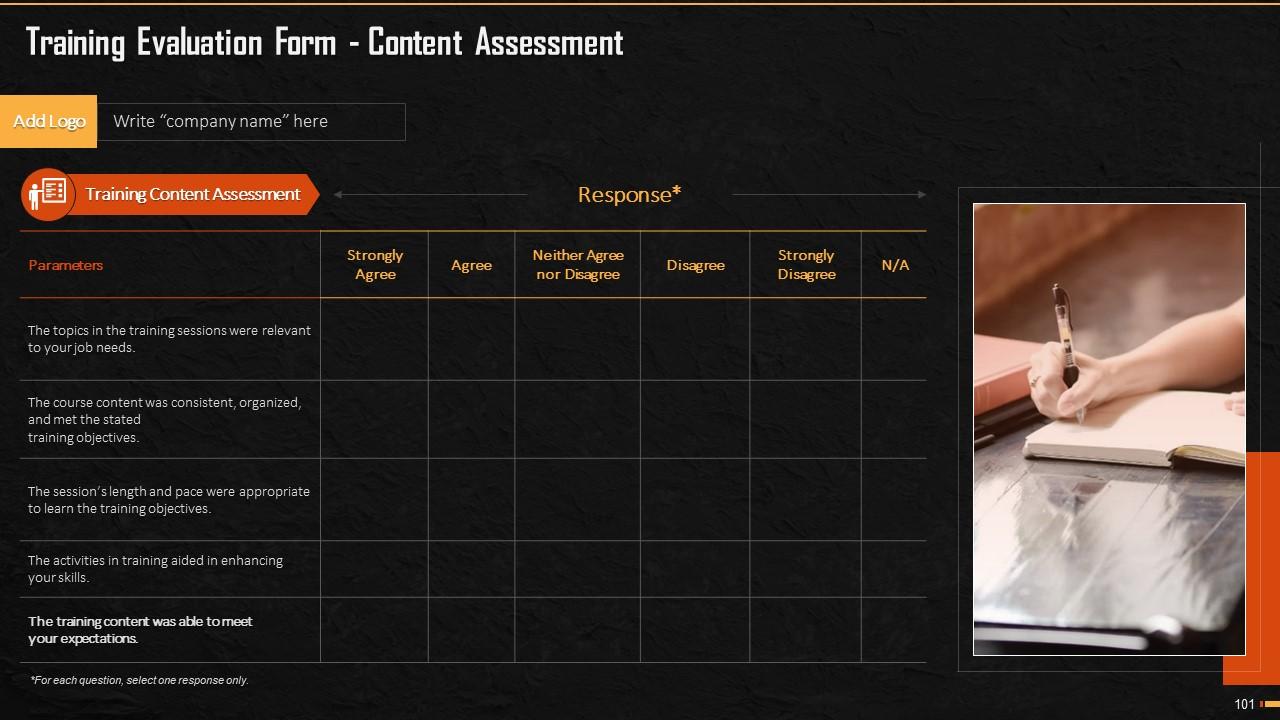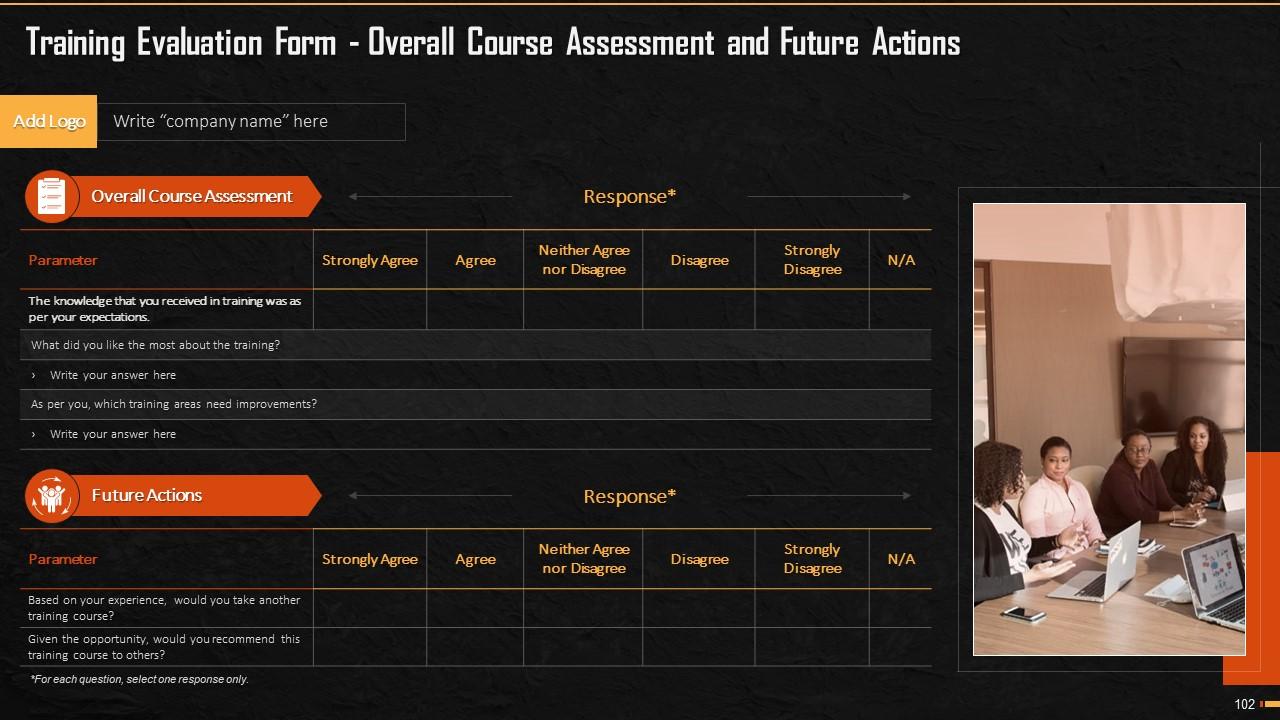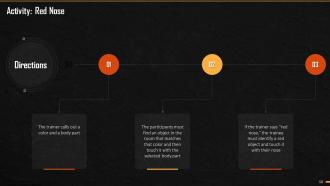Understanding Procrastination And Strategies To Deal With IT Training Ppt
This training module on Understanding Procrastination and Strategies to Deal with It comprehensively covers the concept of procrastination and its dreadful effects, which are missing opportunities, not meeting goals, losing precious time, ruining a career, low self-esteem, making poor decisions, and damage to reputation. It discusses why individuals procrastinate, the procrastination cycle, and procrastinator types which are Worrier, Perfectionist, Over-Doer, Crisis Maker, Dreamer, and Defier. It also contains techniques to overcome procrastination make a list, deal with your fear, break tasks into small parts, eliminate distractions, try challenging tasks, set deadlines, take regular breaks, figure out your most productive time, and reward yourself. It contains key takeaways, exercises, and discussion questions related to the topic. The deck has PPT slides on about us, vision, mission, goal, 30-60-90 days plan, timeline, roadmap, and training completion certificate. It contains energizer activities to engage the coaching session audience. It also includes a client proposal and assessment form for training evaluation.
This training module on Understanding Procrastination and Strategies to Deal with It comprehensively covers the concept of ..
- Google Slides is a new FREE Presentation software from Google.
- All our content is 100% compatible with Google Slides.
- Just download our designs, and upload them to Google Slides and they will work automatically.
- Amaze your audience with SlideTeam and Google Slides.
-
Want Changes to This PPT Slide? Check out our Presentation Design Services
- WideScreen Aspect ratio is becoming a very popular format. When you download this product, the downloaded ZIP will contain this product in both standard and widescreen format.
-

- Some older products that we have may only be in standard format, but they can easily be converted to widescreen.
- To do this, please open the SlideTeam product in Powerpoint, and go to
- Design ( On the top bar) -> Page Setup -> and select "On-screen Show (16:9)” in the drop down for "Slides Sized for".
- The slide or theme will change to widescreen, and all graphics will adjust automatically. You can similarly convert our content to any other desired screen aspect ratio.
Compatible With Google Slides

Get This In WideScreen
You must be logged in to download this presentation.
PowerPoint presentation slides
Presenting Training Deck on Understanding Procrastination and Strategies to Deal with IT. This deck comprises of 102 slides. Each slide is well crafted and designed by our PowerPoint experts. This PPT presentation is thoroughly researched by the experts and every slide consists of an appropriate content. All slides are customizable. You can add or delete the content as per your need. Not just this, you can also make the required changes in the charts and graphs. Download this professionally designed business presentation, add your content and present it with confidence.
People who downloaded this PowerPoint presentation also viewed the following :
Content of this Powerpoint Presentation
Slide 4
This slide illustrates a procrastination test that trainees have to take. This test is based on a three-point scale that is Not Me, Somewhat Like Me, and Like Me.
Instructor’s Notes:
- The trainees will answer the questions mentioned above on a three-point scale
- They will award themselves 0 (zero) if it falls under the category 'Not Me', 1 (one) if it is 'Somewhat Like Me', and 2 (two) if it is 'Like Me'. In the end, trainees will total the score, i.e., a total of 'Somewhat Like Me' and 'Like Me.’
- This test will help in measuring the procrastination tendencies, procrastination hotspots
- For example, if a trainee scores less than 5, that will be considered a usual case, but in case they score more than 10, then a trainee will be required to work on winning over his/her tendency to procrastinate
Slide 6
This slide mentions the meaning of procrastination. It says that procrastination refers to putting off or delaying a task till another day or time. It is done because the tasks are either unpleasant or boring.
Slide 7
This slide mentions the dreadful effects of procrastination. These are Missing wonderful
Opportunities, not meeting goals, losing precious time, ruining a career, having low self-esteem, making poor decisions, and damaging reputation.
Slide 8
This slide illustrates the diagram explaining how procrastinators convince or argue when called upon to explain their course of action of behavior. The trainer can use this if they want to add humor to the session.
Slide 9
This slide explains Missing wonderful opportunities as a dreadful effect of procrastination. It says that some opportunities come only once, and there are chances you may never get a second chance. Individuals do not realize that the chance they are getting can be life-changing, and they unintentionally miss out, only to be deeply regretful for the rest of their lives.
Slide 10
This slide explains not meeting goals as a dreadful effect of procrastination. The goals are generally set with a supporting motive yet sometimes cannot be achieved because of procrastination. This can cause frustration, disappointment, and decreased motivation levels which can further reduce the possibility to better your life, and the consequences, very often, are missed opportunities.
Slide 11
This slide explains losing precious time as a dreadful effect of Procrastination. The worst part of Procrastination is realizing that you cannot turn back time and grab the wasted opportunities. This leads to helplessness and regret. A person starts feeling frustrated, with the knowledge that he/she could have been in such comfortable position just by better time management and controlling the urge to procrastinate.
Slide 12
This slide explains that ruining a career is one of the dreadful effects of Procrastination. Hard work directly impacts the work-life and productivity of the person. It is the same with procrastination. Procrastination can prevent people from meeting deadlines and fulfilling potential, leading to a slower career growth, delayed promotions, etc.
Slide 13
This slide explains low self-esteem as a dreadful effect of Procrastination. Procrastination can lead to low self-esteem. It makes us feel that either we are not capable of performing a task or we cannot achieve it adequately. A person with low self-esteem feels unworthy of success.
Slide 14
This slide explains making poor decisions as a dreadful effect of Procrastination. A person’s emotions heavily impact the decision-making power and procrastination increases negative emotions, and the individual ends up making poor decisions that are not suitable in the long run. It is always advisable to avoid making decisions at such a moment and wait for the right time to analyze your decisions from all aspects.
Slide 15
This slide explains damage to reputation as a dreadful effect of Procrastination. When an individual regularly delays tasks, their reputation gets damaged as nobody likes empty promises. People stop trusting them, relying on them, and offering them opportunities because they are worried about the task not being completed on time.
Slide 17
This slide explains the main causes of procrastination. A few of the reasons include Low self-esteem; comfort over effort; short-term over the long-term, Lack of clarity; the perfectionist; anxiety and depression, and deliberate procrastination.
Instructor’s Notes:
- Low Self-Esteem: When an individual feels like he/she is incapable of completing any task or does not have the required skills or knowledge for that particular task, it is a sign of low self-esteem. Low self-esteem develops a feeling of doubt in a person and makes them demotivated
- Comfort over Effort: An individual usually finds it hard to get out of their comfort zone and put in the effort required to focus on work. This leads to delaying work until the last moment and regretting the results. Procrastination can result from the fact that the task is challenging and requires extreme effort
- Short-term over the Long-term: When the short-term goals please you more than the long-term success, it is a sign of procrastination. An individual automatically starts moving toward things that offer short term happiness, even when it comes at the cost of our future goals
- Lack of Clarity: Lack of clarity can be due to the unorganized behavior of an individual. An unorganized lifestyle or behavior fosters a lack of clarity. It confuses the mind with multiple things, and the individual then finds it difficult to prioritize
- The Perfectionist: Perfectionists tend to procrastinate a lot. They prefer everything to be perfect and start feeling anxious when they feel that something they have done is nor perfect. Such people put off completing a task and delay it to make it a perfect one
- Anxiety and Depression: Anxiety and depression can make people inactive and restrict their ability to take timely relevant actions. It locks you up in a vicious cycle of guilt for not doing what was needed to be done
- Deliberate Procrastination: Some people survive and thrive under stressful situations. They can produce their best results only when put under pressure. In such a case, procrastination should not be considered a negative phenomenon; here people deliberately create stressful situations to produce the best results
Slide 18
This slide explains the concept of procrastination cycle. A procrastination cycle is a pattern/behavior that people repeatedly go through when they delay their tasks unnecessarily. It is mainly a situation where procrastinating for a particular reason increases the likelihood of procrastinating for the same reason again in the future.
Instructor’s Notes:
- Procrastination Cycle starts with an assigned task
- After a few days, a person starts feeling guilty about not completing tasks on time due to fear, anxiety, delay, avoidance, etc.
- As the deadline approaches, the individual panics due to missed goals and the consequences attached to it
- To avoid and overcome this feeling, they start making excuses for not completing the task on time. This is a never-ending process, as it begins again with a fresh task and continuous throughout life if not worked upon
Slide 19
This slide explains the procrastination cycle using an example of a procrastinating employee at a workplace. This is important to note as till one can conquer the cycle, and get some discipline into one’s life, procrastination will keep trapping individuals into a sub-par life.
Slide 20
This slide lists the six main types of procrastinators. These are The Worrier; The Perfectionist; The Over-Doer; The Crisis Maker, The Dreamer, and The Defier.
Slide 21
This slide explains ‘The Worrier’ category of procrastinators. This category of people do not start work because they think that they cannot do it. They fear success and feel that it is better not to do this task because of this self-nagging.
Slide 22
This slide explains ‘The Perfectionist’ category of procrastinators. This category of people do not even start work because they fear that the work will not be perfect and they will fail. Their definition of failure is ‘Not Perfect.’
Slide 23
This slide explains ‘The Over-Doer’ category of procrastinators. This category of people prefers multitasking and fail in effective prioritization of tasks. They fear their own imagined impossible standards
Slide 24
This slide explains ‘The Crisis Maker’ category of procrastinators. This category of people prefers working in stressful situations. They feel that they are best when under pressure.
Slide 25
This slide explains ‘The Dreamer’ category of procrastinators. Individuals in this category want everything in their lap without working hard. The problem with such people is that the thought of actually doing something or working hard frustrates them. They do not even work hard to fulfill their dreams.
Slide 26
This slide explains ‘The Defier’ category of procrastinators. Individuals in this category do not prefer doing unnecessary tasks. They get frustrated and angry on being assigned such tasks.
Slide 28
This slide lists techniques to overcome procrastination. A few of these include making a list; dealing with your fear; breaking tasks into parts; eliminating distractions; trying challenging tasks; setting deadlines; taking regular breaks; figuring out the most productive time in a day, and rewarding yourself.
Slide 29
This slide explains the significance of making a list as a technique to overcome procrastination. Individuals should start their day by creating a to-do list and putting a deadline against each task. They should then estimate the time required to complete these tasks and compare it with the time available. This will ensure that you do not fail to do or underestimate the task.
Slide 30
This slide explains the significance of dealing with fear as a technique to overcome procrastination. It says that fear contributes to Procrastination. It can involve a fear of making mistakes, fear of failure, etc. Challenging your fears is essential to overcome these. If you fear failure in life, it is crucial to realize that it is your self-handicapping that is keeping you away from your goals. Addressing your fear will help you get started and overcome difficulties to achieve success.
Slide 31
This slide explains the significance of breaking tasks into small parts as a technique to overcome procrastination. It says that when assigned a large project or big task, an individual should list it down and break it into small series of steps. Once you have created a detailed list of tasks to be completed, it becomes easy to accomplish the task, as the person can now start working on individual baby steps.
Slide 32
This slide explains the significance of eliminating distractions as a technique to overcome procrastination. It is hard to get any task accomplished when you keep switching your attention to what’s happening on social media, what’s on TV, what others are talking about, etc. Individuals should assign themselves a particular time during which they will turn off all the distractions like television, internet, social media, etc., and use that time to focus on the task at hand.
Slide 33
This slide explains the significance of trying challenging tasks as a technique to overcome procrastination. The more complex the tasks are, the more concentration and dedication it requires to complete that task. Trying more challenging tasks will make an individual dedicated and more energetic. Challenging tasks are the core of the growth mindset and encourage individuals to take risks and grow in life and career.
Slide 34
This slide explains the significance of setting deadlines as a technique to overcome procrastination. Tasks accompanied under deadline pressure help an individual focus and collaborate towards achieving a goal. Deadlines make delivery expectations clear and keep the complex and multistage tasks on track.
Slide 35
This slide explains the significance of taking regular breaks as a technique to overcome procrastination. Taking regular breaks from work can help sustain an individual’s attention at the workplace. Breaks allow individuals to relax, recharge themselves, boost energy, improve their memory, enhance creativity, etc, and eventually reduce stress levels.
Slide 36
This slide explains the significance of figuring out your most productive time as a technique to overcome procrastination. An individual should figure out the time in the day when they are most productive. Usually, people are most productive between 9 am and 12 pm. They should schedule the most critical tasks in their most productive time as it is the best time to handle analytical tasks that require focused, logical, and disciplined action.
Slide 37
This slide explains the significance of rewarding yourself as a technique to overcome procrastination. An individual should build a habit of rewarding themselves for their efforts. Even when one completes a tiny portion of a larger task, it is crucial to have such rewards in place to boost their confidence
Slide 38
This slide explains the Five-minute technique for overcoming procrastination. It is a cognitive behavioral therapy technique for procrastination. In this technique, an individual sets a goal of doing whatever you would otherwise avoid, but only for five minutes. After five minutes, you are free to stop, if you wish. Most people end up completing the task instead of stopping midway. This technique helps in overcoming procrastination and becoming more productive.
Slide 39
This slide explains steps to put the five-minute technique into action. The first of the three steps is to set a timer for five minutes, give you 100% in those five minutes, and after the time is over analyze how you feel. You’ll either feel so involved that you’ll be motivated to complete the task or be extremely irritated and stop it completely. More chances are that the person will overcome the hurdle of procrastination and complete the allotted task.
Slide 40
This slide mentions the productivity/anti-procrastination checklist for overcoming procrastination. Being religious in following these 10 points will change your life and unlock a series of possibilities.
Slide 41
This slide explains the activity that the trainer can conduct to explain the concept of Procrastination to the trainees.
Slide 42
This slide explains the activity the trainer must conduct to brief the trainees about Procrastination and how it can make a difference in their life.
Slide 43
This slide mentions the key takeaways from the session understanding procrastination and strategies to deal with it.
Slide 44
This slide mentions the discussion questions from the session understanding procrastination and strategies to deal with it. The trainer can use these questions to initiate discussion with the trainees. The learnings from the discussion can be life-changing when assimilated with the right context.
Slide 56 to 71
These slides depict energizer activities to engage the audience of the training session.
Slide 72 to 99
These slides consist of a client training proposal highlighting what the company providing corporate training can accomplish for the client.
Slide 100 to 102
These slides highlight the training evaluation form for instructor, content, and course assessment.
Understanding Procrastination And Strategies To Deal With IT Training Ppt with all 107 slides:
Use our Understanding Procrastination And Strategies To Deal With IT Training Ppt to effectively help you save your valuable time. They are readymade to fit into any presentation structure.
-
I have been using SlideTeam for the past six months. Very happy and satisfied!
-
World-class PowerPoint designs that are fully customizable!


